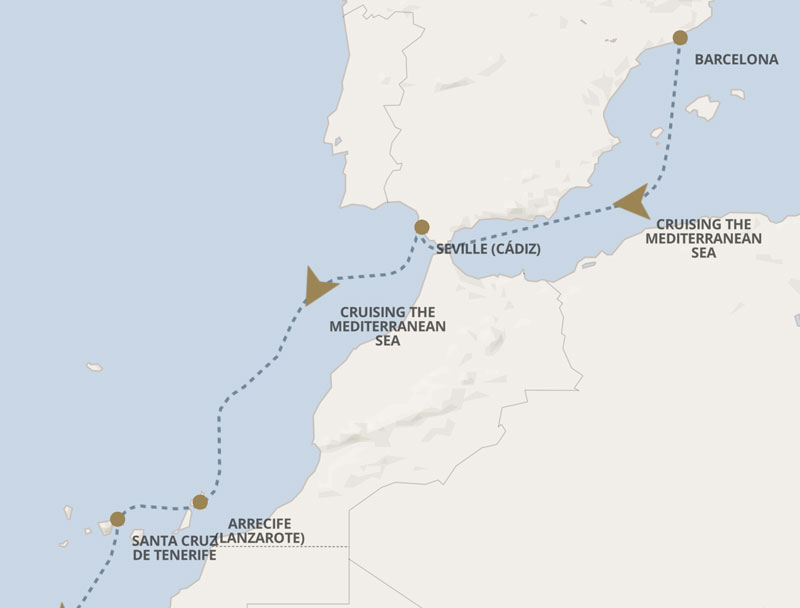
Barcelona to Cape Town
November 18 to December 13, 2023
Mike and Judy Henderson
In this installment we travel from Cardona to board the Regent ship in Barcelona. Then we'll sail some of the track shown in this next picture.

+++++++++++++++++++++++++++++++++++++++++
11/18/2023 (Saturday) I was up early (6:30am) this morning, while it was still dark, and I took this picture of Cardona from the window of our hotel room.
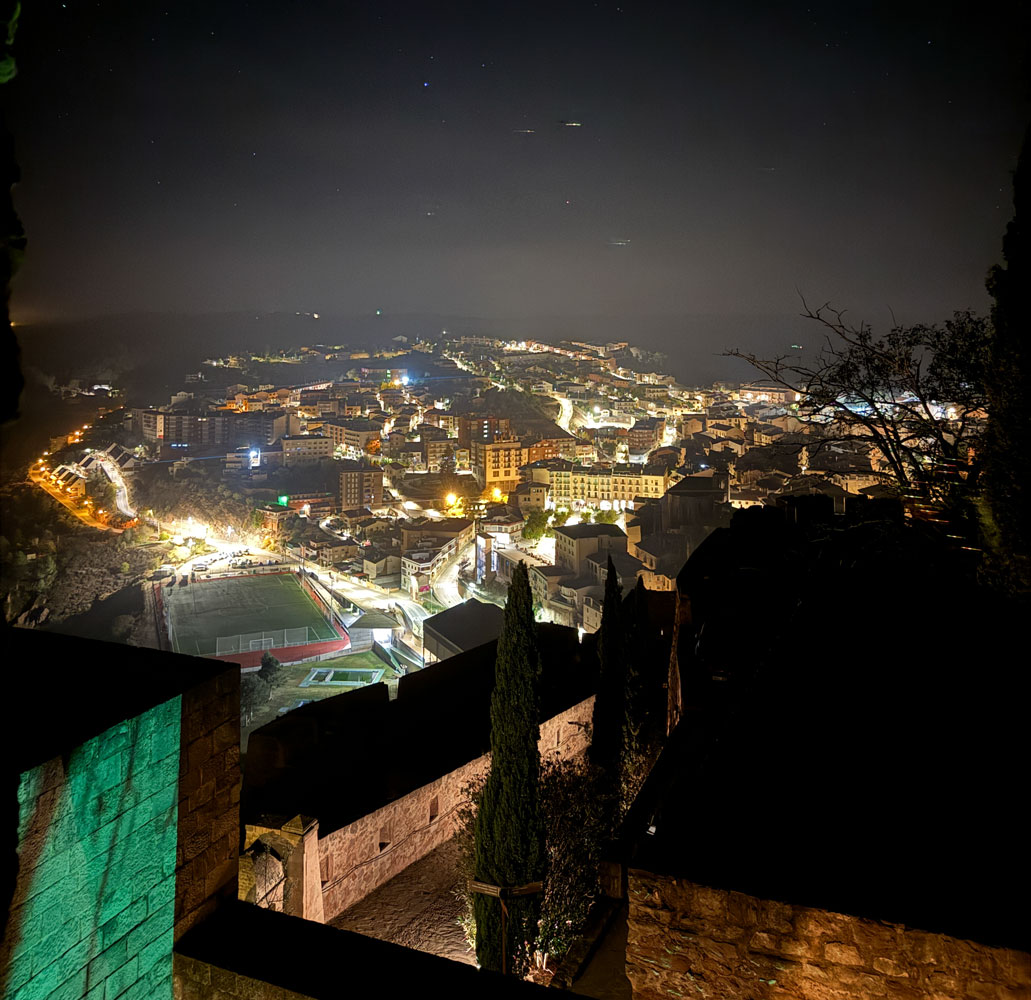
Breakfast didn't open until 9am on Saturday. We met the bus about 10:30 and departed for Barcelona about 10:45.
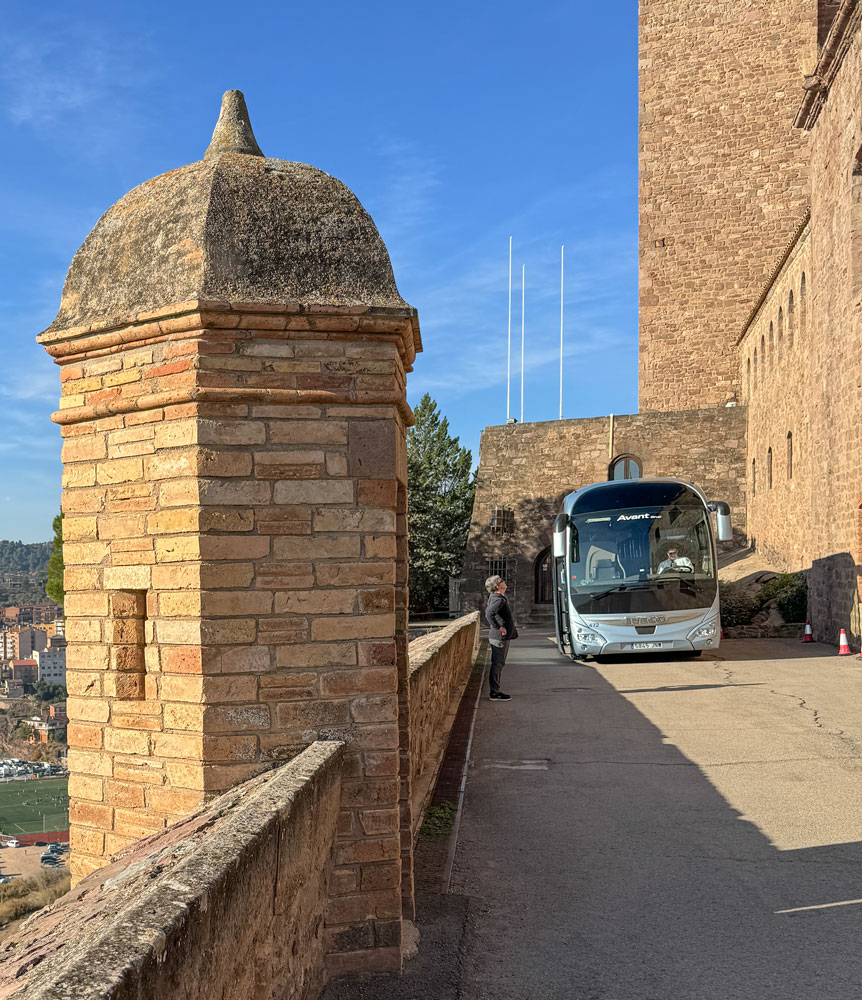
It was an uneventful drive - we arrived at the cruise ship terminal about noon. We got our first view of the Voyager through the windshield of the bus. While it's a fair-sized ship, it was small compared to a couple of other cruise ships at the port. One, an MSC ship, was huge.
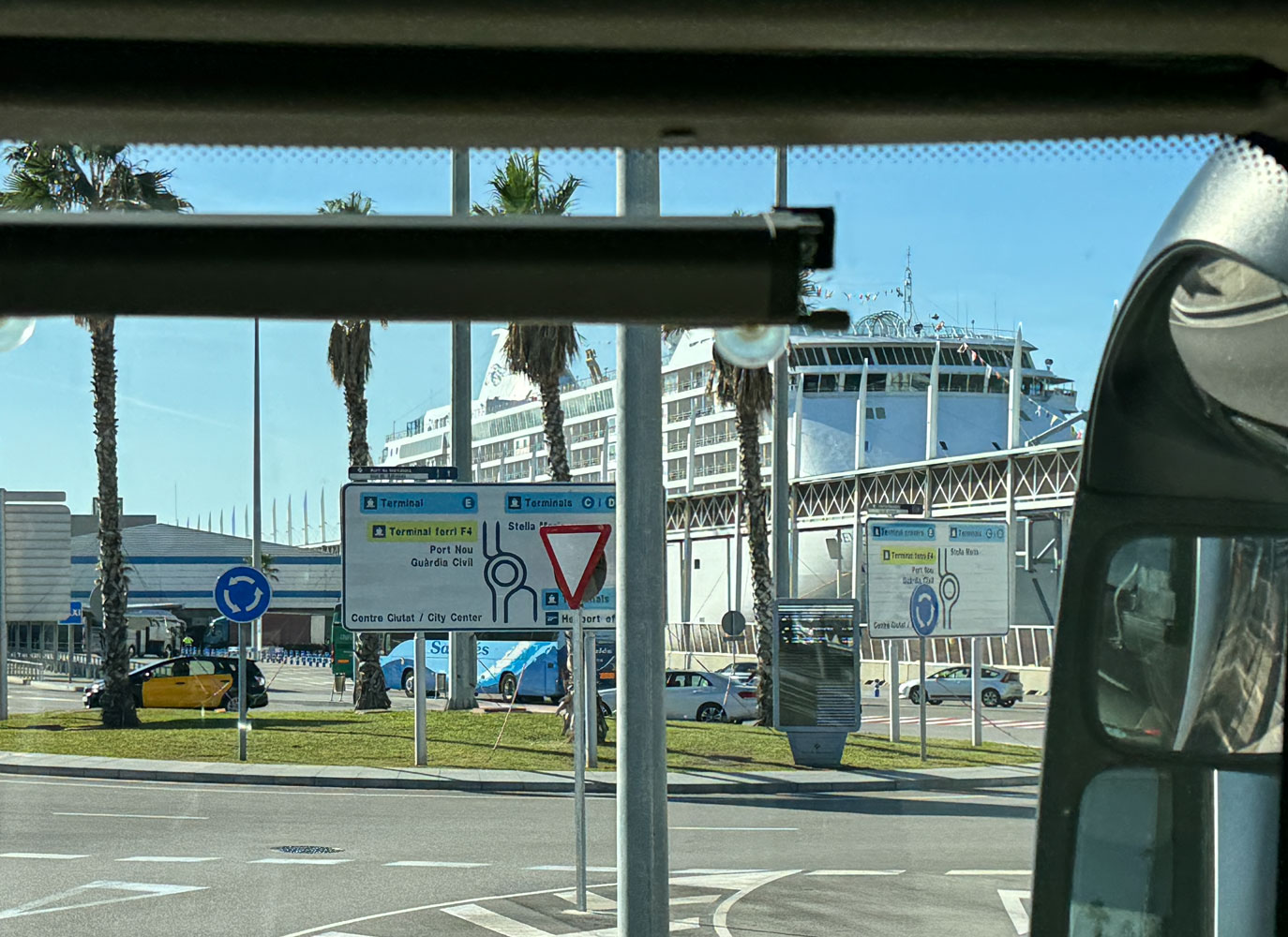
Regent has six ships, three new ones and three older ones. The Voyager is one of the older ones, having entered service in 2003 and refurbished in 2016. It has a capacity of 680 passengers.
Upon entering the terminal we went through a security check.
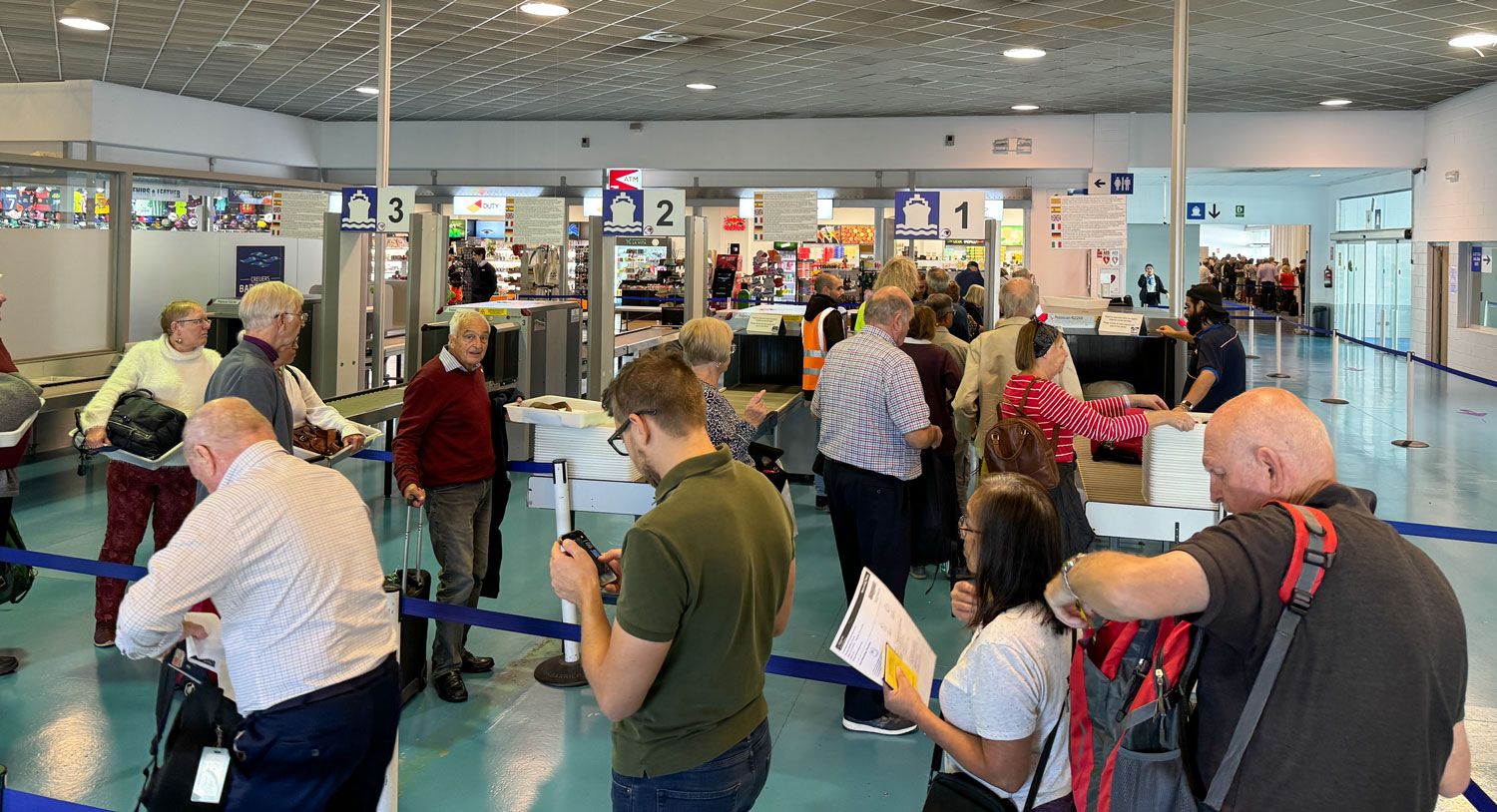
Then to an area where we presented our passports, COVID vaccination cards, and yellow fever vaccination record or waiver letter. The process moved reasonably quickly.
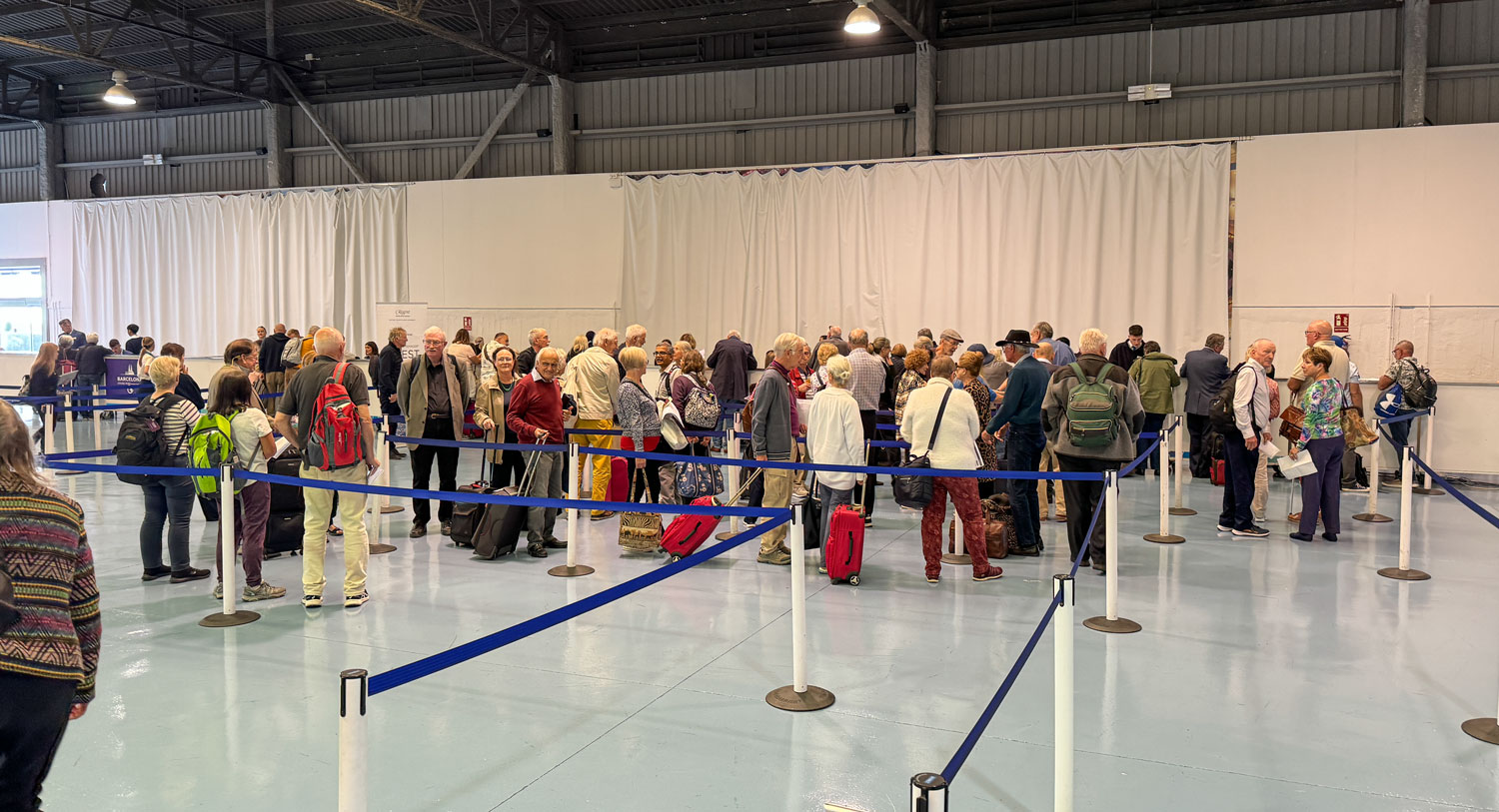
We received key cards for our stateroom and were free to board. Immediately after boarding we ran into our friends from San Francisco, Tim and Maria. While waiting for the crew to finish preparing our cabins, the four of us went to the pool area where the crew was serving a light lunch, and we caught up on news since we last met on a previous cruise.
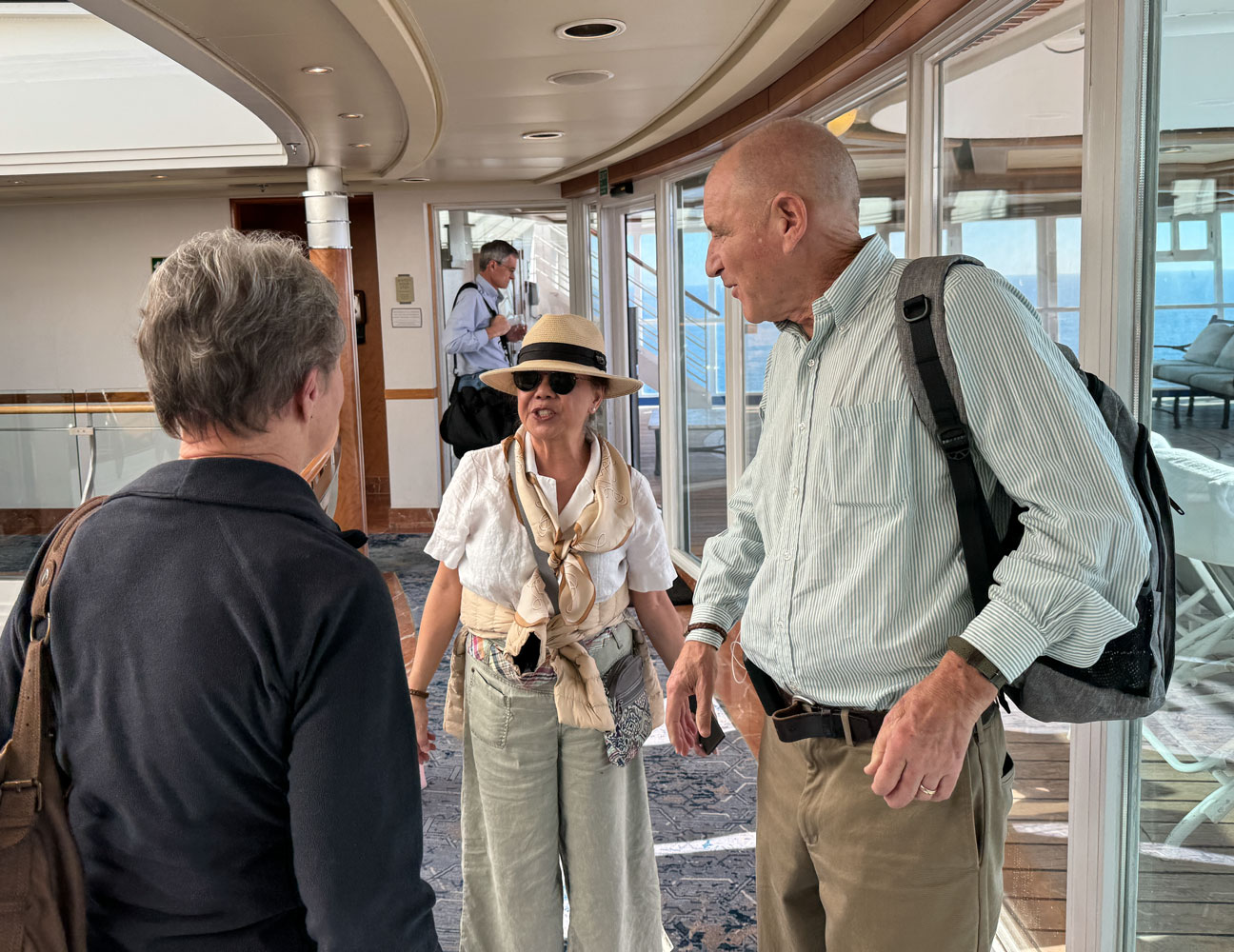
Eventually, rooms were ready and we went to our cabin, 819, a Penthouse B cabin. Our bags were outside the door, all except Judy's carry-on. Our cabin is very nice. It's arranged along the line of the ship, instead of facing outward, as is usual. It's all one room but is divided into two areas. Here's the sleeping area.
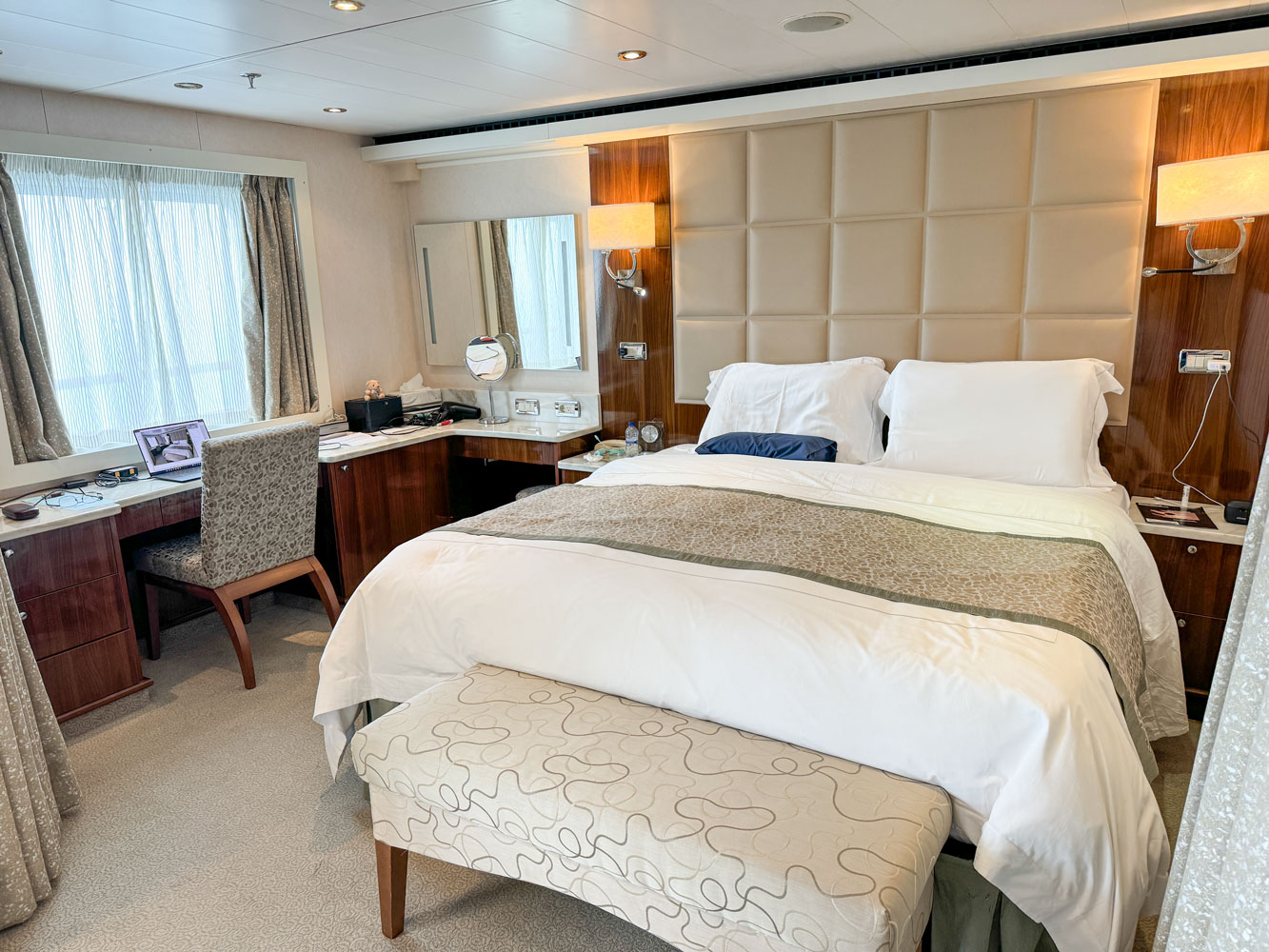
And the "sitting" area. A small balcony is accessed via a door on the right side of this picture (where the drapes are).
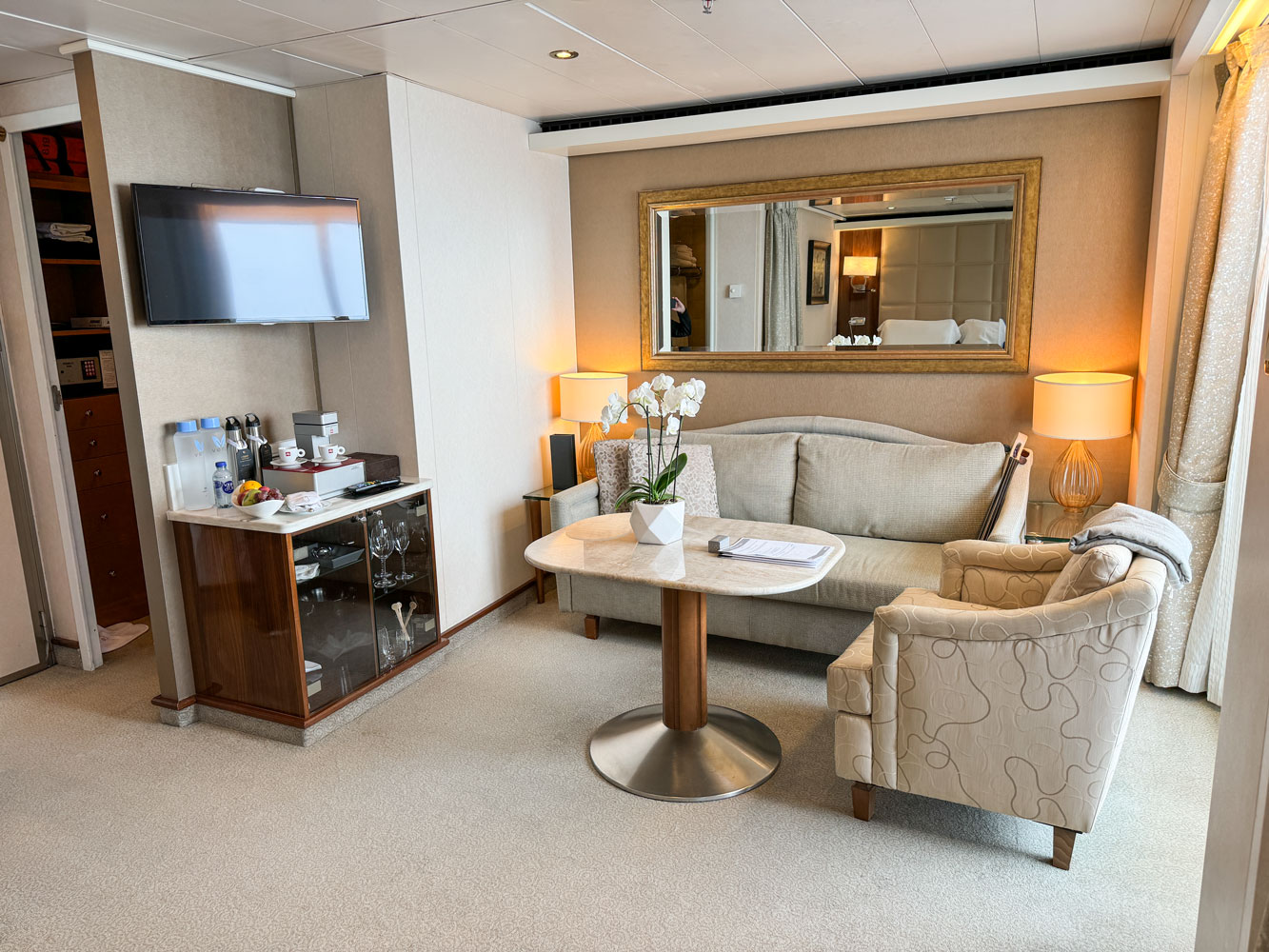
We have a fairly large walk-in closet. The bathroom is not as large as on the Splendor ship - it only has a single sink - but it has a tub and a small walk-in shower.
Our room attendant, Paul, came by to introduce himself and later we met his assistant, Aibecriz.
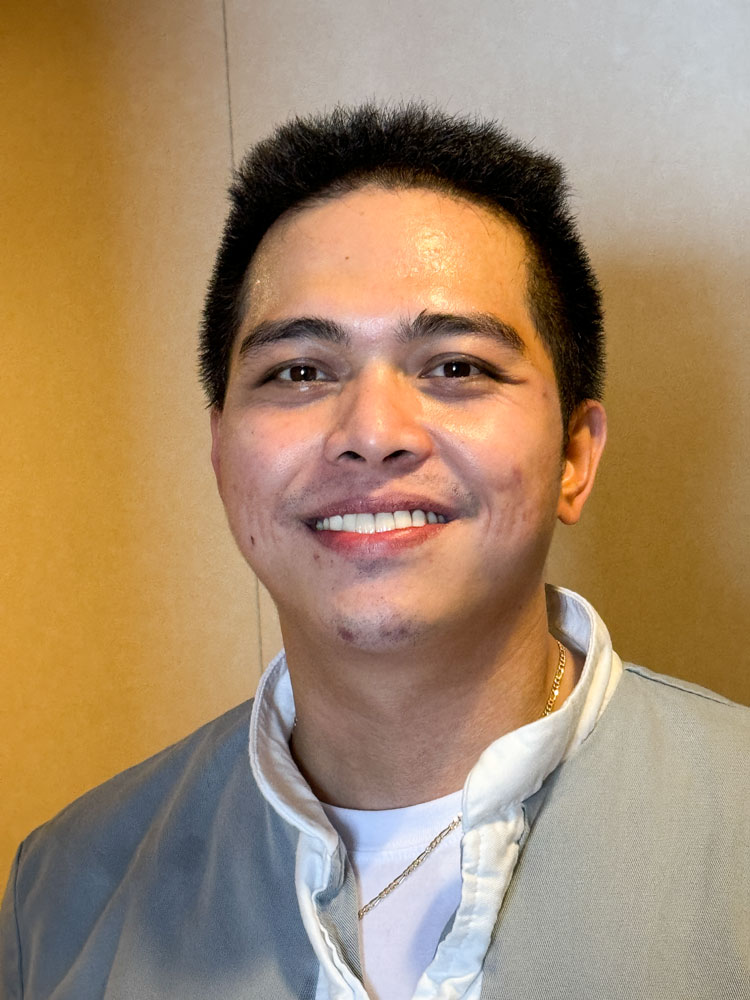

Later our butler, Roshan, came by to brief us on his services.
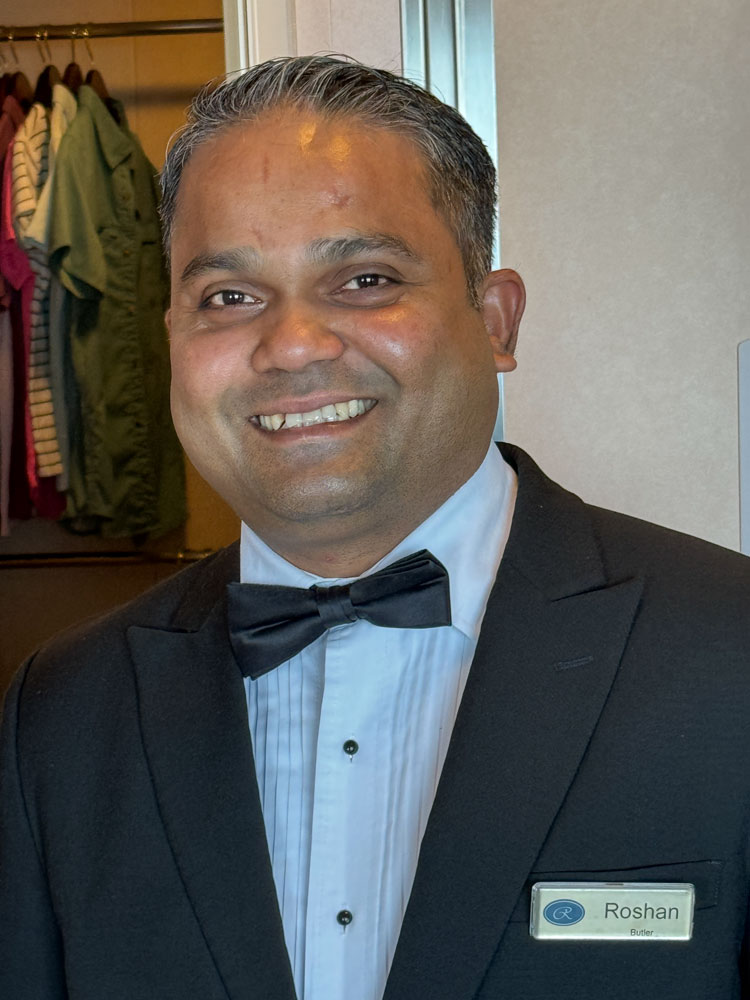
Eventually, Judy's carry-on arrived. While we have Air Tags in our checked bags, we did not get Air Tags for our carry on. I think we will for our next trip. It would have alleviated some of Judy's concern to know that the bag was on the ship.
We had dinner in the Compass Rose Restaurant with Eva and Richard, our friends from Villa Park. We were seated for dinner about 6:30pm and left the restaurant at 9pm. A leisurely dinner. The ship sailed at 7pm without fanfare.
That was the end of our day. Tomorrow is a sea day as we sail through the Strait of Gibraltar to Cadiz.
+++++++++++++++++++++++++++++++++++++++++
11/19/2023 (Sunday) We're not sleep-adjusted yet. Judy and I were up about 4am - just couldn't sleep any more.
It's nice that we have a sea day the first day. It allows us to rest and get adjusted to the ship. Most of the people on the ship did not take the pre-cruise tour so they may have arrived in Barcelona the day prior to embarkation.
We didn't do anything of interest during the day, but that evening was the Captain's Reception, and we had our picture taken with the captain.
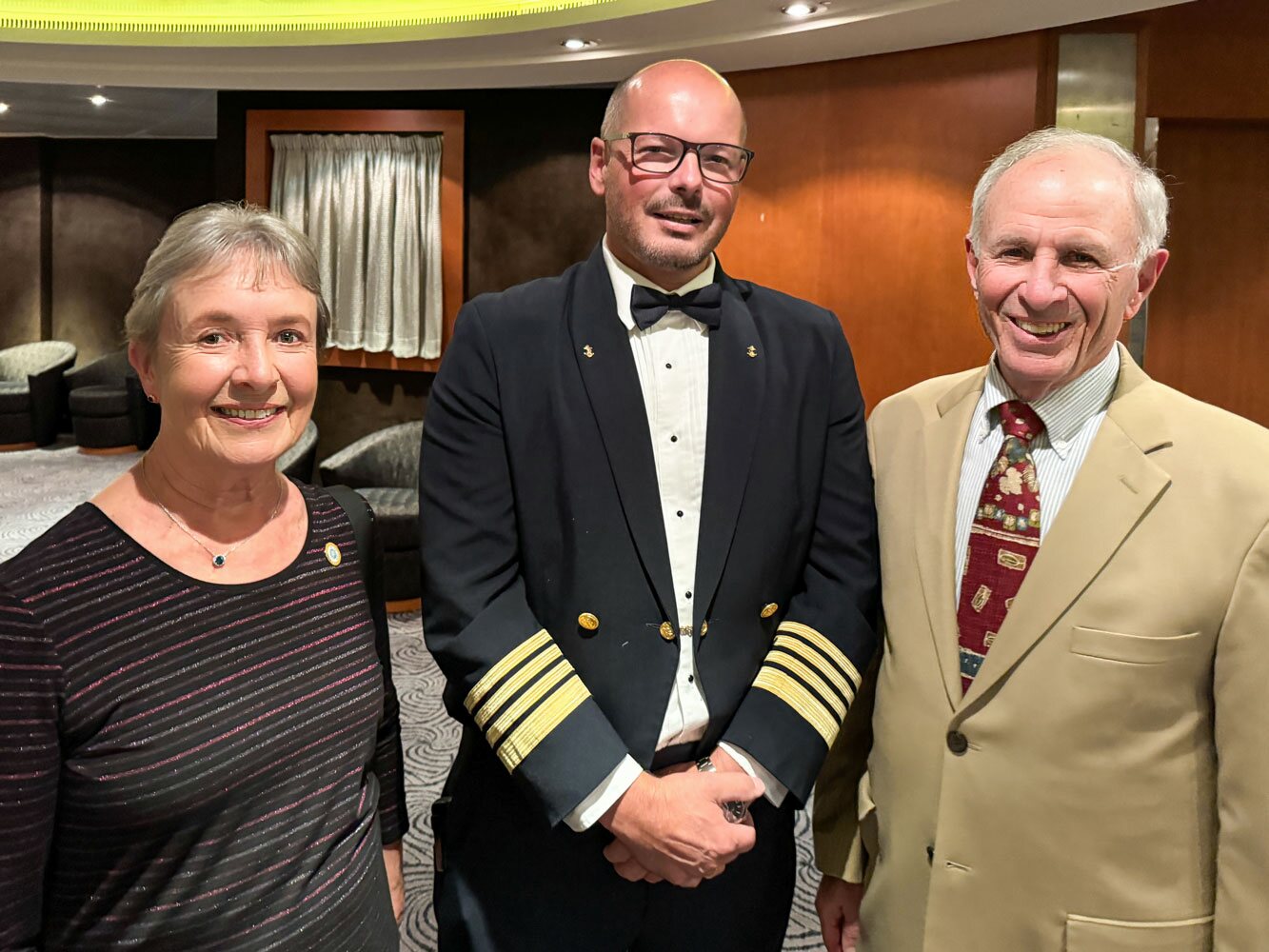
Here's the captain introducing his senior staff.
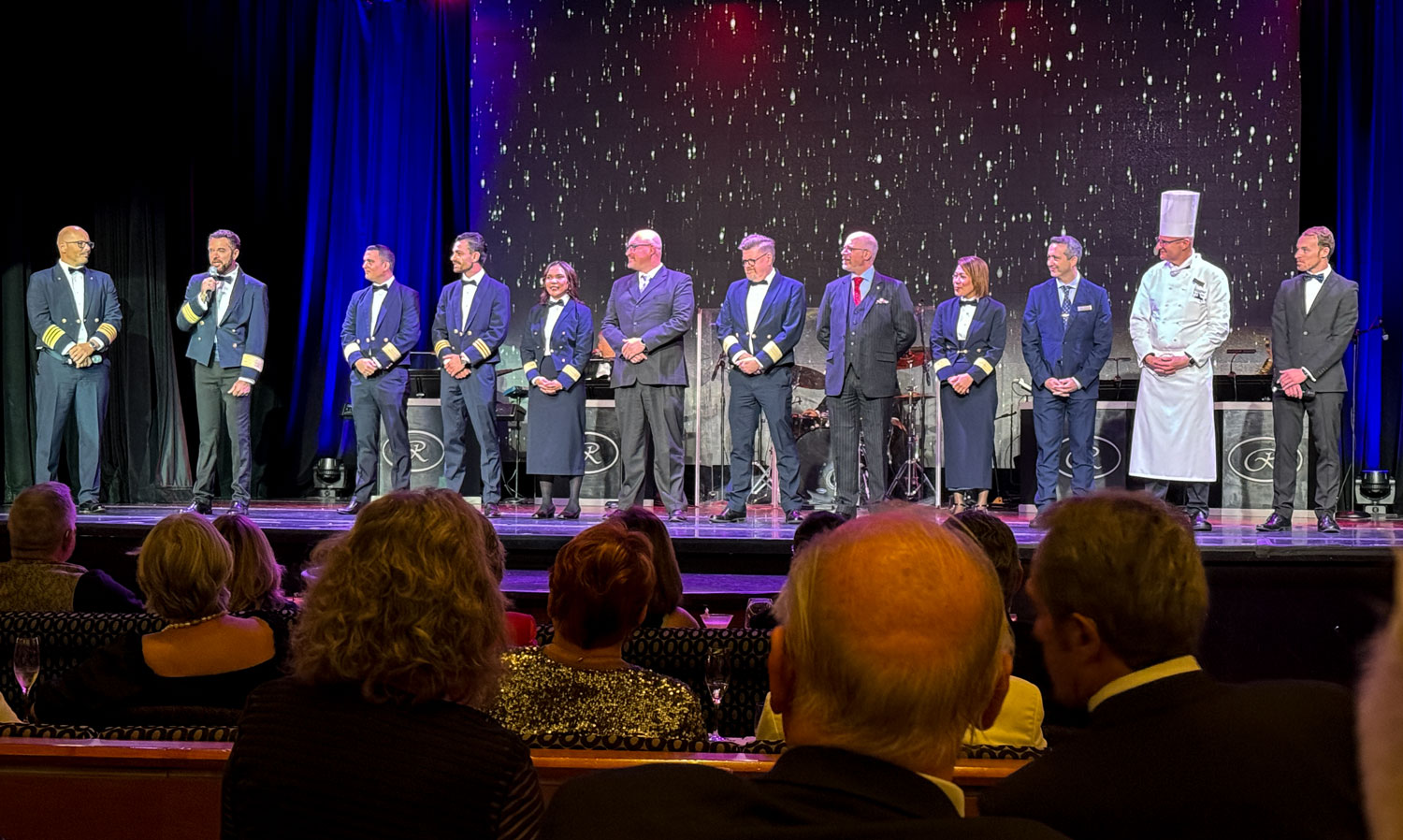
It was formal night for dinner, which we shared with Eva and Richard. They are our neighbors in Villa Park, and it's their first Regent cruise.
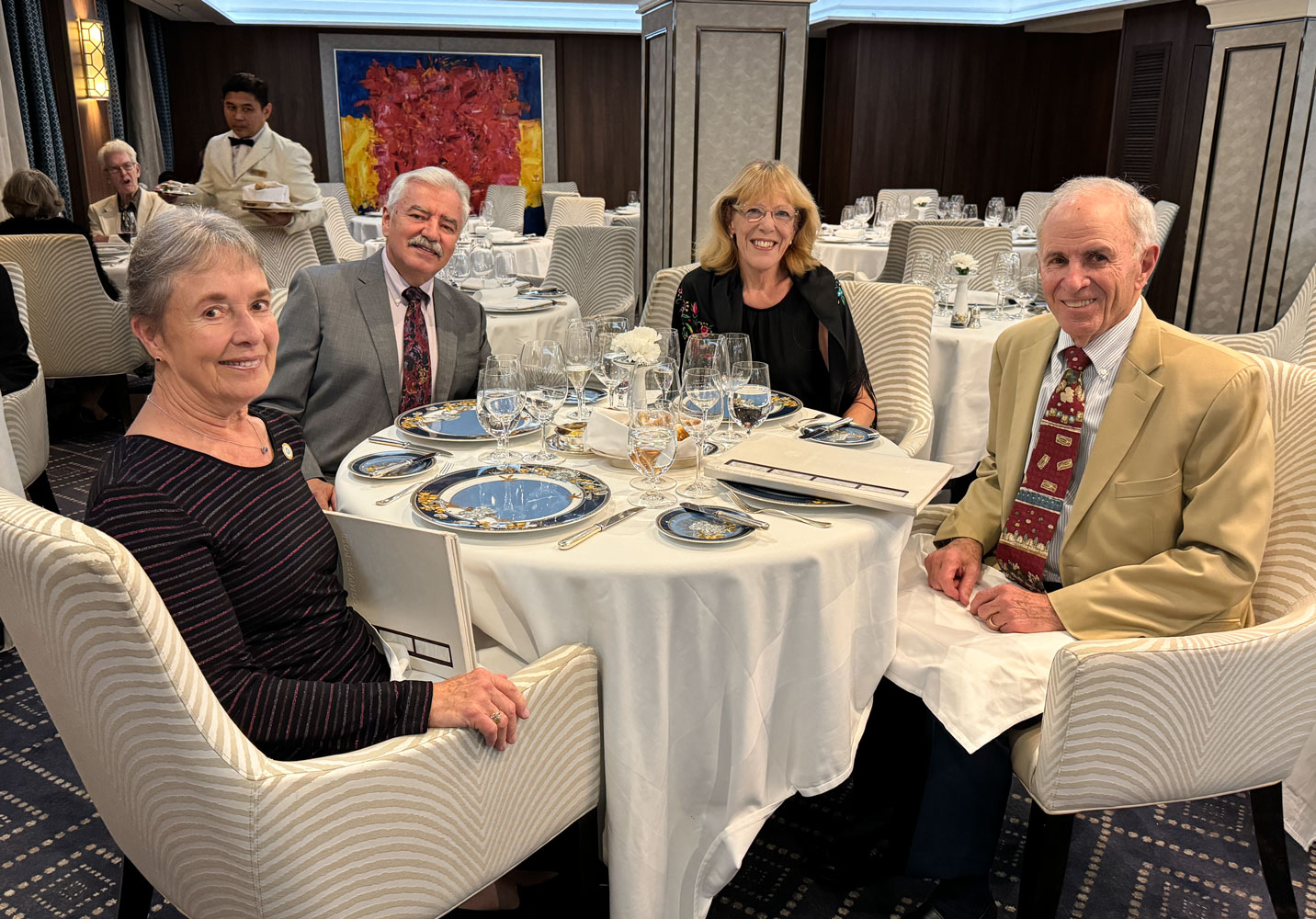
The next day we learned that their cabin had serious vibration issues, enough that they couldn't sleep. They had to spend the night in the room, but the staff moved them to a different cabin the next day.
+++++++++++++++++++++++++++++++++++++++++
11/20/2023 (Monday) We arrived in Cadiz this morning and will be doing an excursion just outside the town. Here's the view of Cadiz we had from our cabin balcony. You can see the Cadiz Cathedral in the center of the picture.
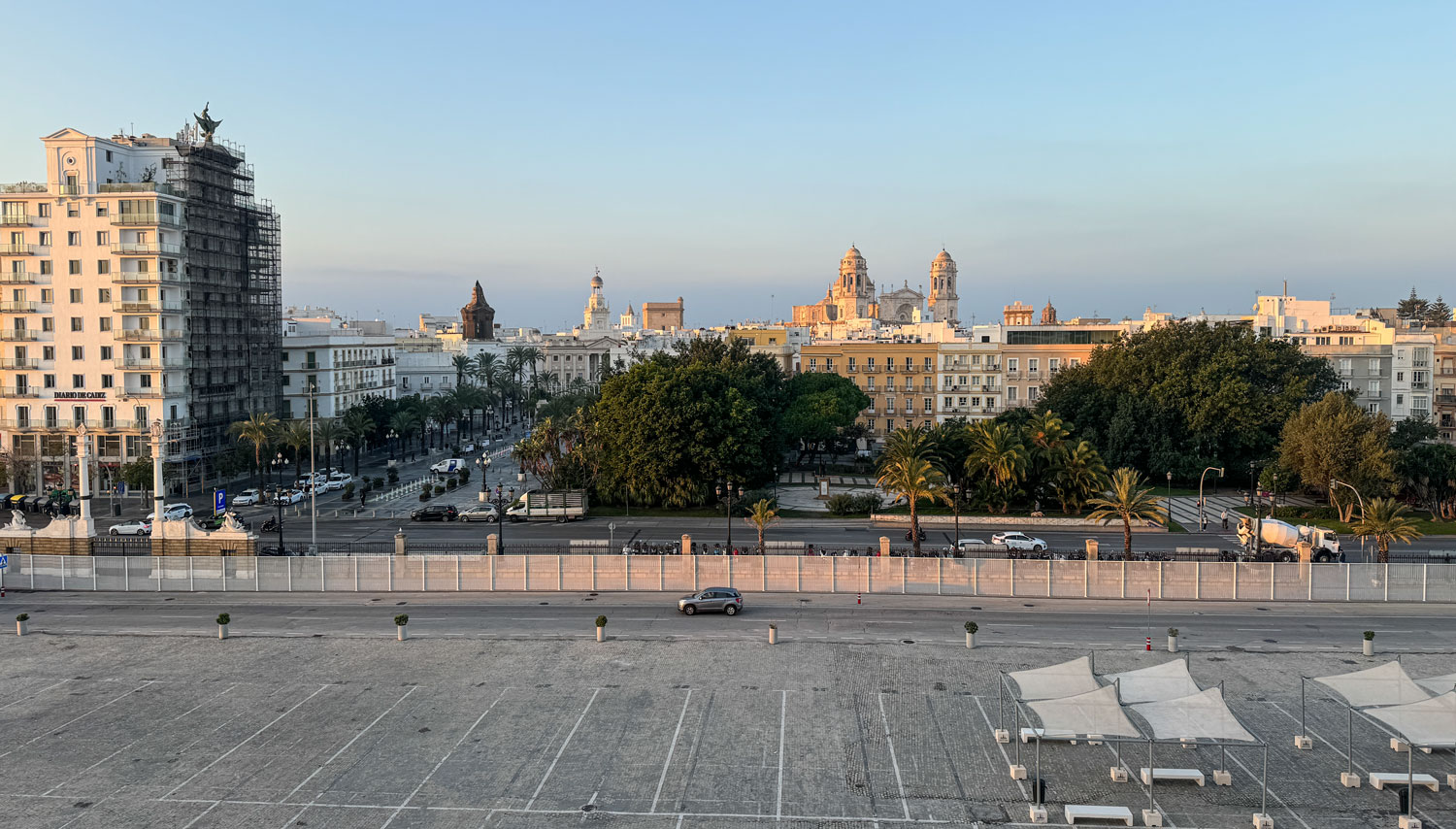
Some people are taking an excursion to Seville. There's a lot to see in Seville, especially the huge Seville Cathedral, but Judy and I had been there on a previous cruise, and we decided to see Cadiz.
Our excursion was to Jerez de la Frontera where the Royal Andalusian School of Equestrian Arts is located, and to a wine maker in the historical center of Jerez. We departed the ship about 10am for a one-hour ride to the Equestrian School.
The Royal Andalusian School of Equestrian Arts is one of the big four riding academies in Europe. The other three are:
Spanish Riding School in
Vienna. They're famous for the Lipizzaner stallions (also
see here).
Portuguese School of Equestrian Arts in Lisbon (also
see here).
Cadre Noir of
Saumur, France (also
see here).
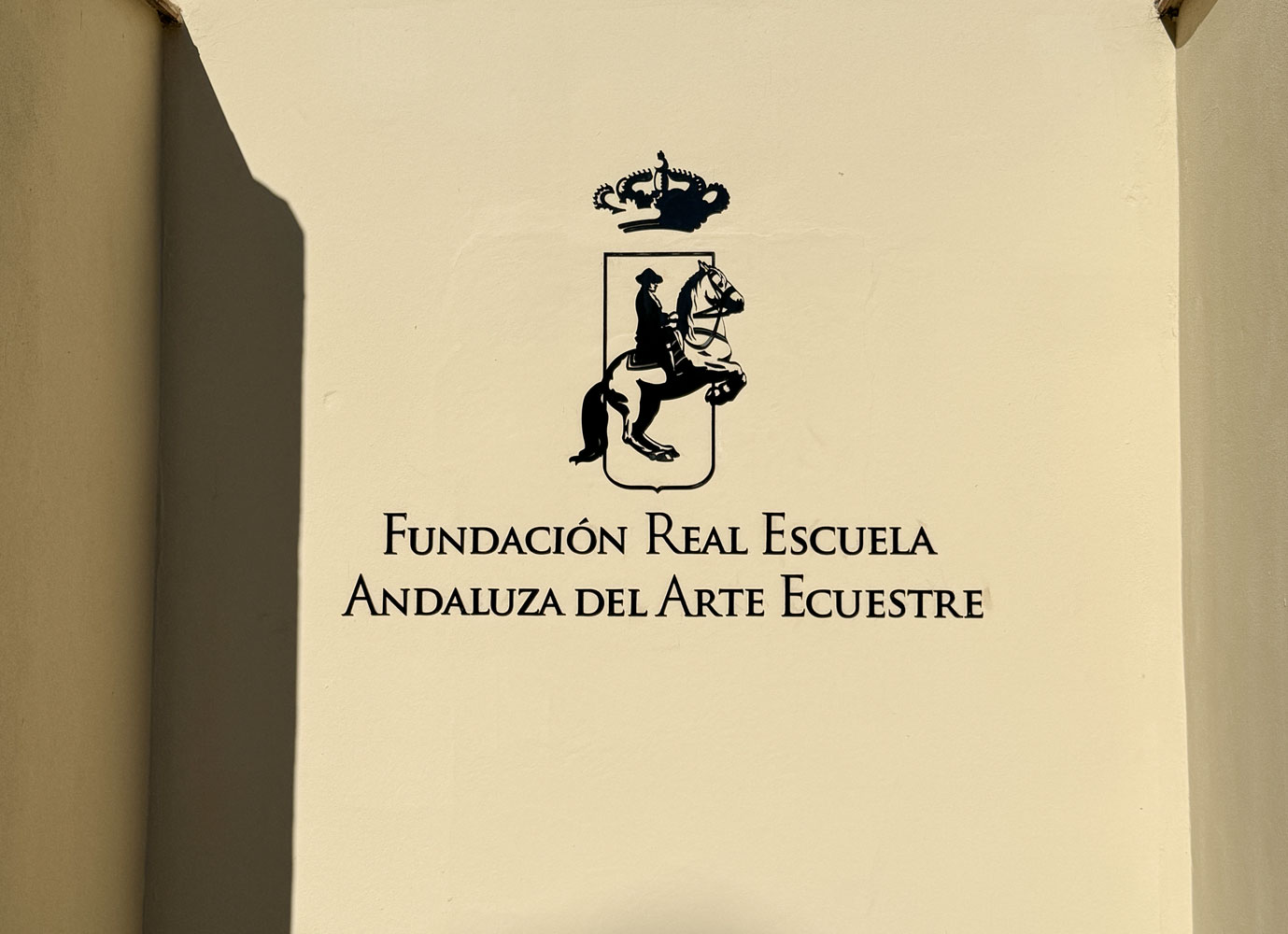
This was a training day for the horses, but no show presentation. We could observe is whatever training is going on, and the grounds.
Some of the stables for the horses, located adjacent to the training arena.

From here, we entered the show arena, where riders were exercising their horses and taking instruction. It gets quite hot in Jerez in the summer and the heat would be hard on both the horses and the riders.

A few pictures of the horses. A note on the pictures: I only took my iPhone on this excursion. But the iPhone is not at its best when photographing the moving horses in telephoto mode, in the dimmer light of the arena. I did not want the inconvenience of carrying my larger camera - but it would have produced better pictures.
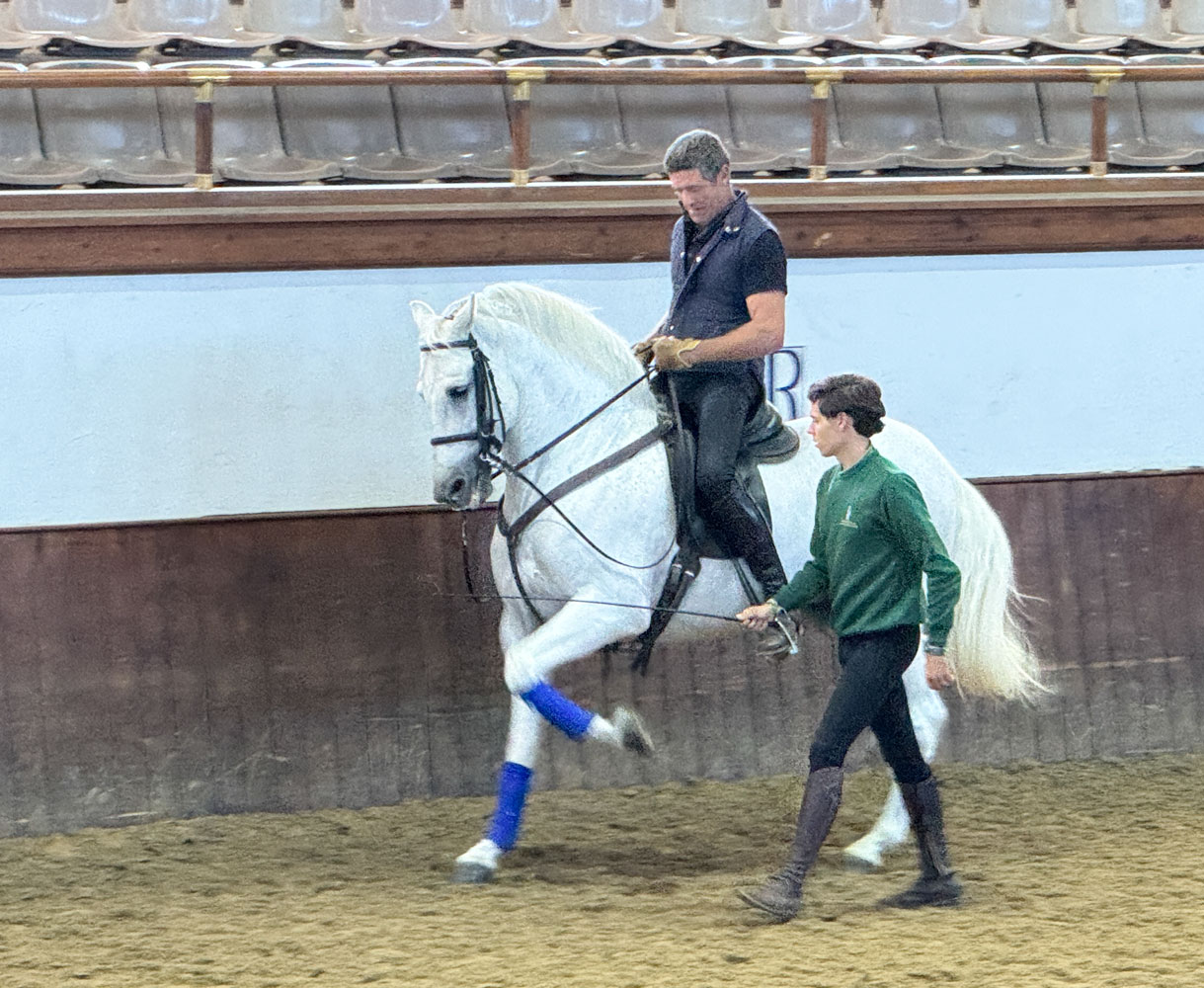
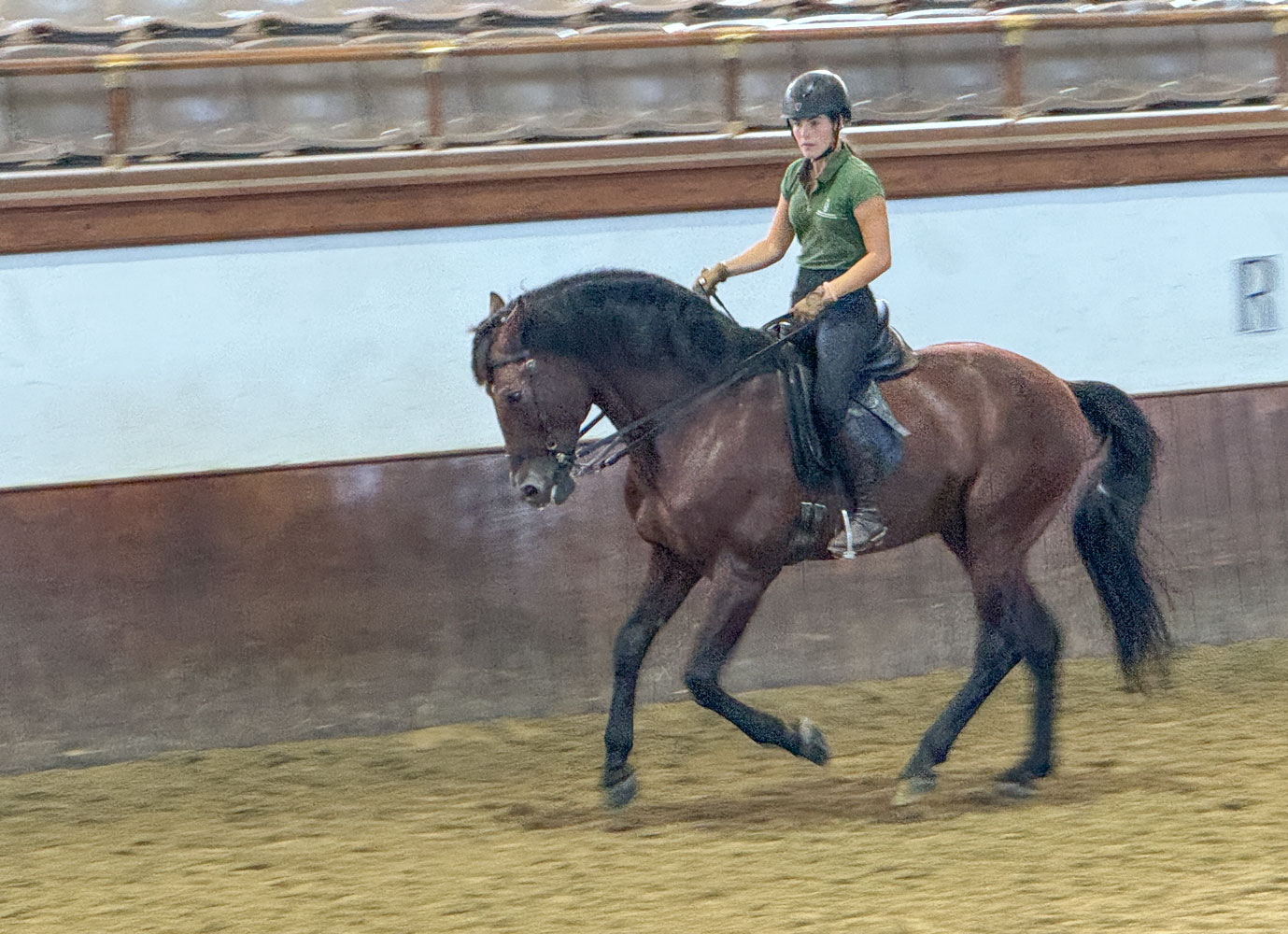
When we left the arena they were exercising some of the horses in the training arena. The exercise person has the horse on a long lead and the horse runs in a circle. The exercise person needs skill to make sure the horse does not get tangled in the strap.
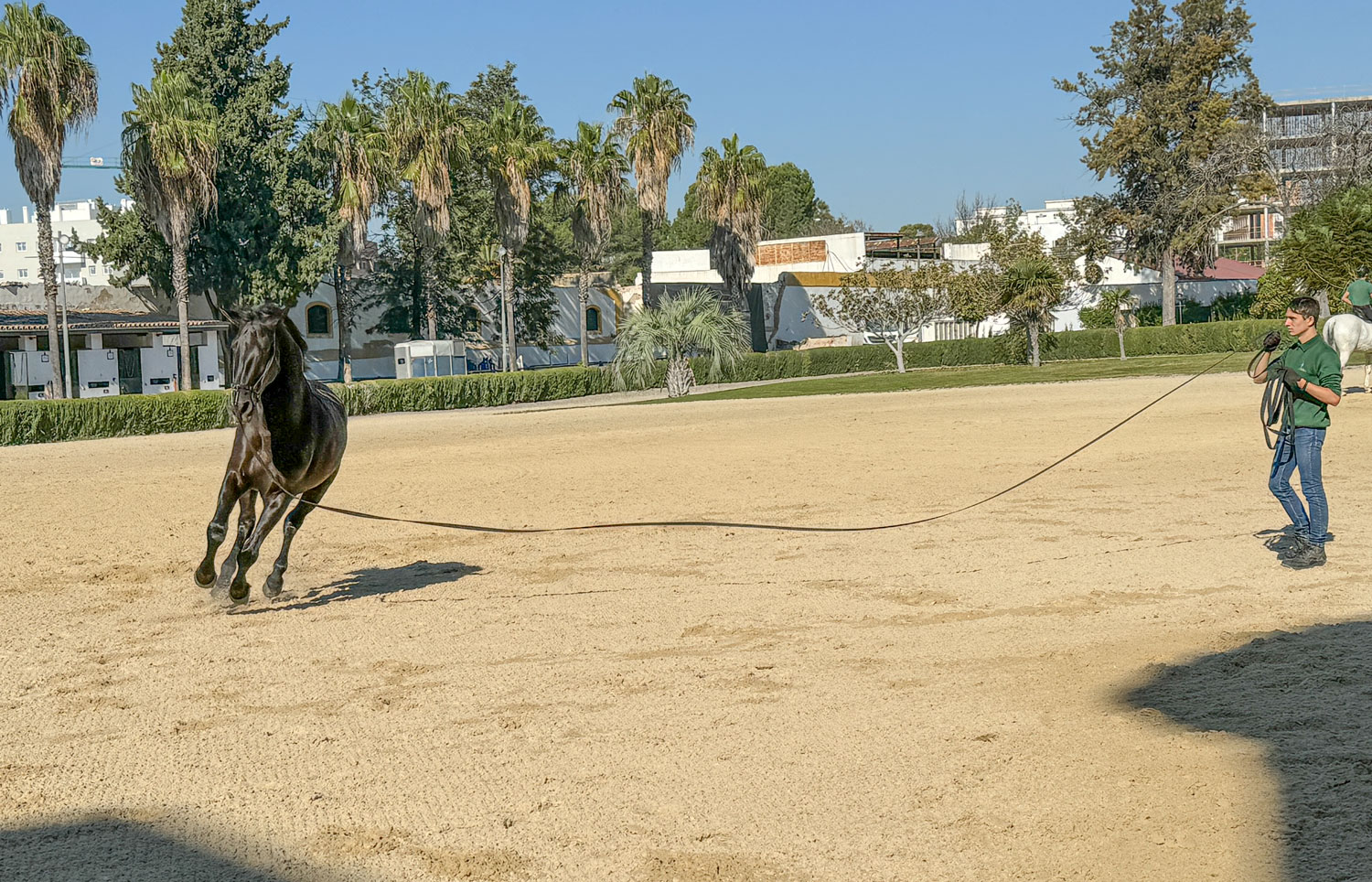
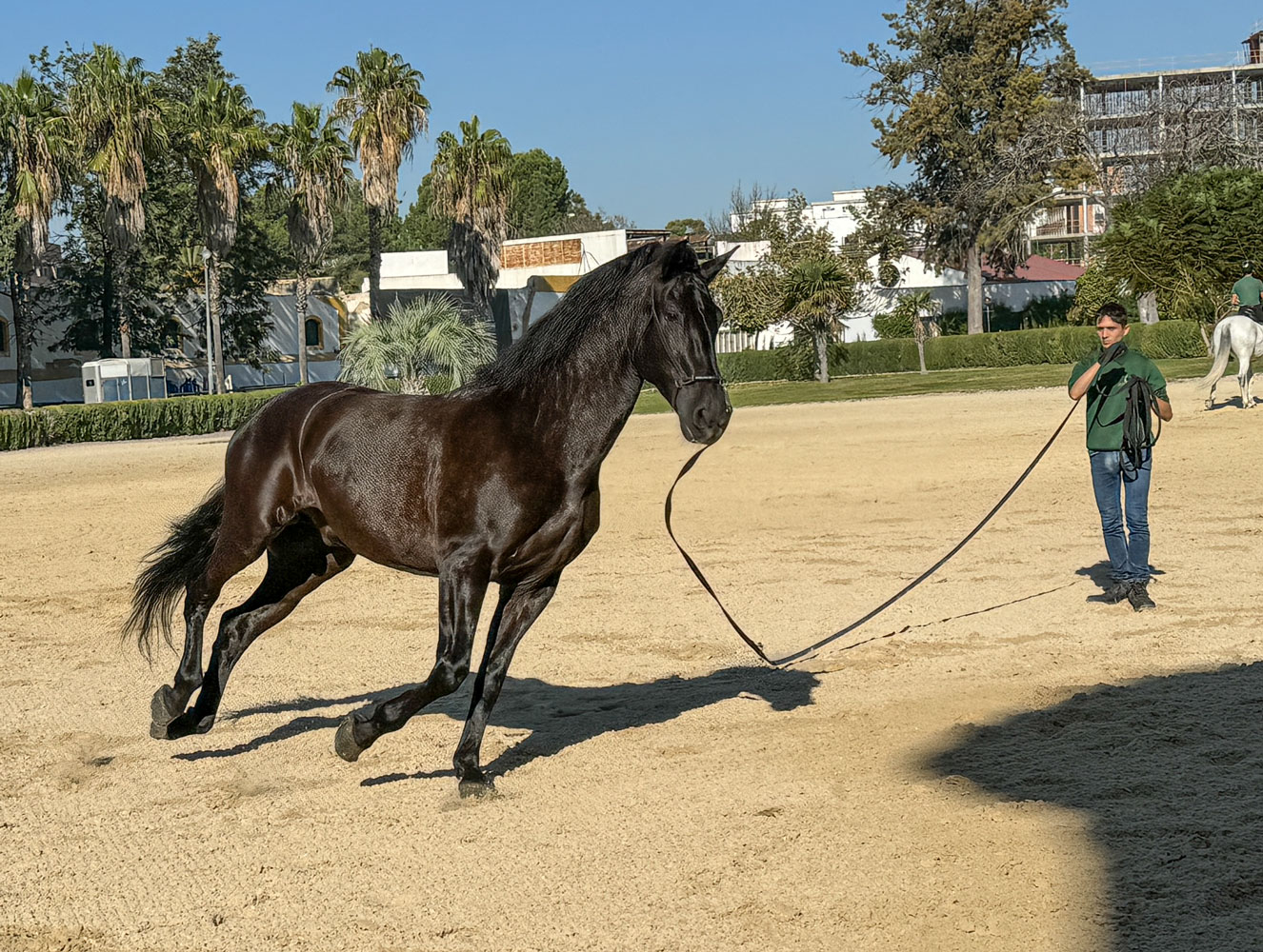
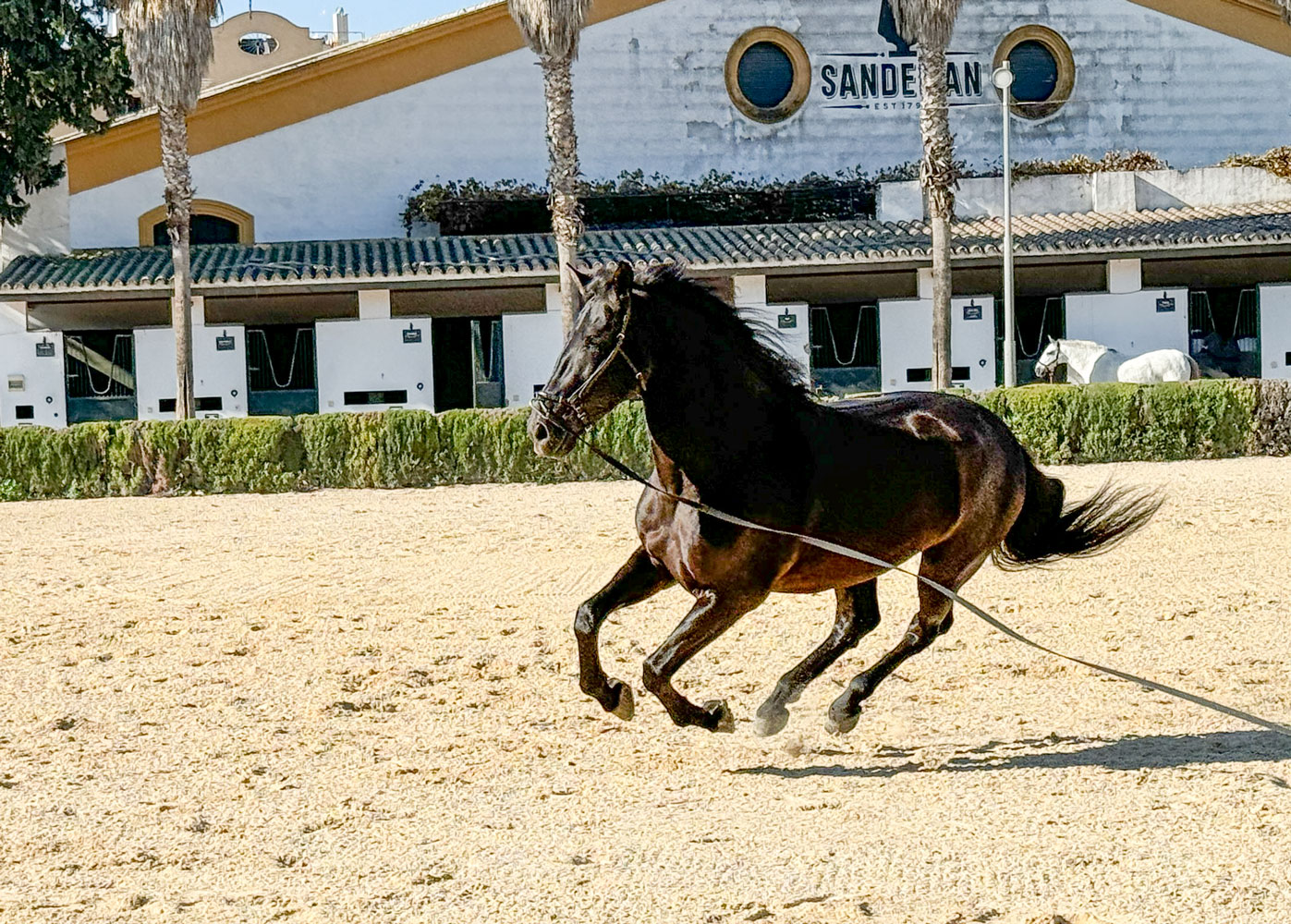
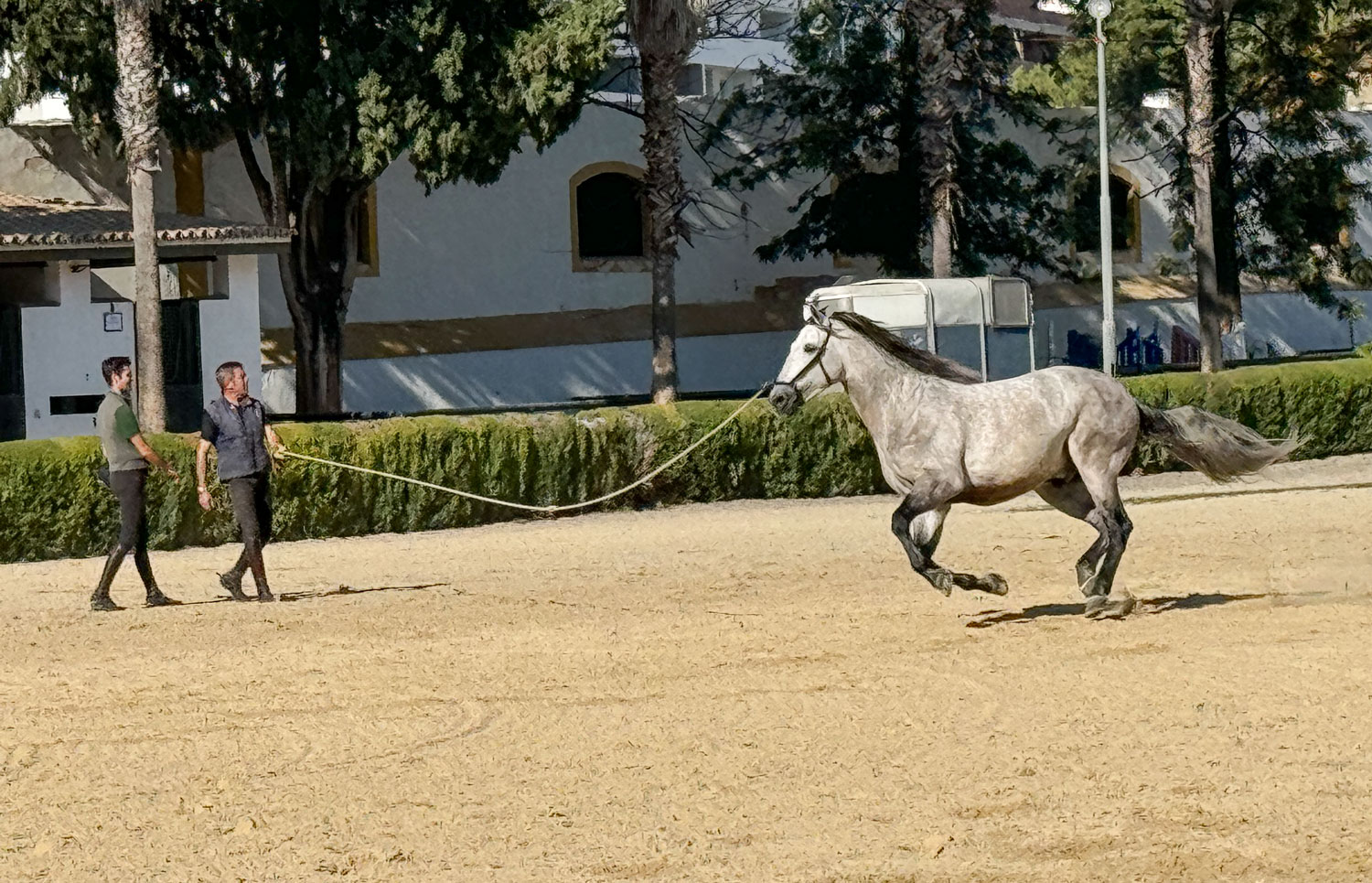
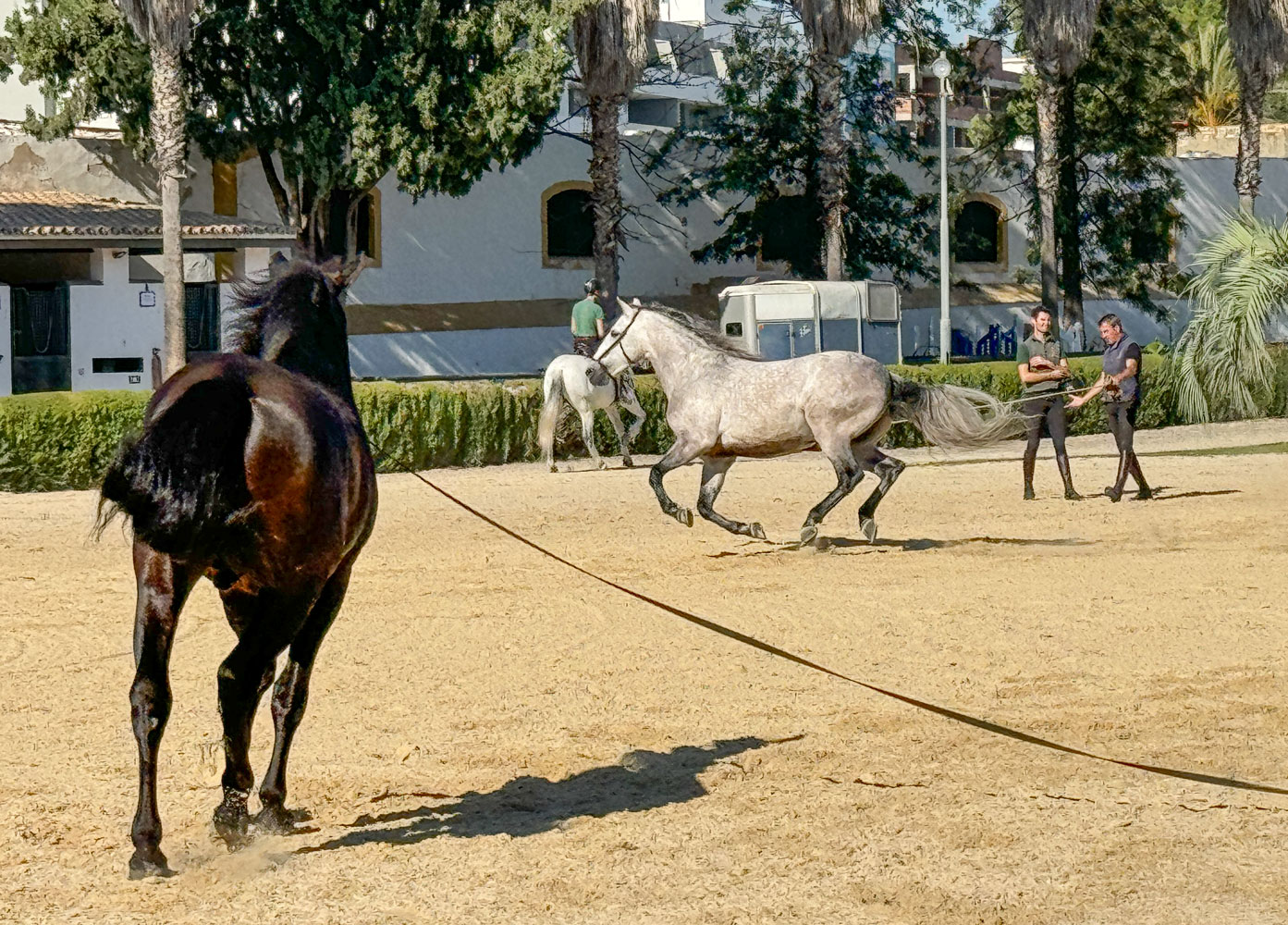
Next we went to the tack room where the bridles and saddles are stored.

From here, we went to one of the stables to visit the horses there.

One of the horse stalls. This horse was older - the sign above the door said he was born in 2008, which would make him about 15. Race horses (in the northern hemisphere) all have their birthday on January 1, no matter when they were born, but I don't know if that applies to show horses.
A horse could live for thirty years, but I expect his ability to participate in show events would be less than that.
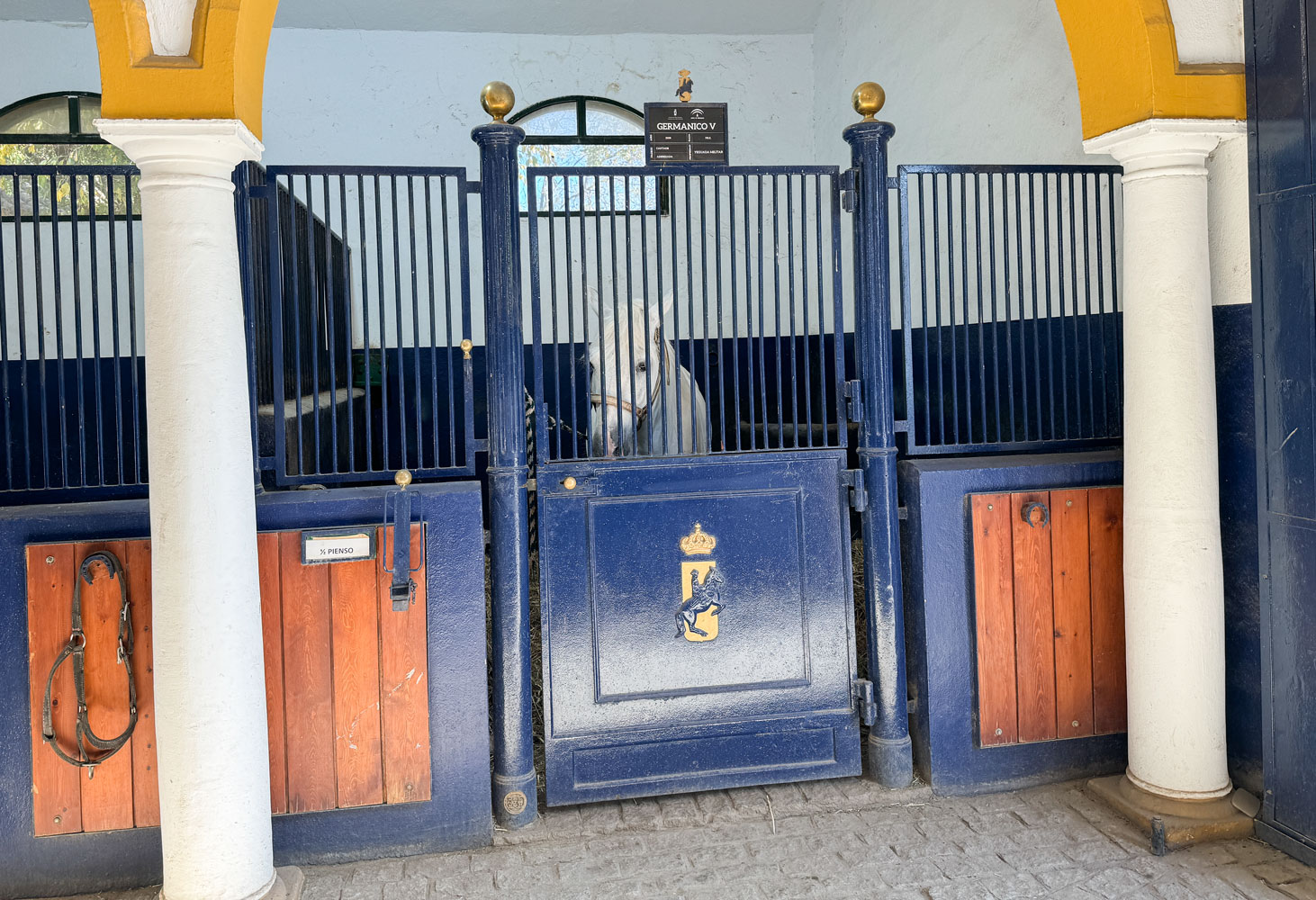
After this, we left to visit Gonzáles Byass, a producer of fine sherry. The facility is huge. We started our visit at a model bodega. In Spain, a bodega is a place to store wine. My experience, in the US, is that a bodega is a small grocery and liquor store in a big city. There was no wine in these barrels - it was just for show, with an emblem on each barrel representing a country to which they export.
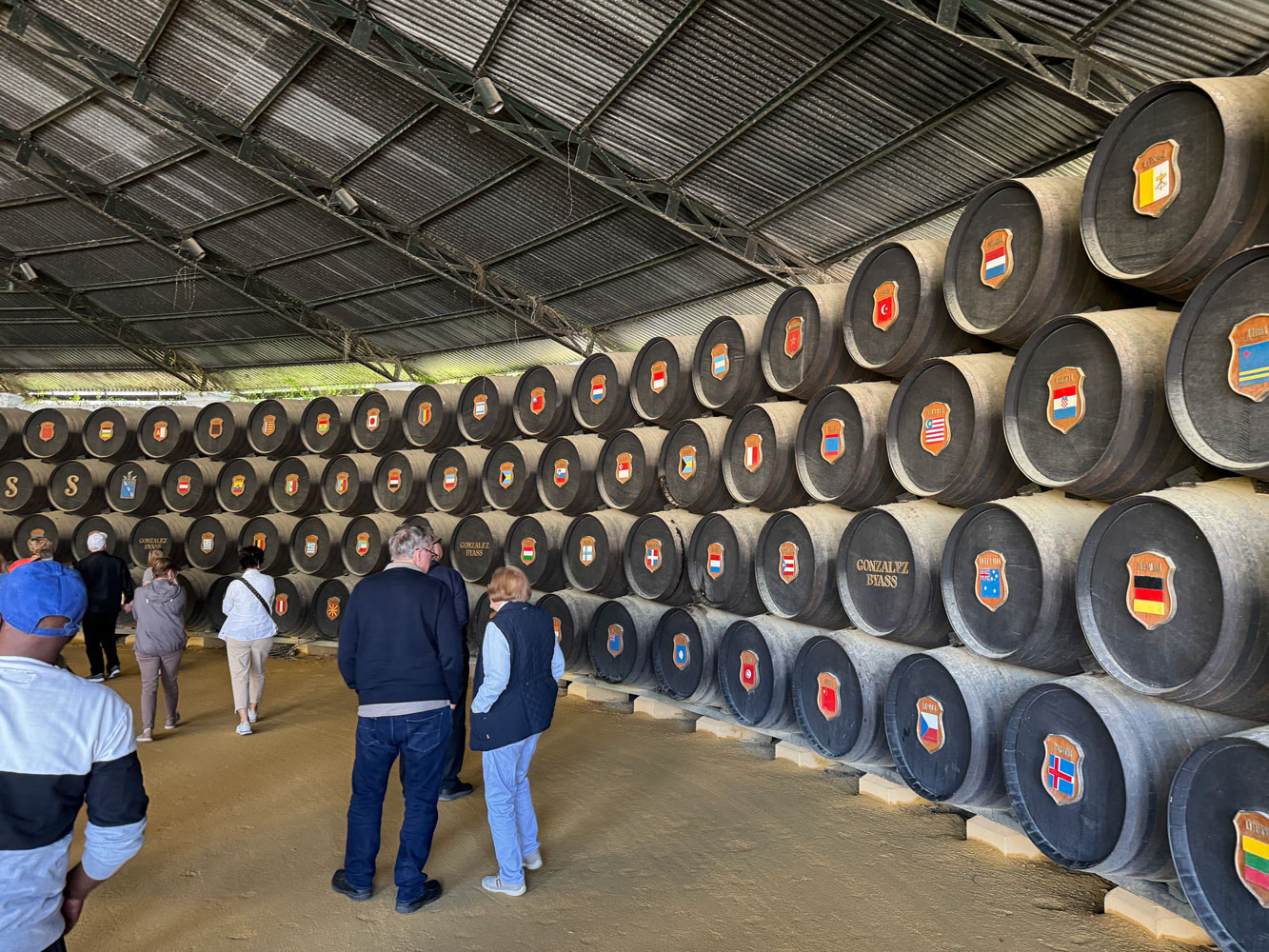
We went into one of the real storage buildings - there were a lot of barrels there, and it was just one of the storage buildings. The barrels are made of American oak.
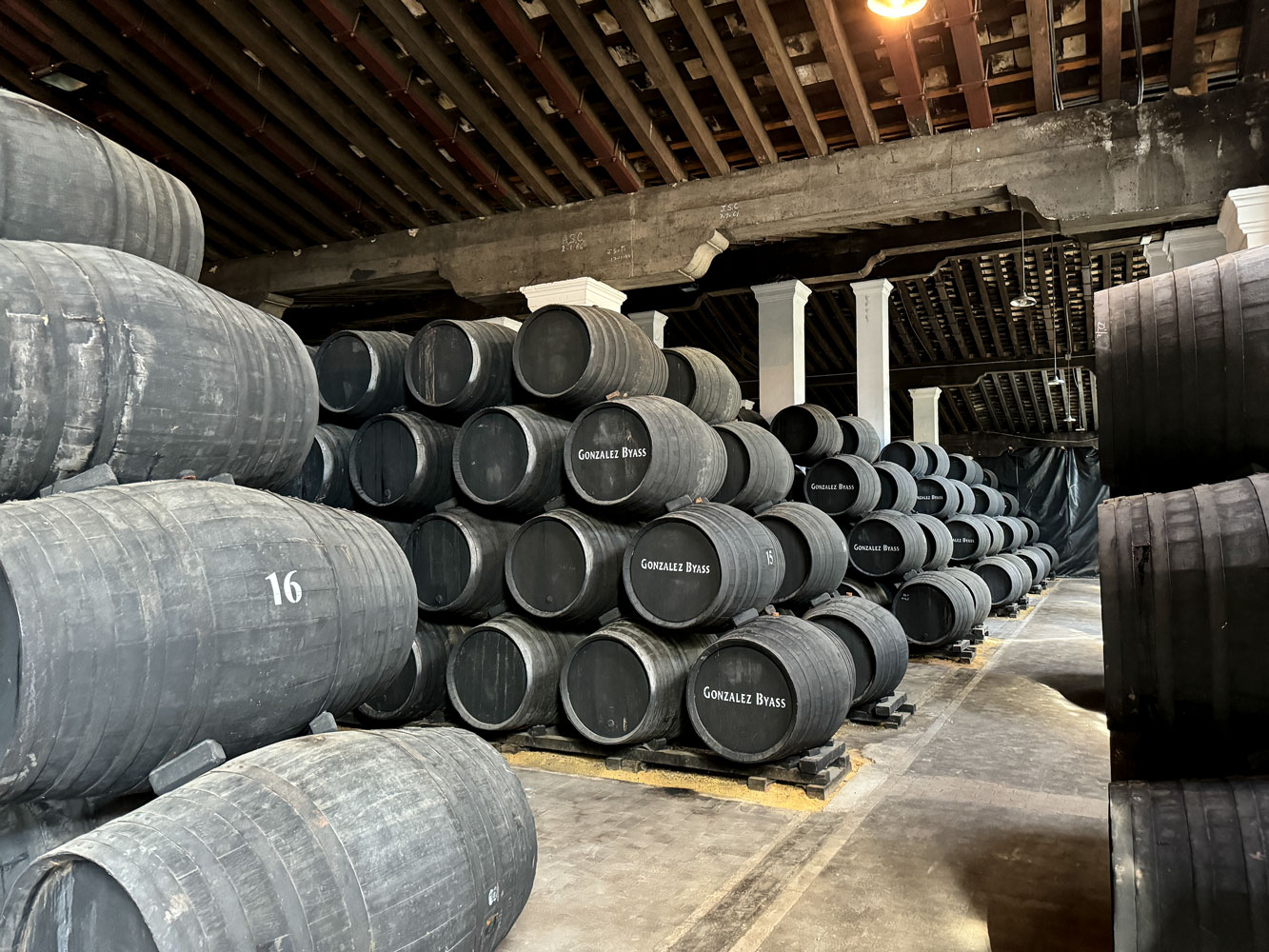
Another view of the barrels.
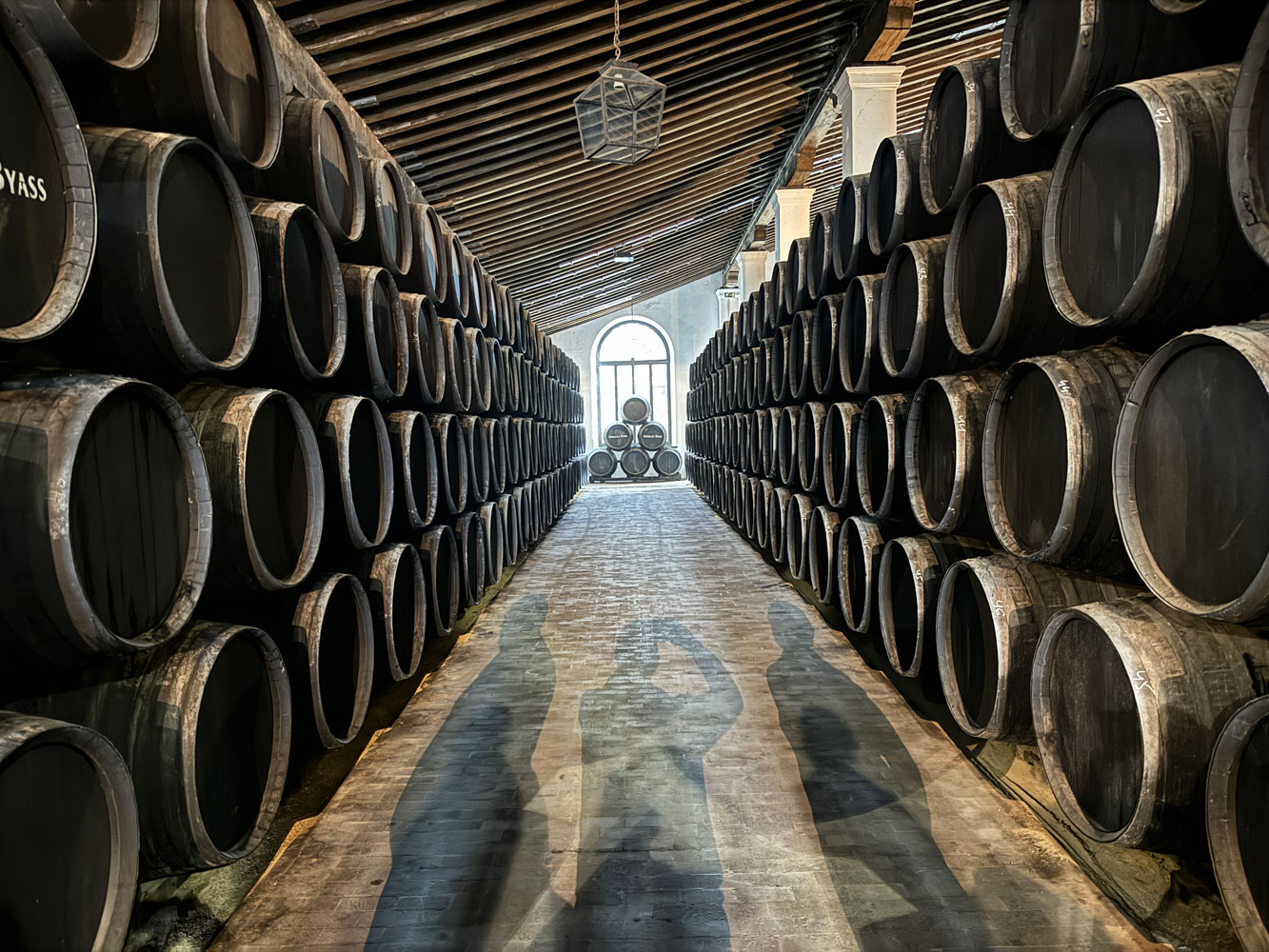
In 1936, they created the character of tío Pepe, a bottle dressed up with a hat sitting jauntily on the bottle top.
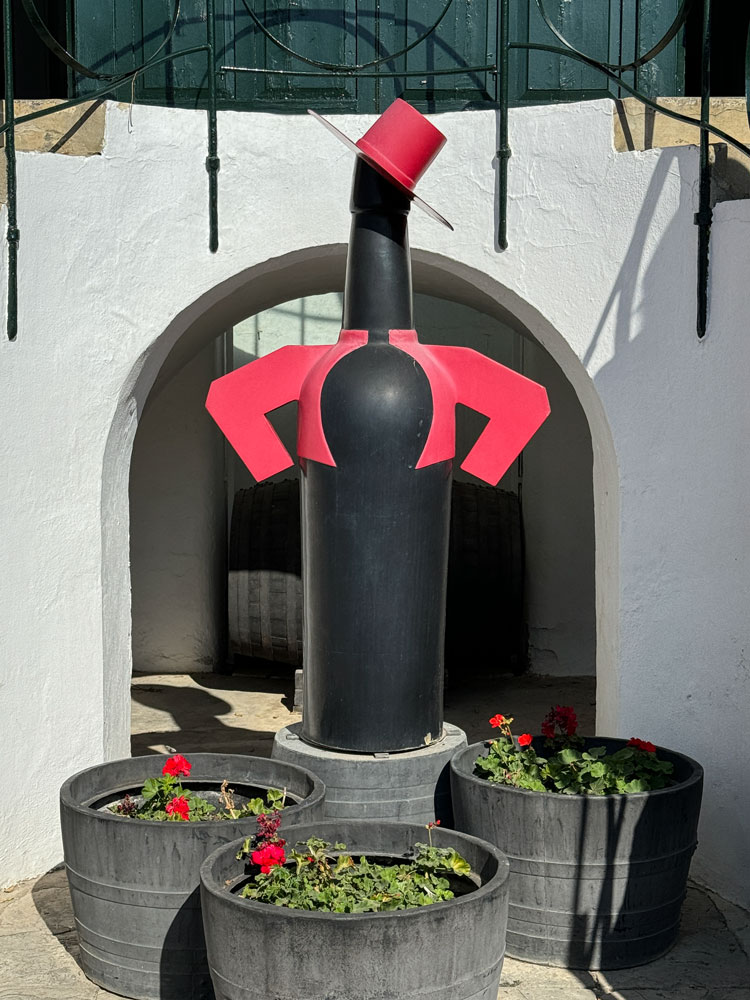
Next we went into a domed building where there was a restaurant.
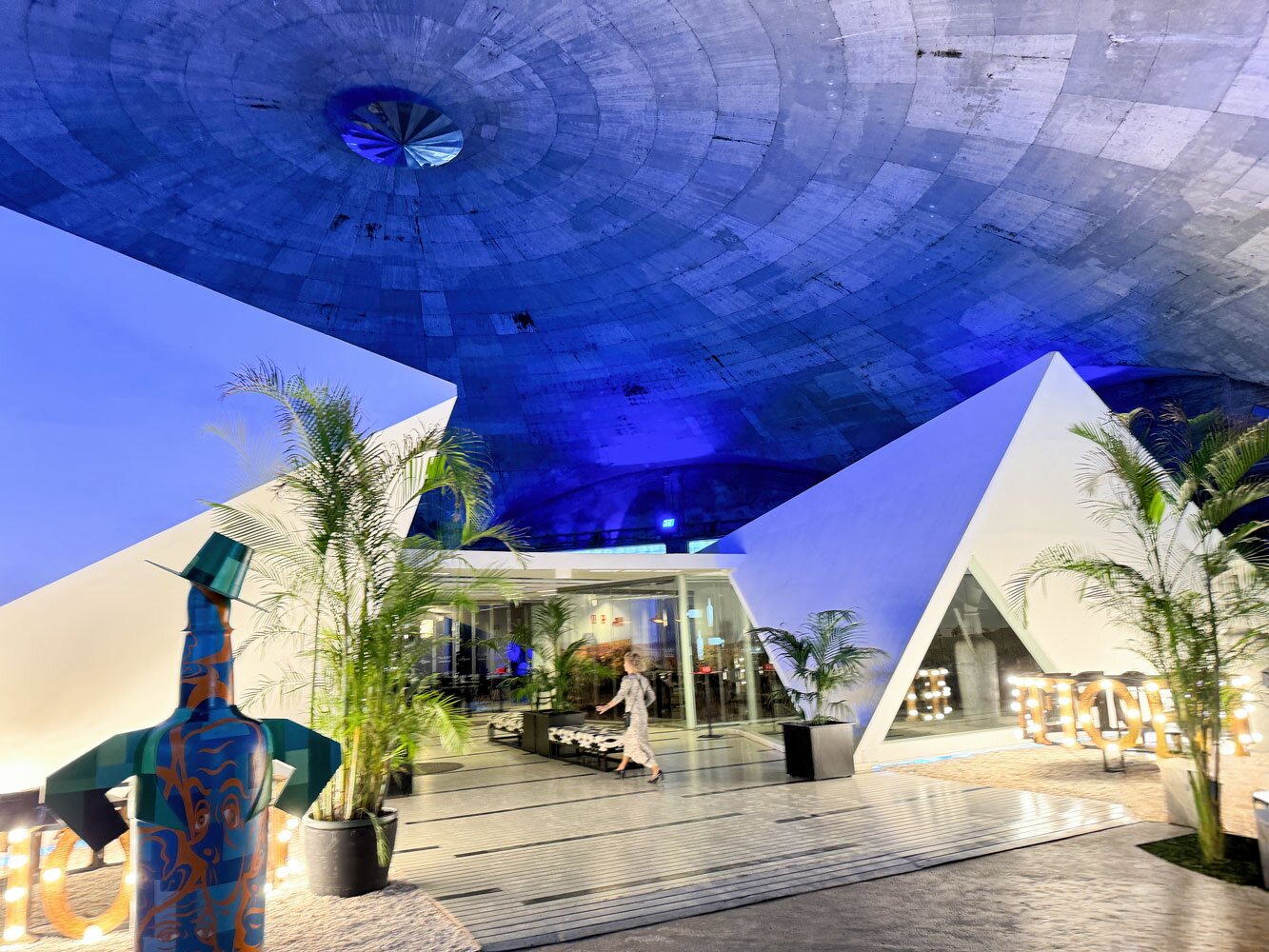
In the restaurant we each tasted three different glasses of sherry, and there was a plate of tapas to share.
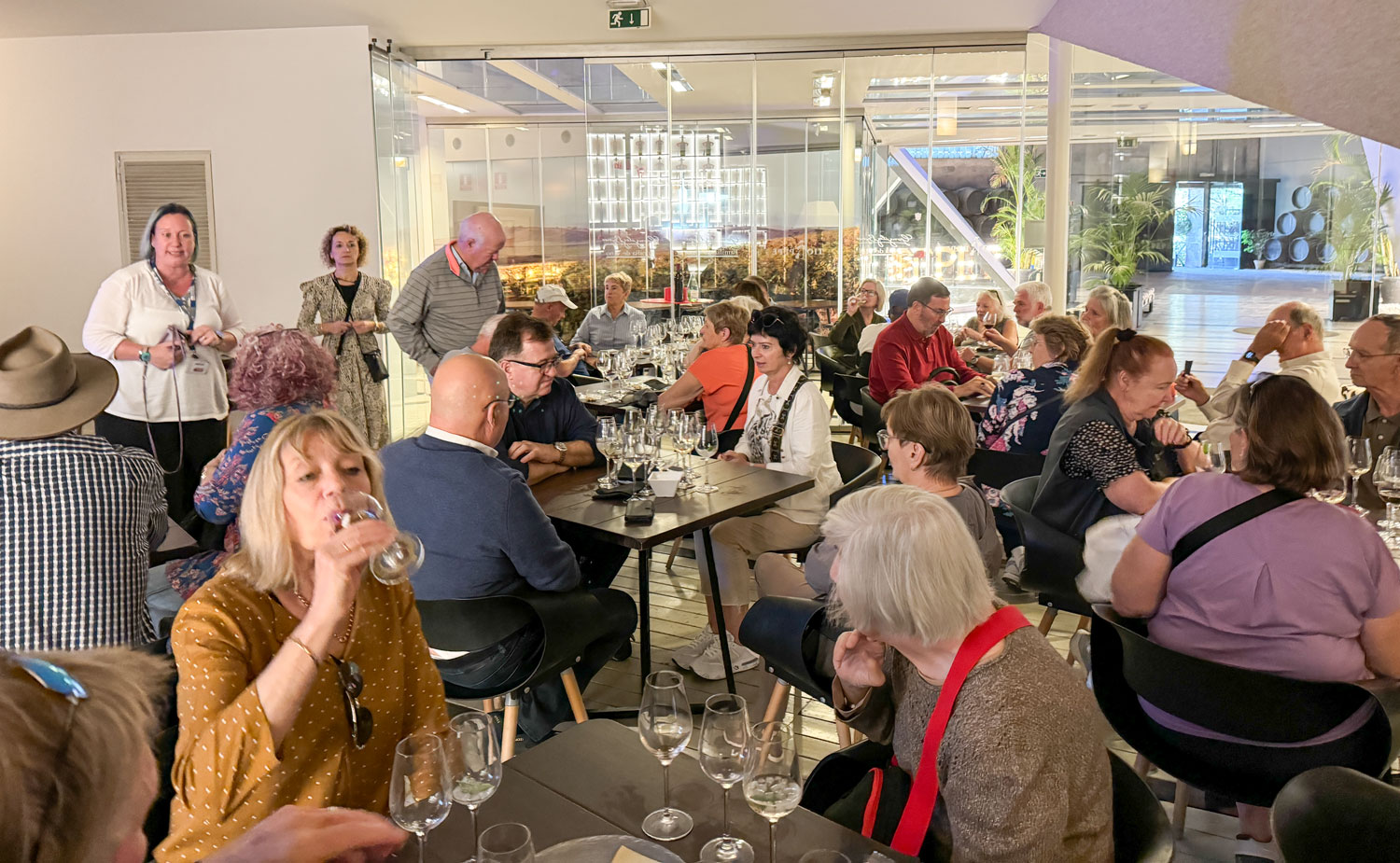
We then headed back to the ship. We had gone over the old bridge when we departed, but we took the new bridge on our return. This is the La Constitución de 1812 Bridge, a cable stayed bridge. Here's a picture of the bridge taken from the web.
We had seen this bridge last time we were in Cadiz, but had not crossed it at that time.

And a couple of pictures that Judy took as we approached and crossed the bridge.
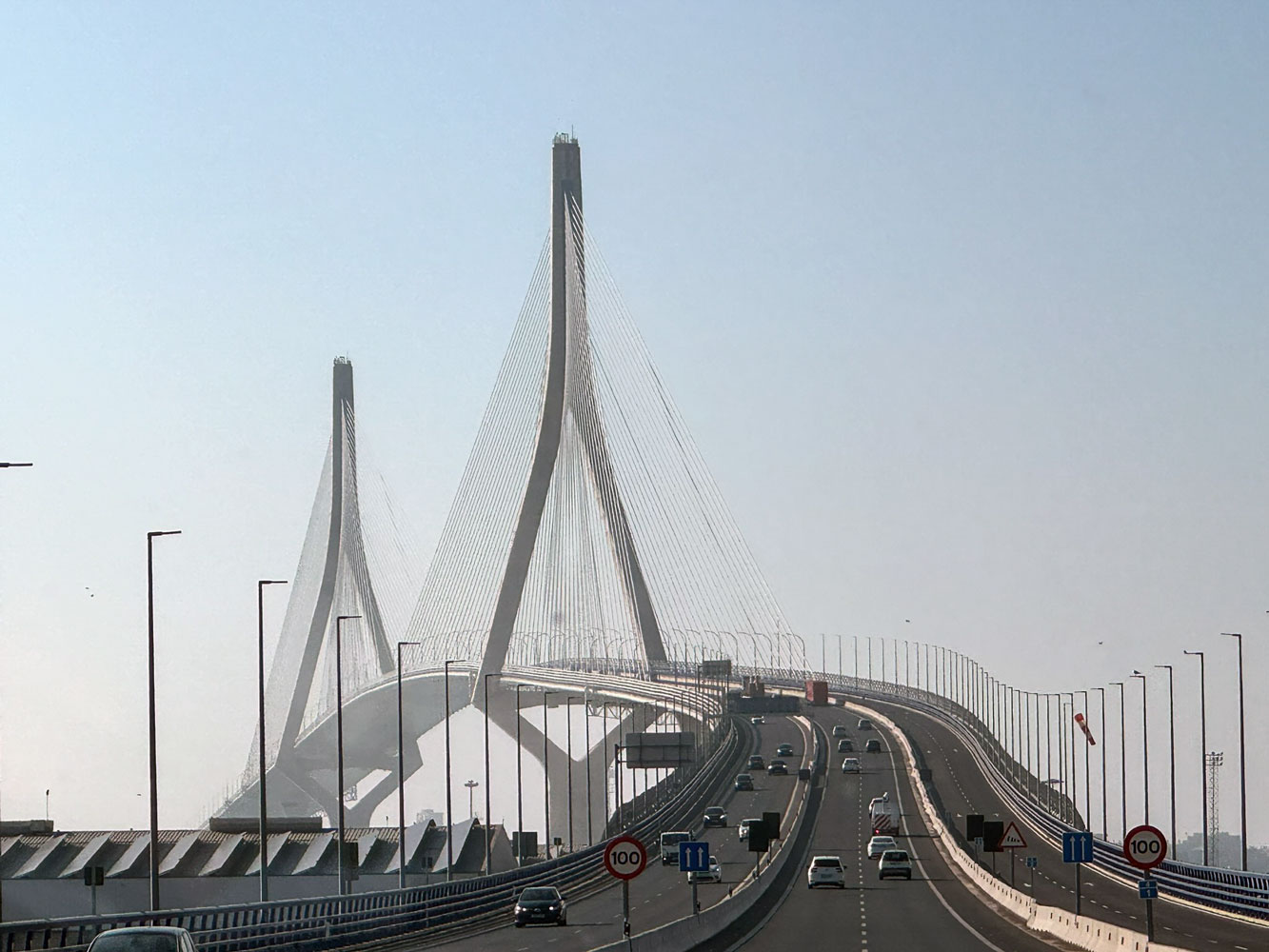
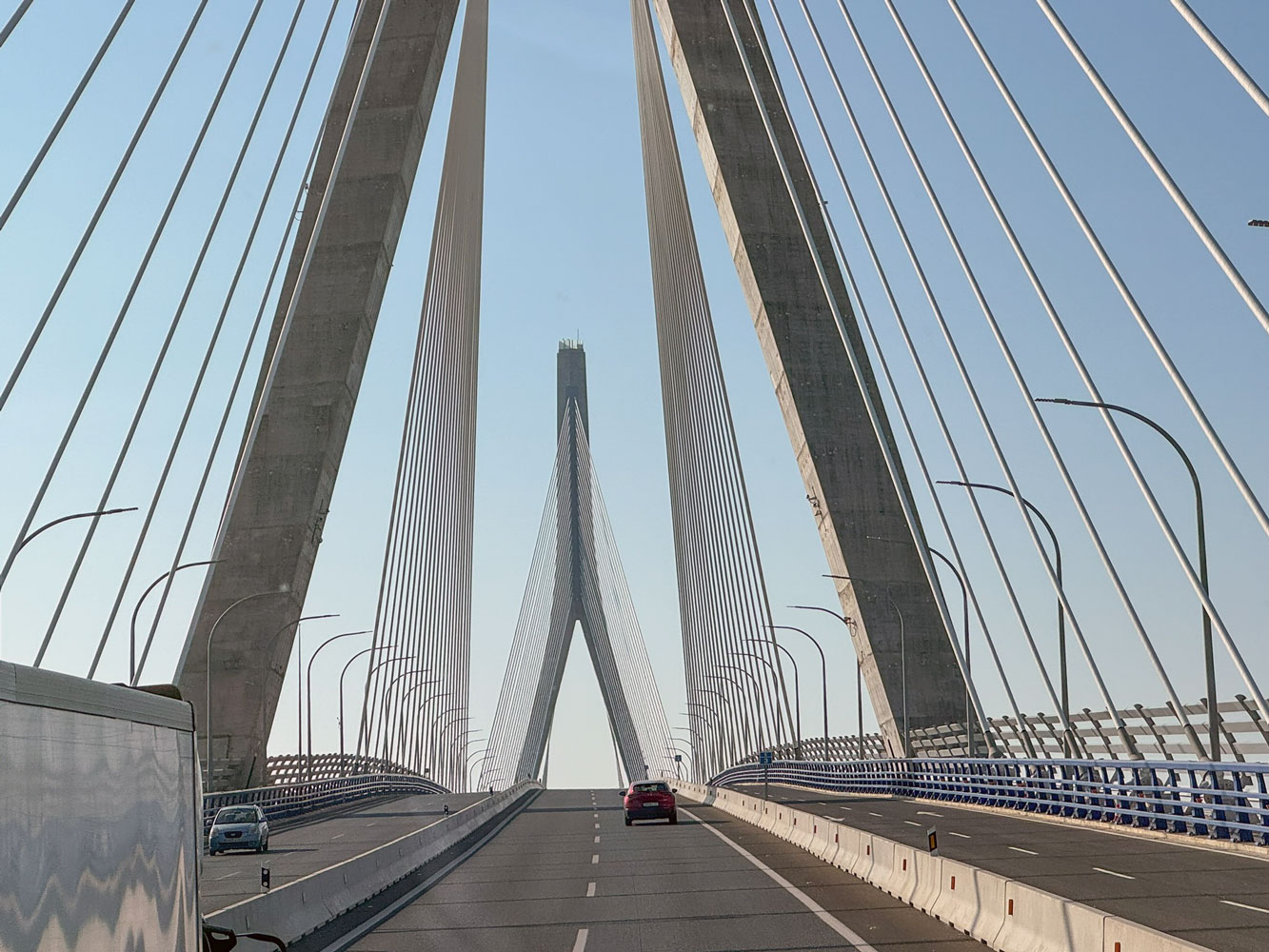
We returned to the ship in time for the daily trivia game, then dinner and then to bed. It was a long day.
The ship departed Cadiz at 7pm.
+++++++++++++++++++++++++++++++++++++++++
11/21/2023 (Tuesday) Today is a sea-day. Originally, we were suppose to stop at Casablanca but Regent cancelled that stop and added one stop in the Canary Islands. I'm not sure why they made that change (maybe due to the war between Israel and Hamas), but it didn't bother Judy and me - we had been to Morocco and Casablanca and found that Casablanca wasn't that interesting. The only things of interest there are a big mosque, and Rick's Cafe (of movie fame). And Rick's Cafe doesn't look anything like it does in the movie.
We won't reach the Canary Islands until tomorrow.
Nothing much to report. We slept late and played one of the games - bag toss - in the afternoon. Then dinner and to bed.
+++++++++++++++++++++++++++++++++++++++++
11/22/2023 (Wednesday) We arrive at the Canary Islands, specifically, the city of Arrecife on the island of Lanzarote. I've included the following three maps to show you where the Canary Islands are in reference to Spain and Africa, a second map for a more detailed view of the islands, and a detail map of Lanzarote, which we will visit today.
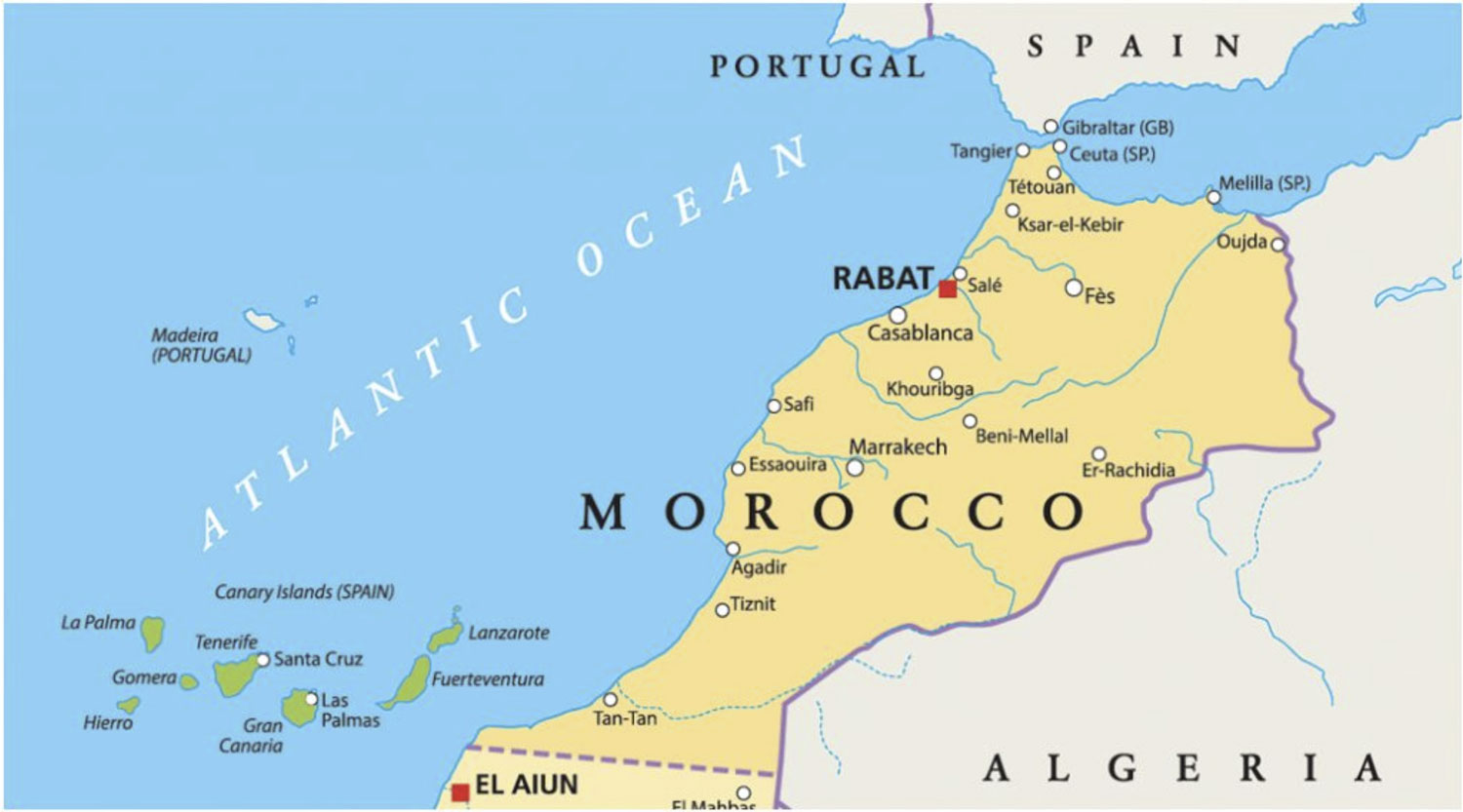
The Canary Islands were not named after the bird. They were named in antiquity in Latin as "Canariae Insulae", meaning "Island of the dogs". According to Pliny the Elder, the island contained a "vast multitudes of dogs of very large size," probably the Presa Canario. The canary bird was named after the island.
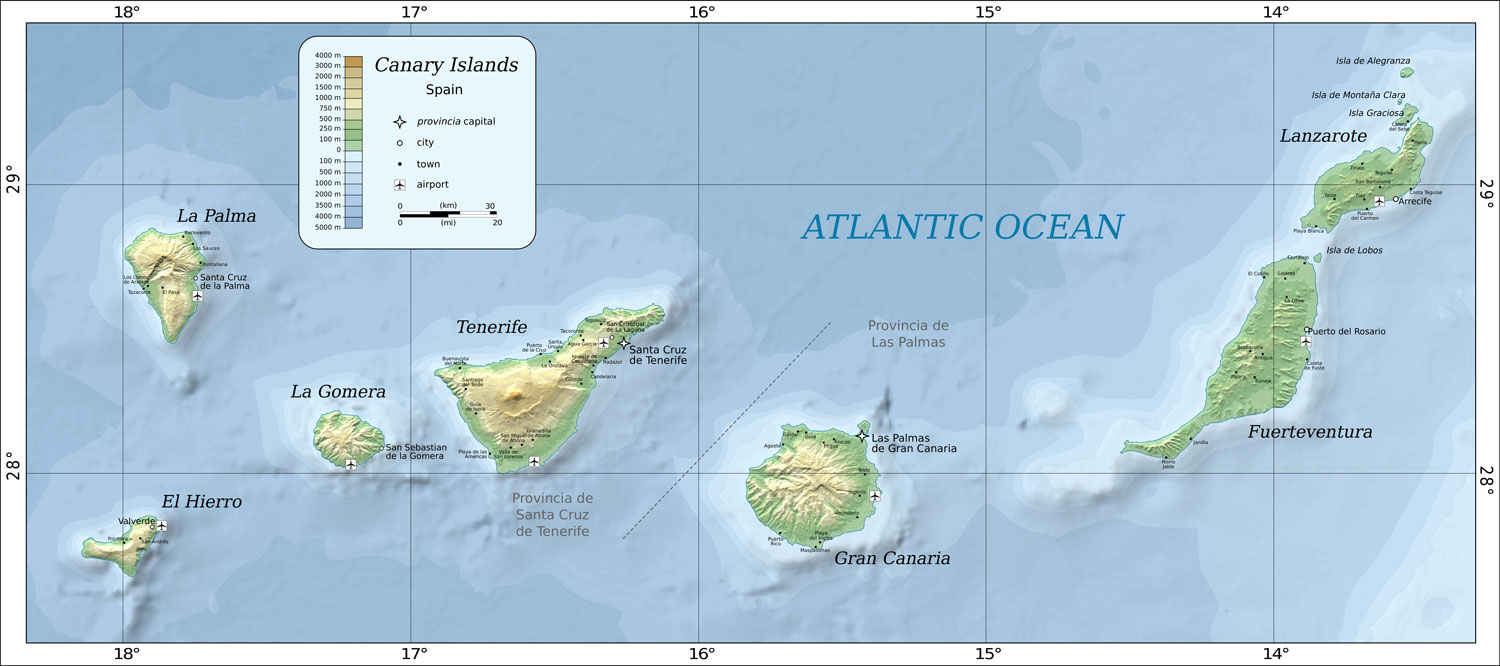
Lanzarote is a fairly small island, about 326 square miles. Comparing that to Maui in the Hawaiian islands, Maui is 727 square miles. So Lanzarote is less than half the size of Maui.
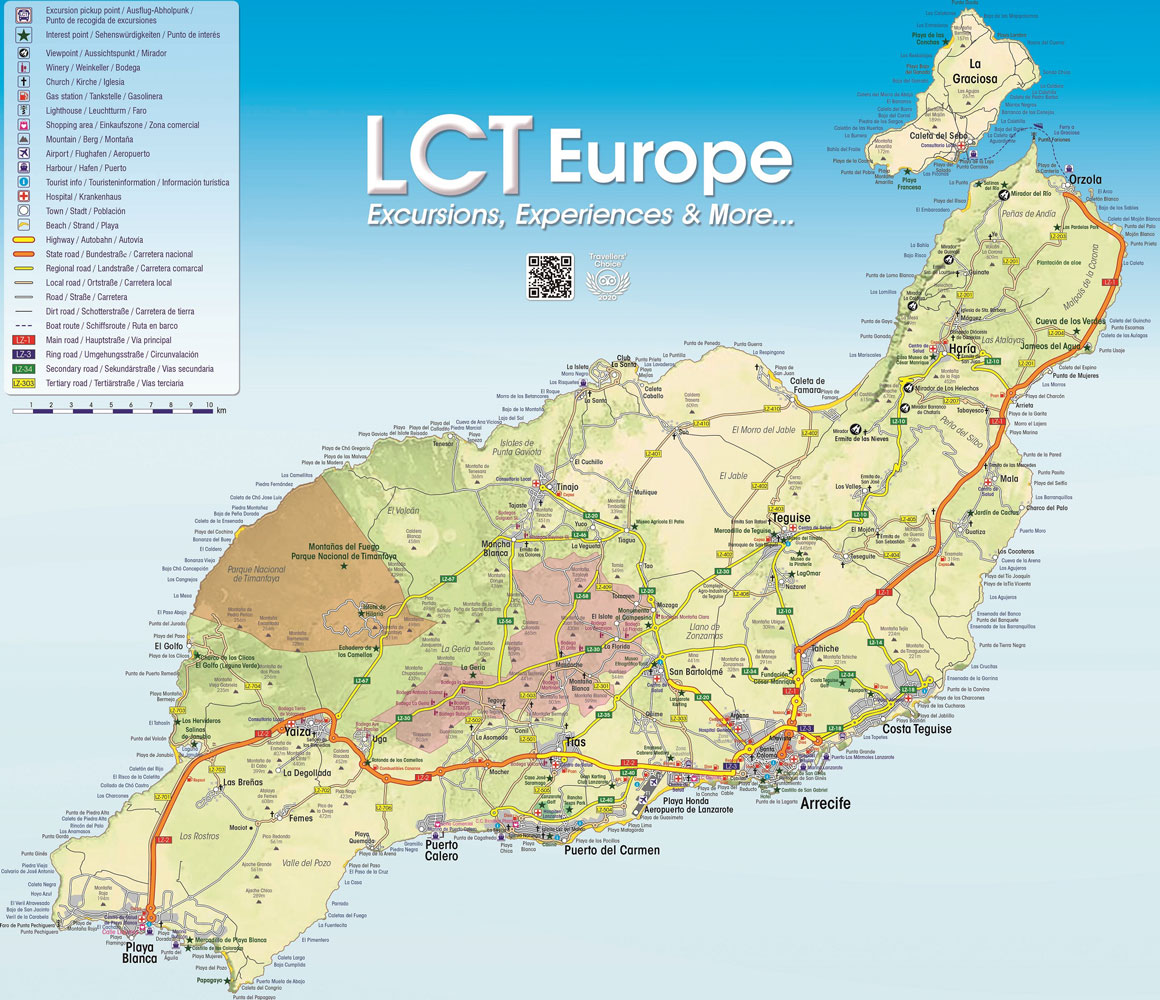
Lanzarote is the newest island of the Canary Islands, formed by volcanic action. The most recent large volcanic eruption occurred from 1730 to 1736 in an area now designated as the Timanfaya National Park, in the south western part of the island. The island is very dry and experiences almost constant wind from north-east. These two characteristics shape life on the island, as you'll see later in this blog.
We arrived in Arrecife about 7:30am. I took the following picture as the captain was backing the Voyager to the dock. The ship you see in the picture is an island ferry for vehicles and people.
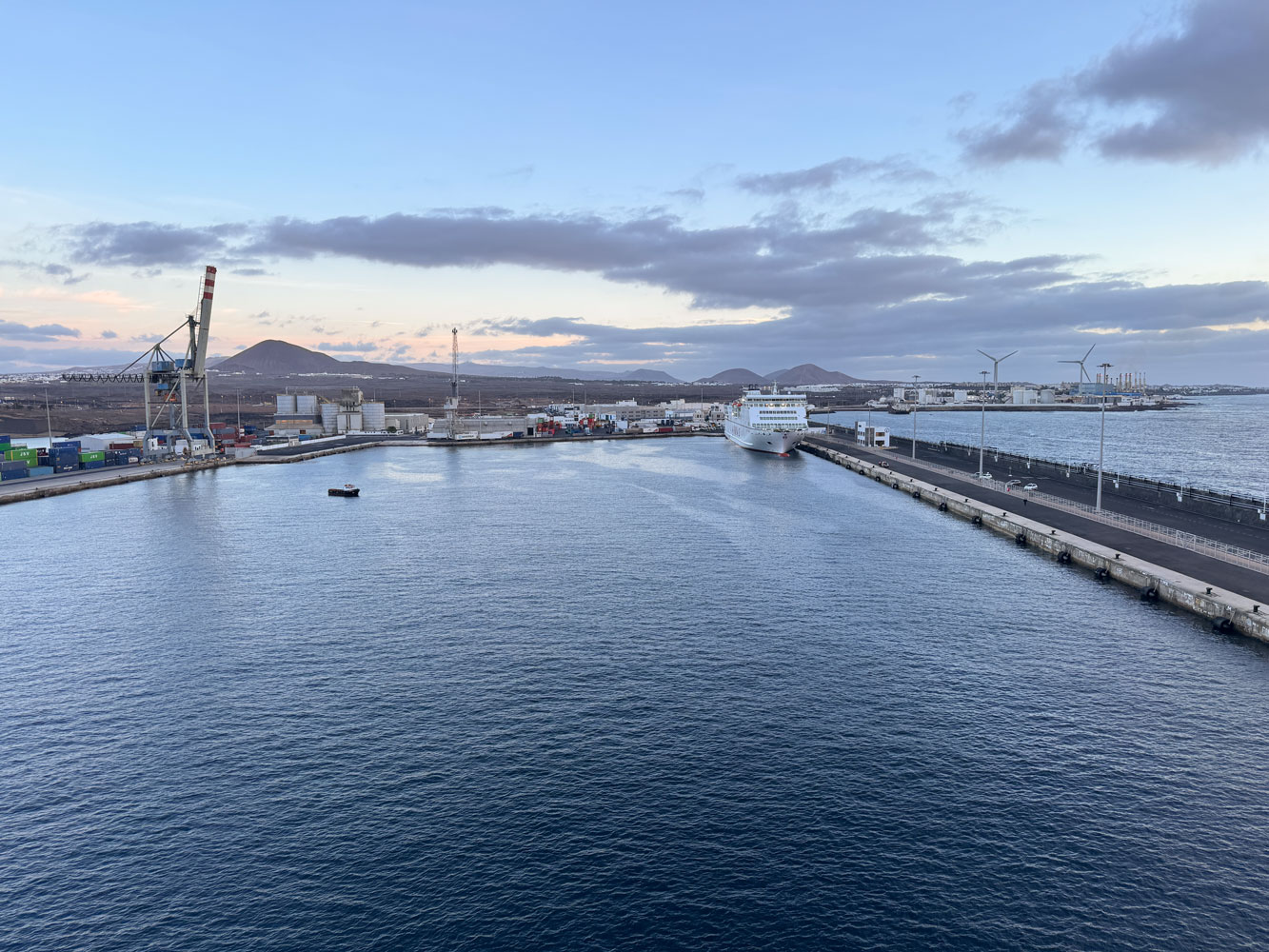
We have a tour of the island today, beginning at the Timanfaya National Park. We drove through several towns on the way to the park - the homes are all painted white and are no more than about two stories.
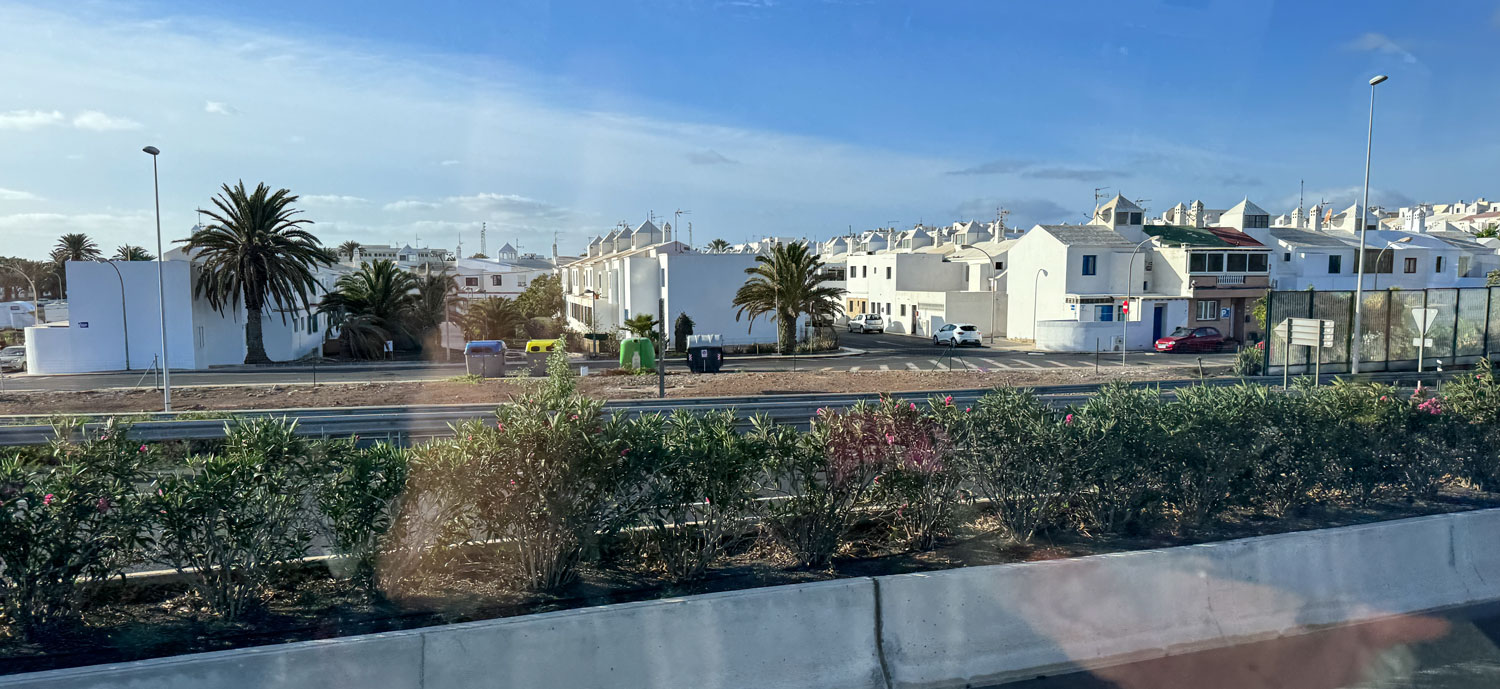
The park is quite large and has a visitor's center in it. I didn't get a picture of the building when we arrived but did find this one on the web.
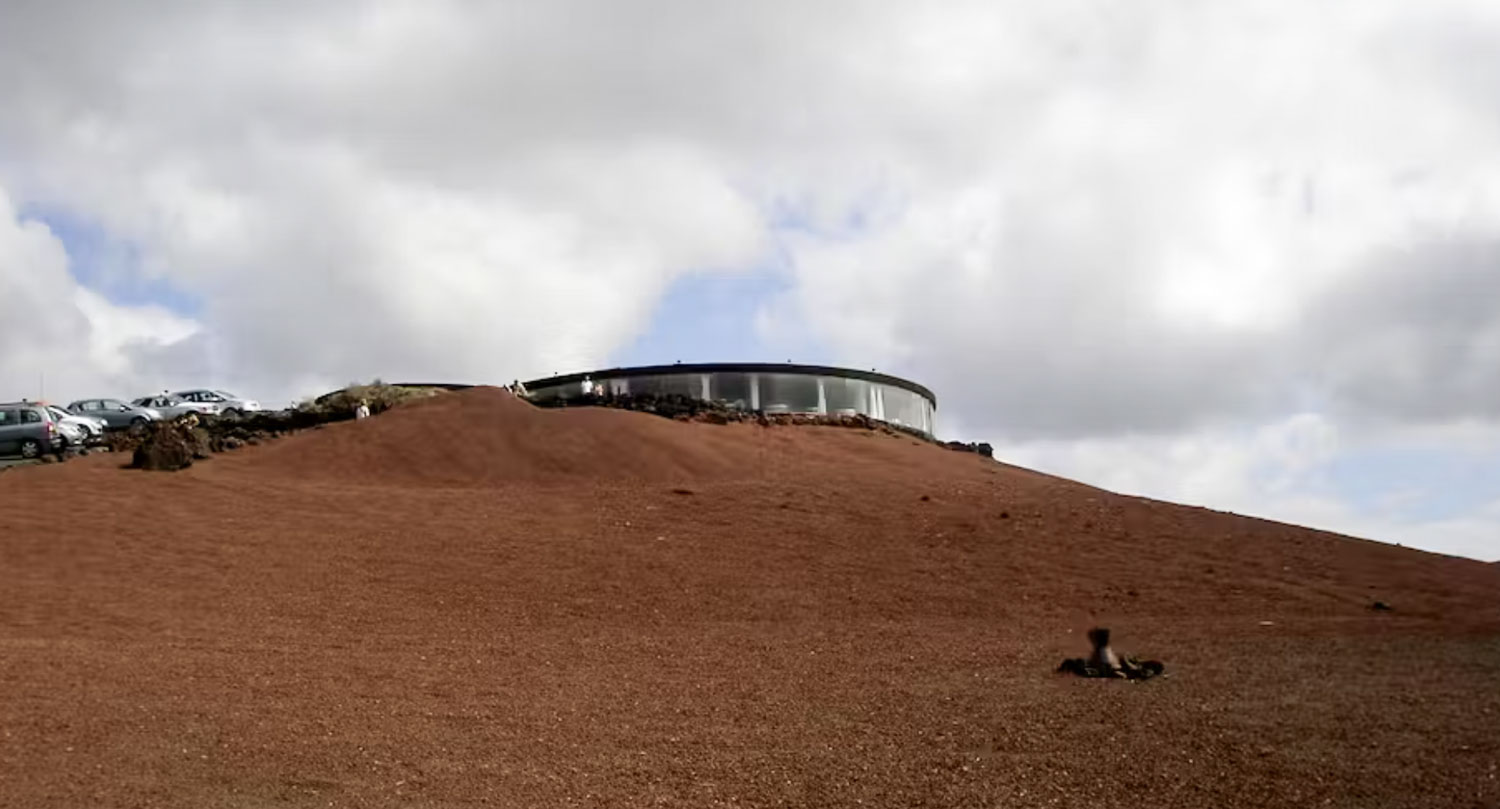
Here's the entry.

The visitor's center is built on top of the volcano, and the land under it is quite hot. They did some demonstrations to show how hot it is. In this demonstration, there was a hole, perhaps 20 feet deep, and the worker dragged some dried brush into the hole. It quickly caught fire.
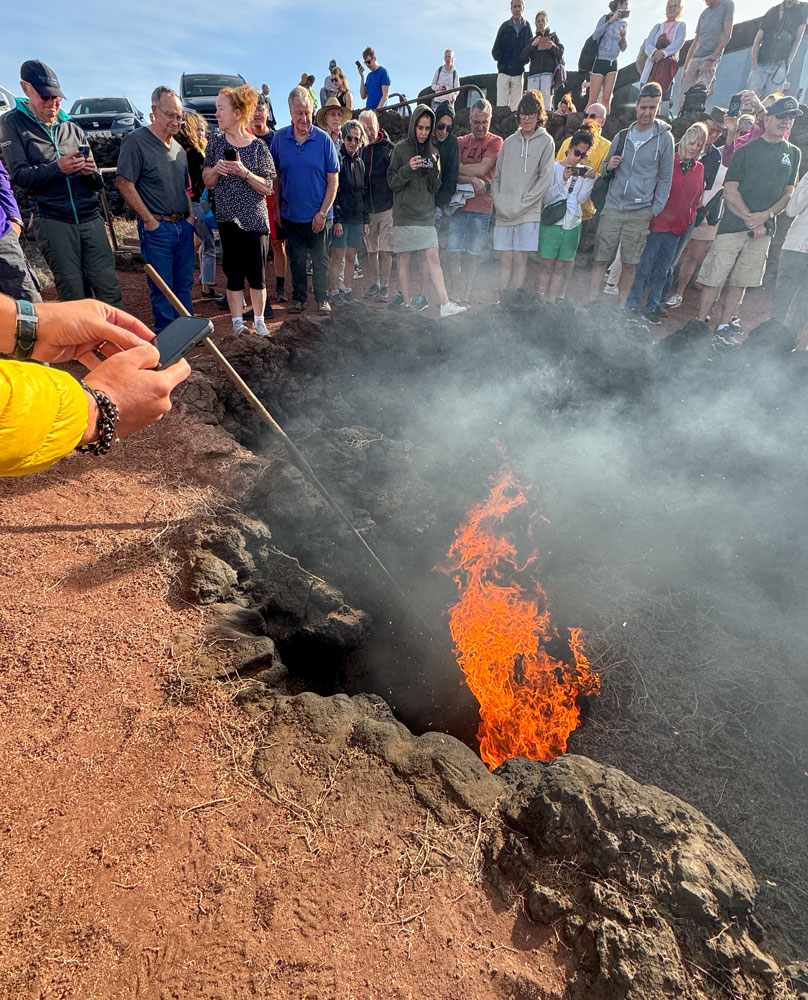
They have put some pipes into the ground outside the visitor's center and they demonstrate how hot the ground is by pouring a bucket of water into one of the pipes. The water quickly boils and come up as a geyser.
They've made a stove by digging down into the volcano, and placing a grill over the hole. They use that to cook on.
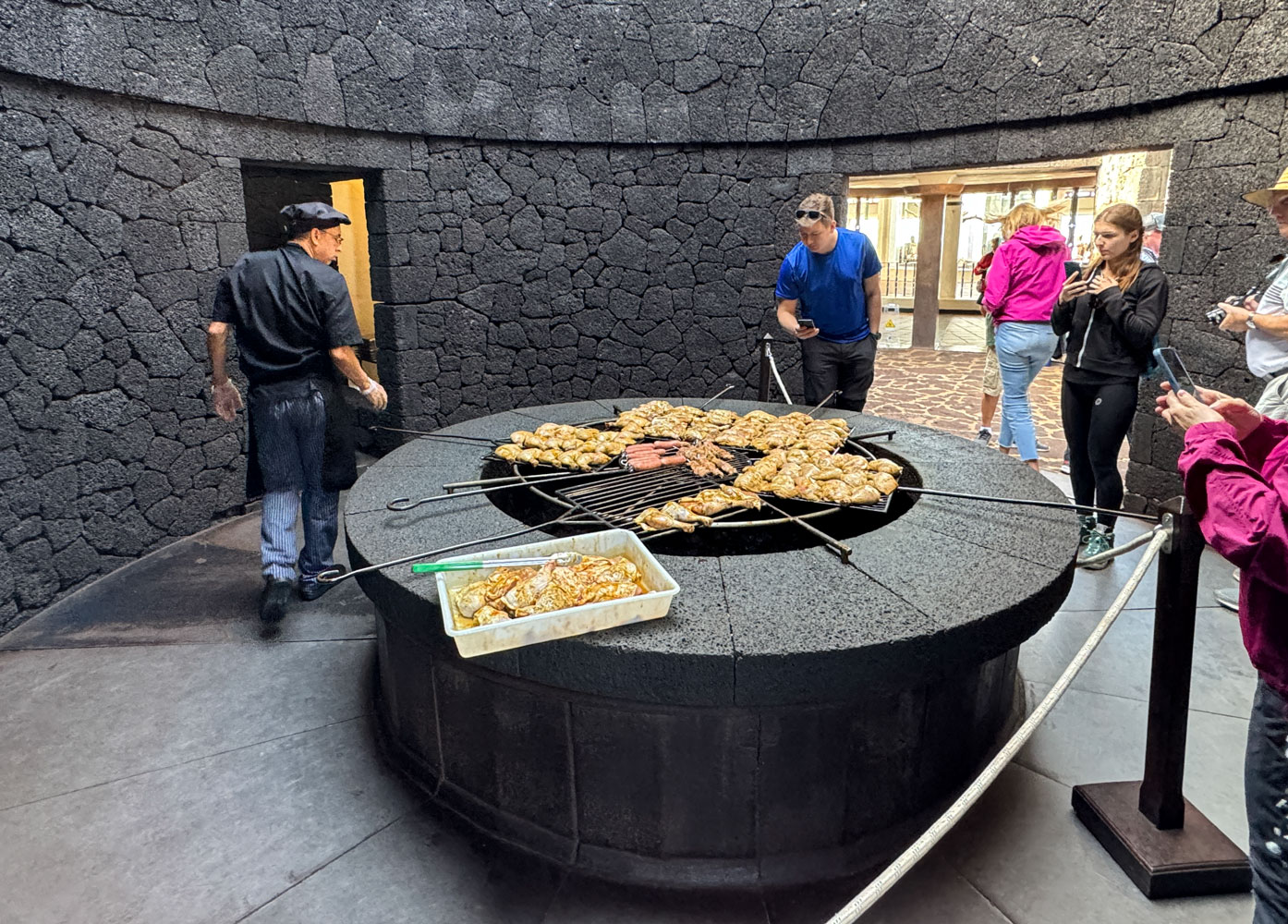
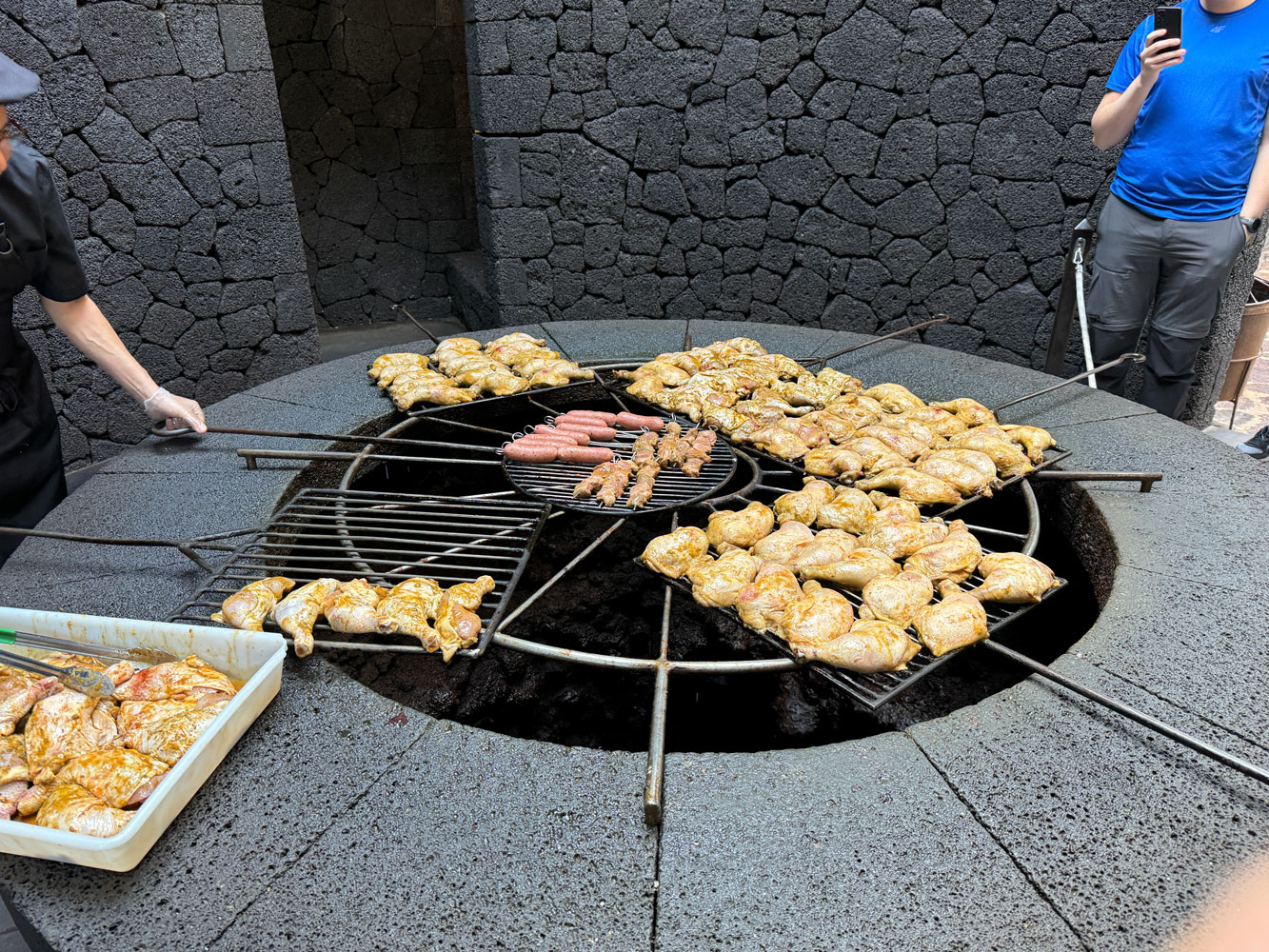
After spending some time at the visitor's center, we boarded the bus for a drive through the park. As we left the visitor's center, I was able to get this picture of it. It's much bigger than it seemed.
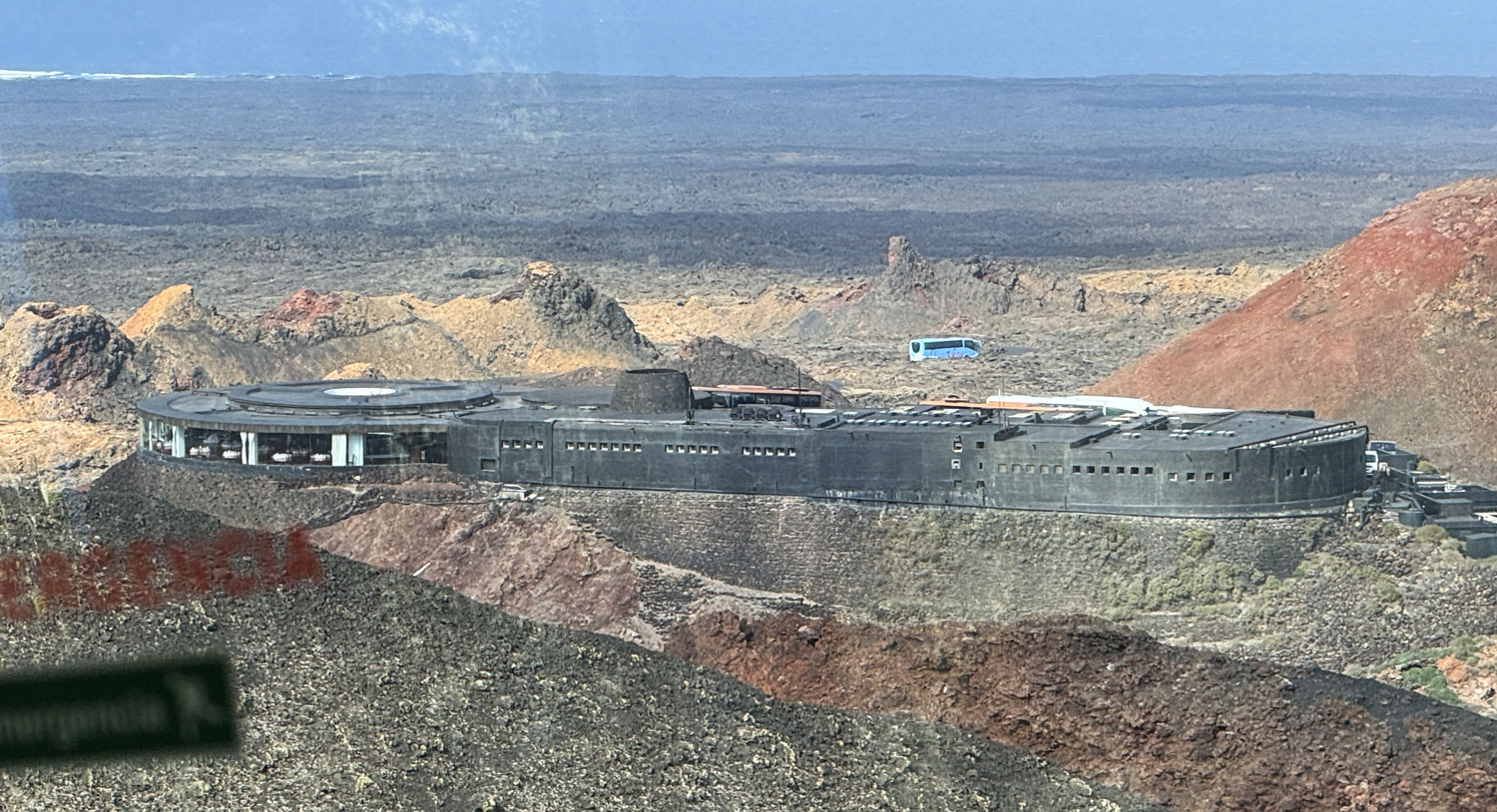
It was a long ride through the park, but I didn't take many pictures. Here is one of the calderas of the volcano.
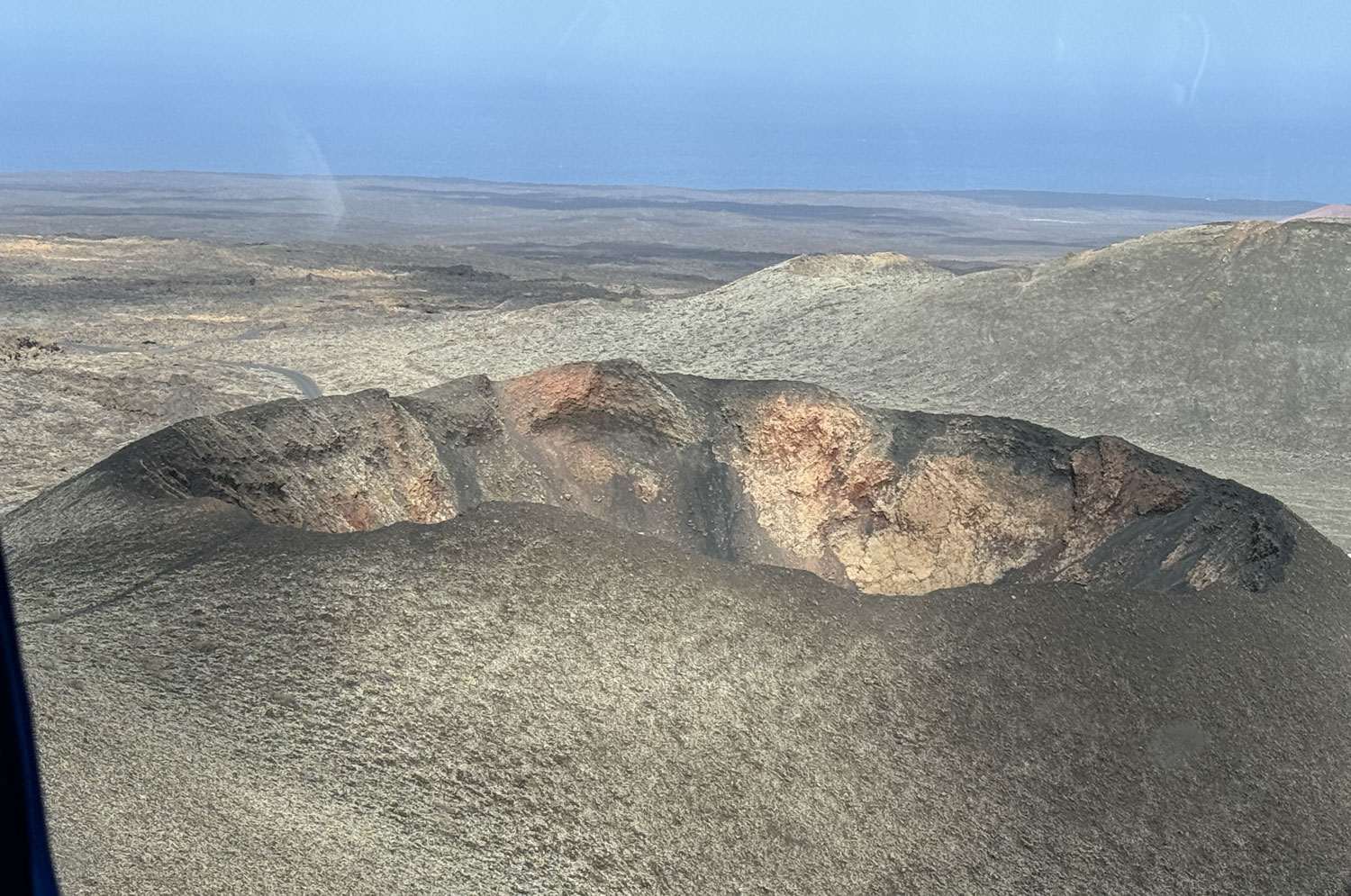
The park is very popular. Cars were backed up to get into the park - on a Wednesday.

After we left the park, we went to a simple wine tasting, and encountered something we were to see often. The island is very dry and there is an almost constant wind from the NE. The farmers have planted grape vines and have erected stone walls on the north side of each plant to protect it from the wind. In some cases, they have dug a hole before planting the vine, to further protect it from the wind, and to collect the scant rainfall they receive.
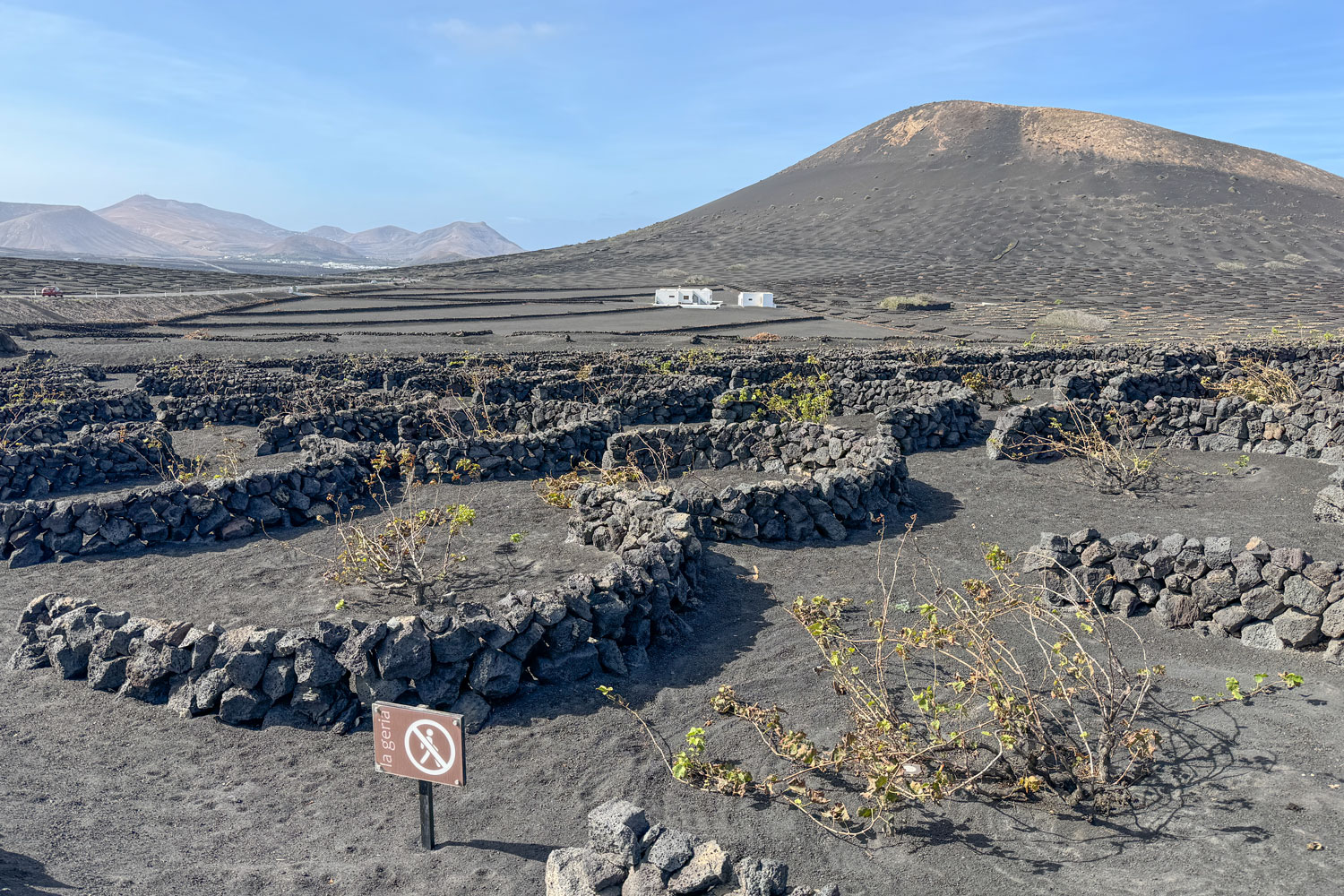
All of those "scallops" you see on the hill side are low walls protecting a vine plant. Think of the work that went into building all of those.
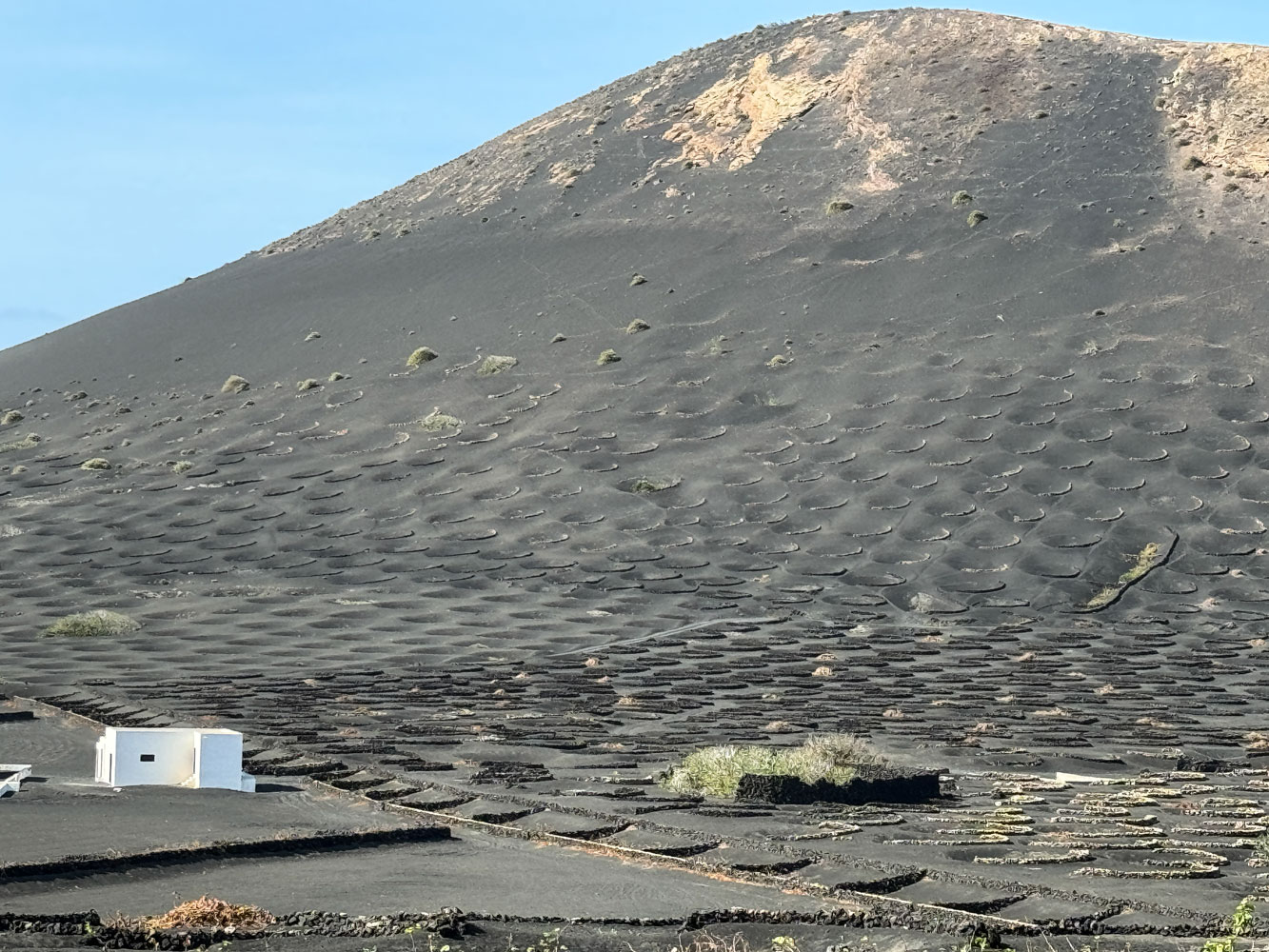
From here, we went to lunch at a nice restaurant. The dining room was built into the ground and had a domed roof.
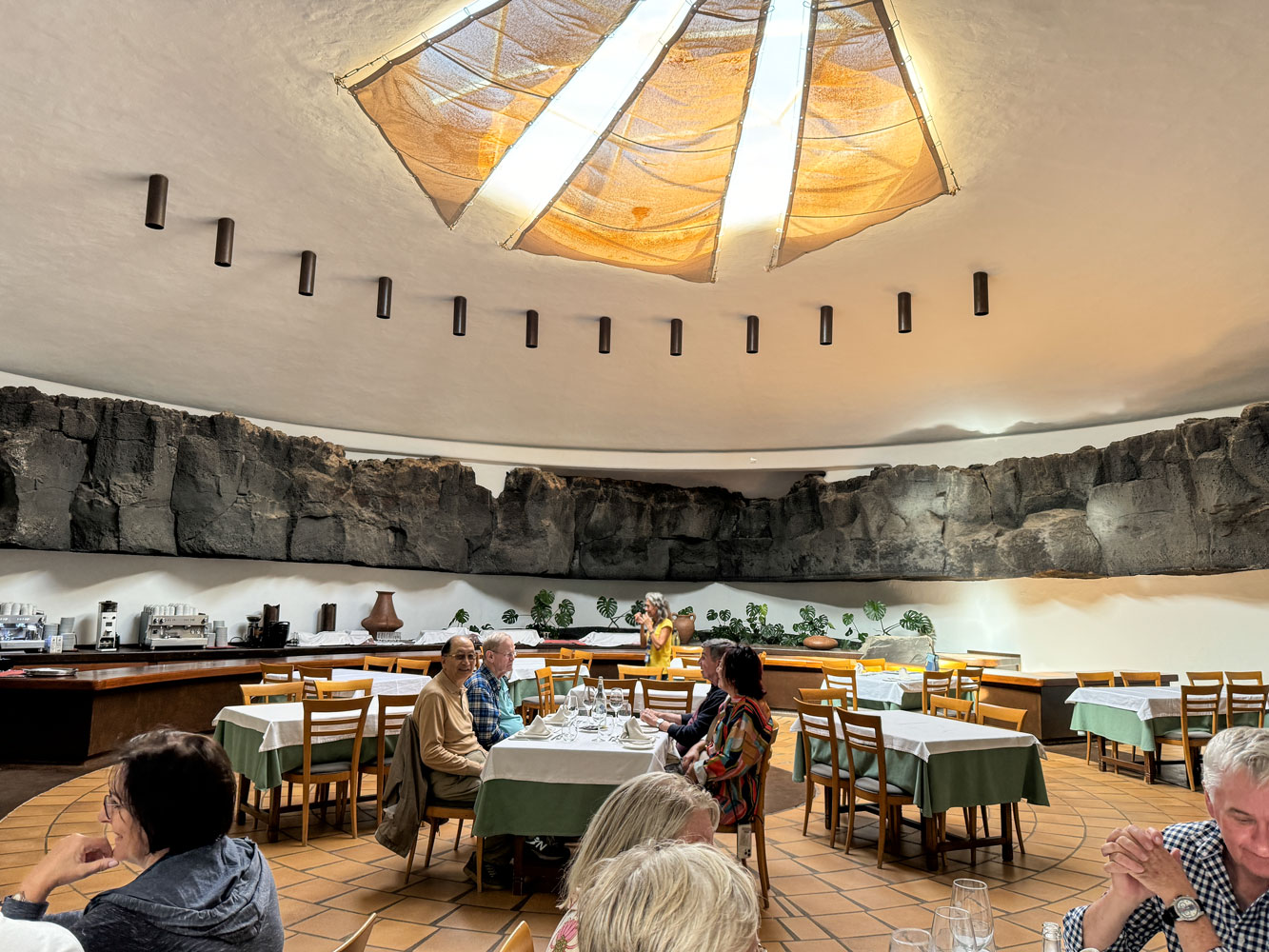
Richard and Eva at lunch
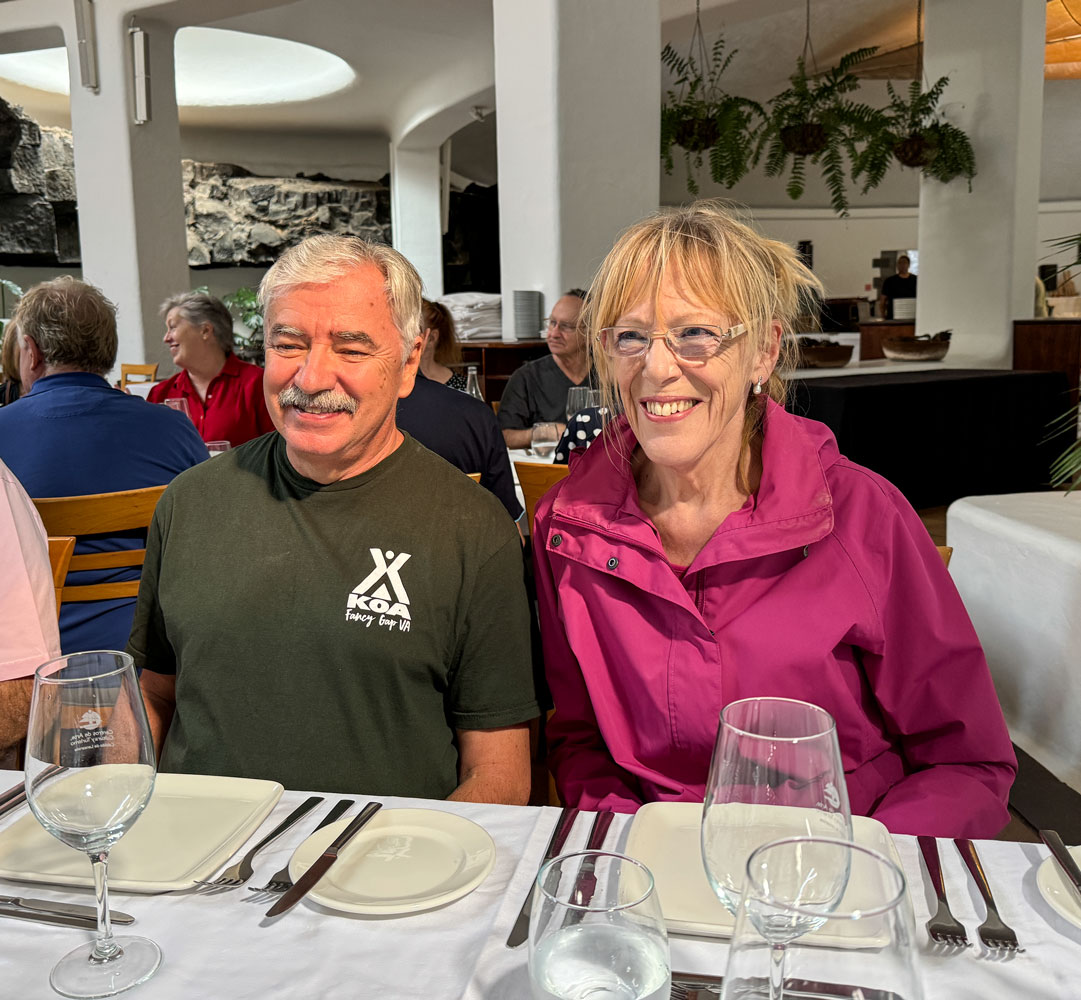
As we were leaving the restaurant, Judy took this picture of a tree in front of the restaurant. Notice that there's a wall protecting the tree from the wind, but the tree has outgrown the wall. Now, the tree is permanently shaped by the wind.

After lunch we drove to Mirador del Rio, a house on a high bluff in the north of Lanzarote.
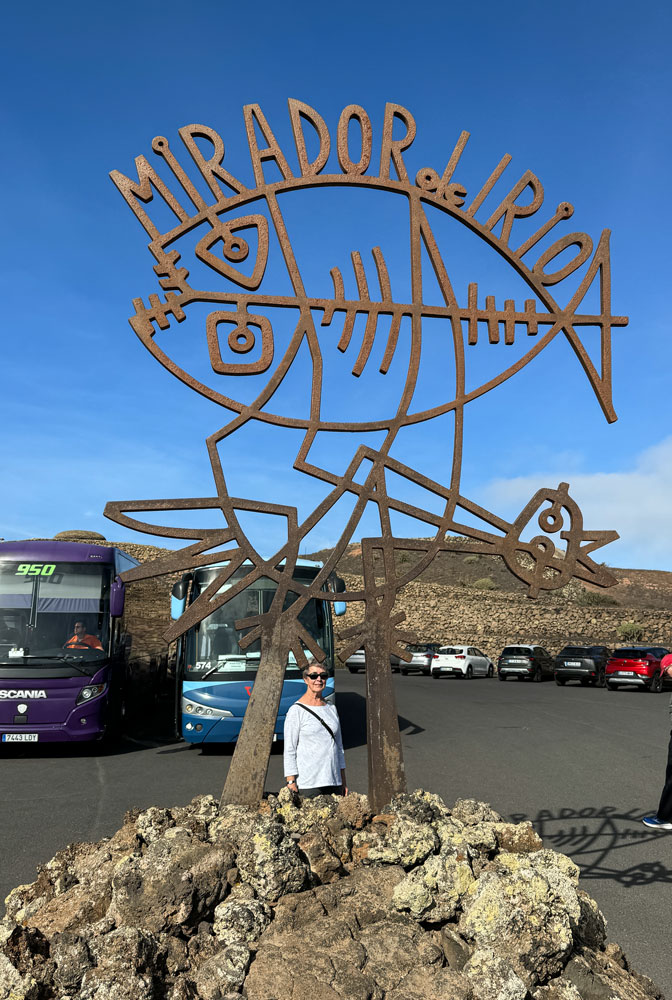
The house was created between 1971 and 1973 by César Manrique. We were able to take some pictures of the Strait of El Rio between the islands of Lanzarote and La Graciosa, and the surrounding area.
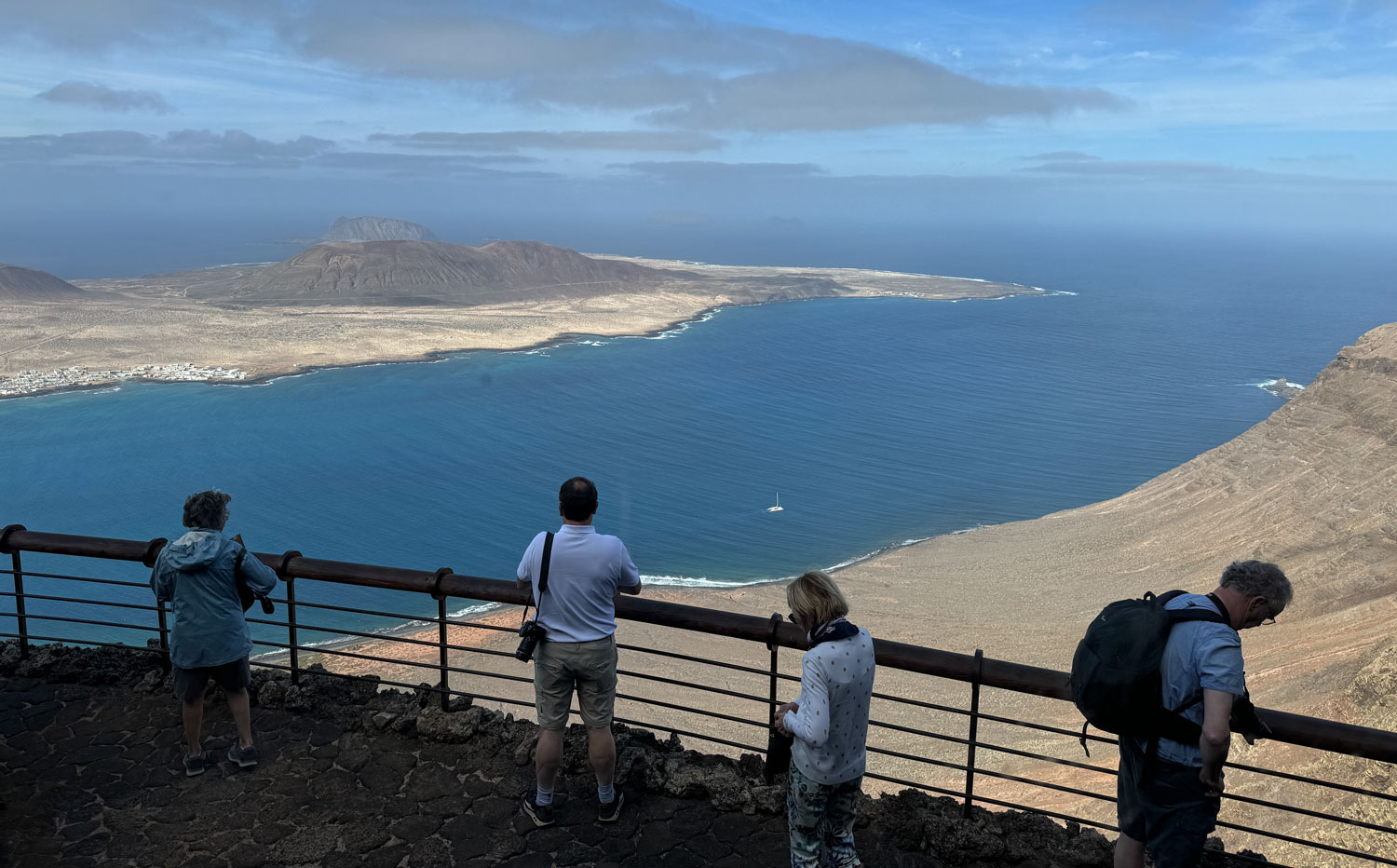
From here, you can see the town of Caleta de Sebo, which is actually on the island of La Graciosa, off the northern tip of Lanzarote.

From here we went to Jameos del Agua, which was also developed by César Manrique, and is developed in a lava tube. This sculpture was at the entrance.
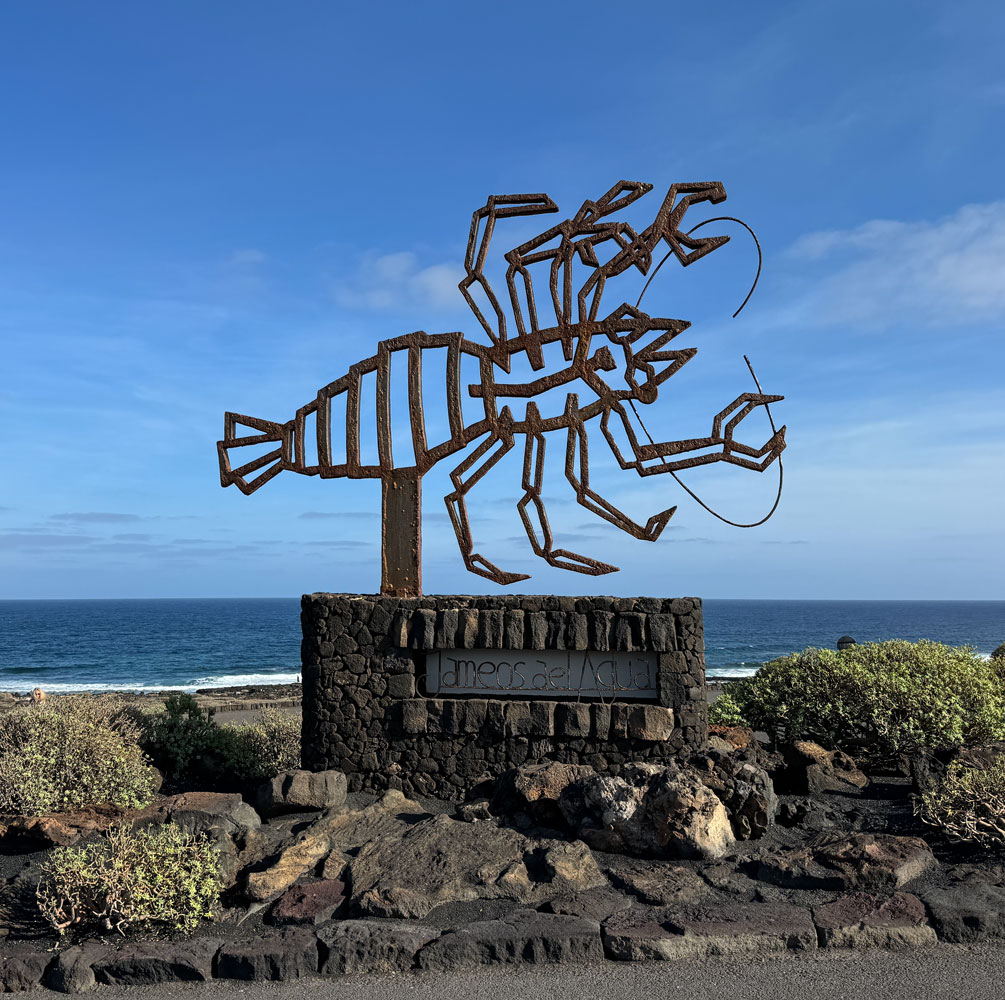
Steps descend two levels to enter the lava tube.
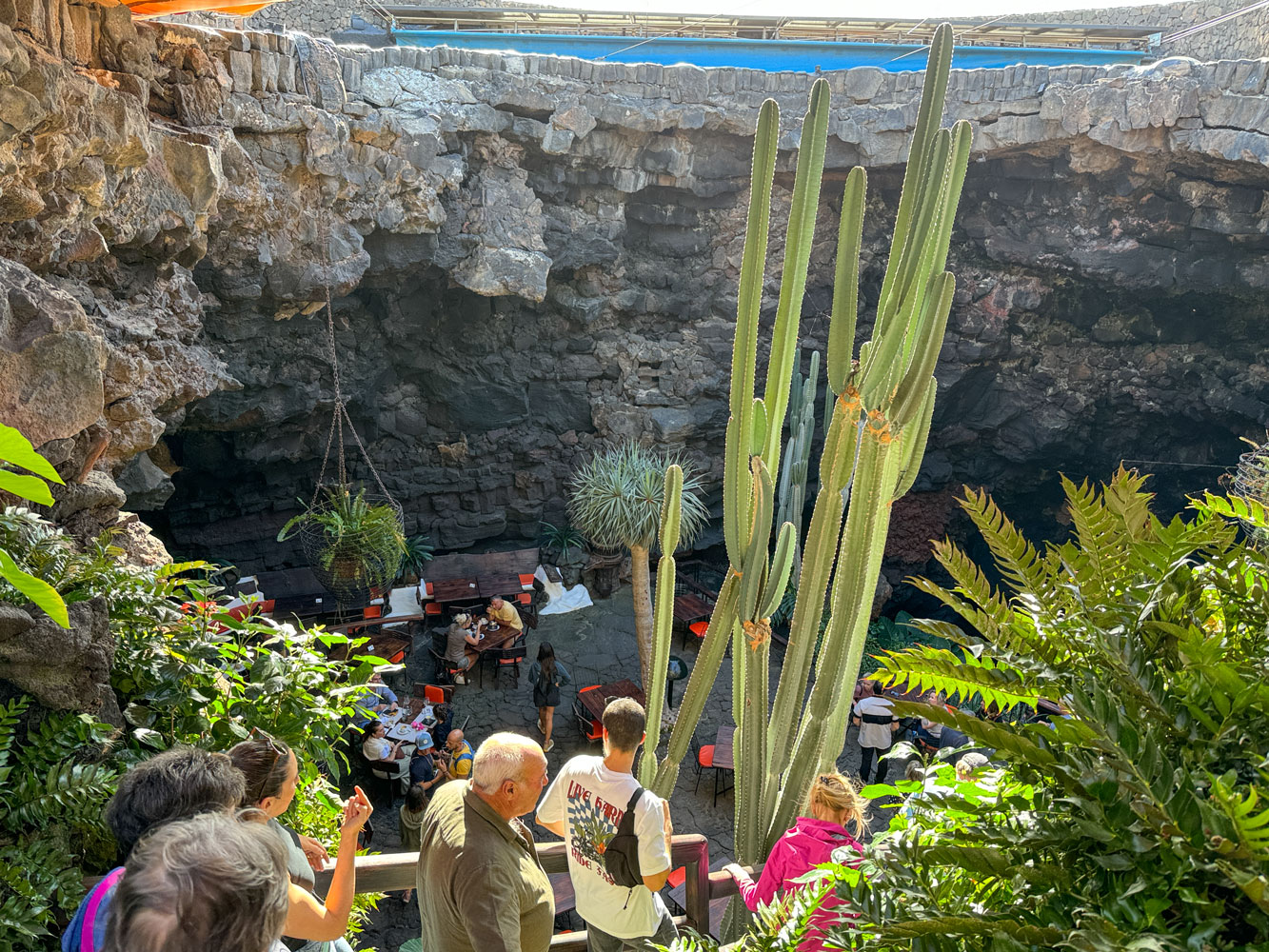
At the bottom is a salt water lake with some marine animals. This water has been isolated from the ocean nearby for so many years that certain tiny crabs have evolved that don't exist anywhere else.
The path leads along the side of the lake toward the end of the tube.
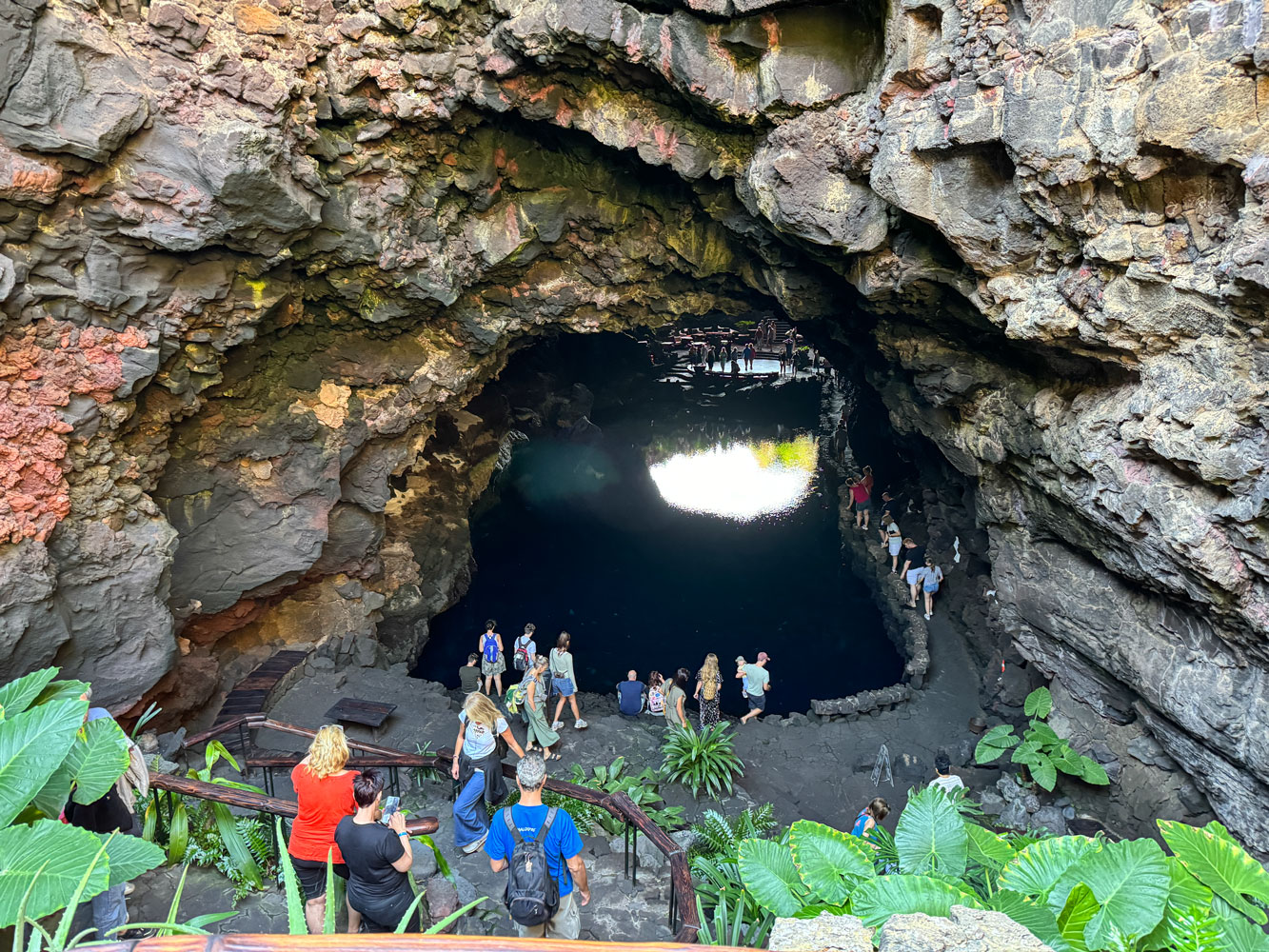
The view from the other end of the lake. You can see the stairs across the lake that led down to this level. Also note the hole at the top of the cave, where the top of the lava tube collapsed ages ago. This may have been the way the lava tube was originally discovered.
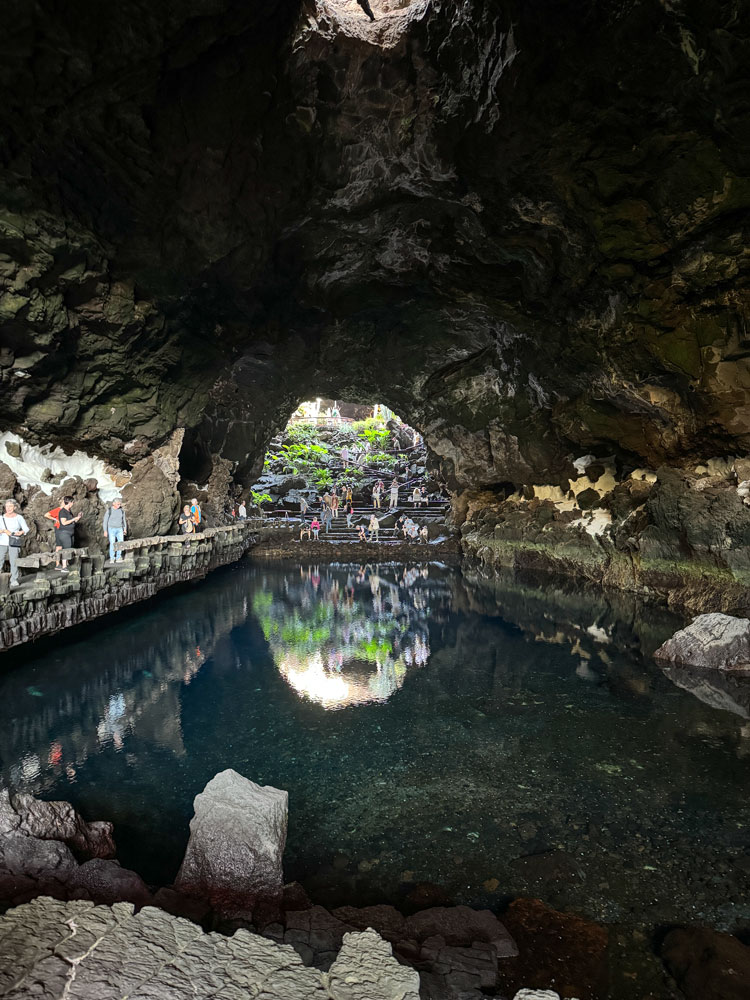
There's a small cafe at this end of the tube, and we shared a chocolate cookie.
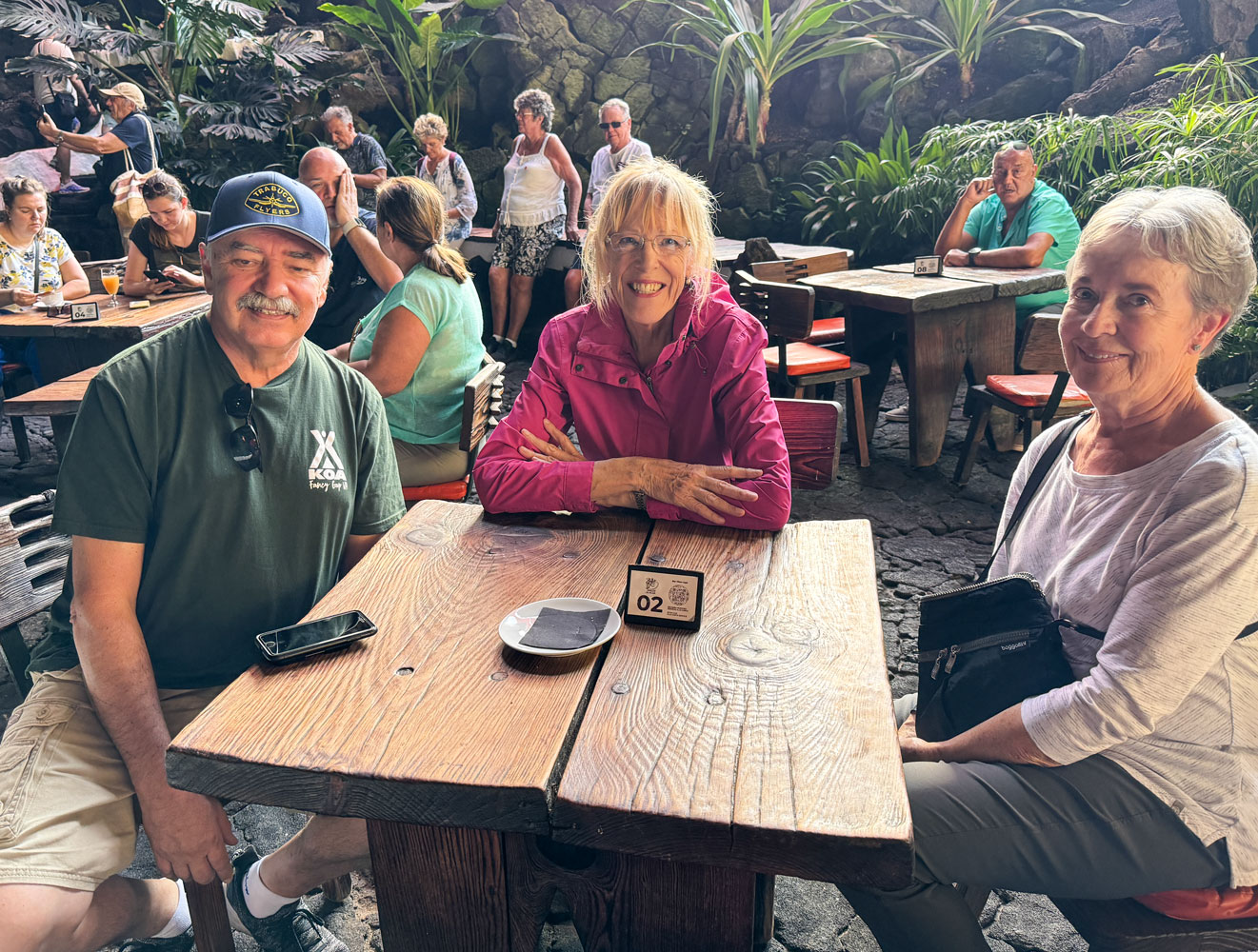
We went up another flight of stairs and found a modern swimming pool.
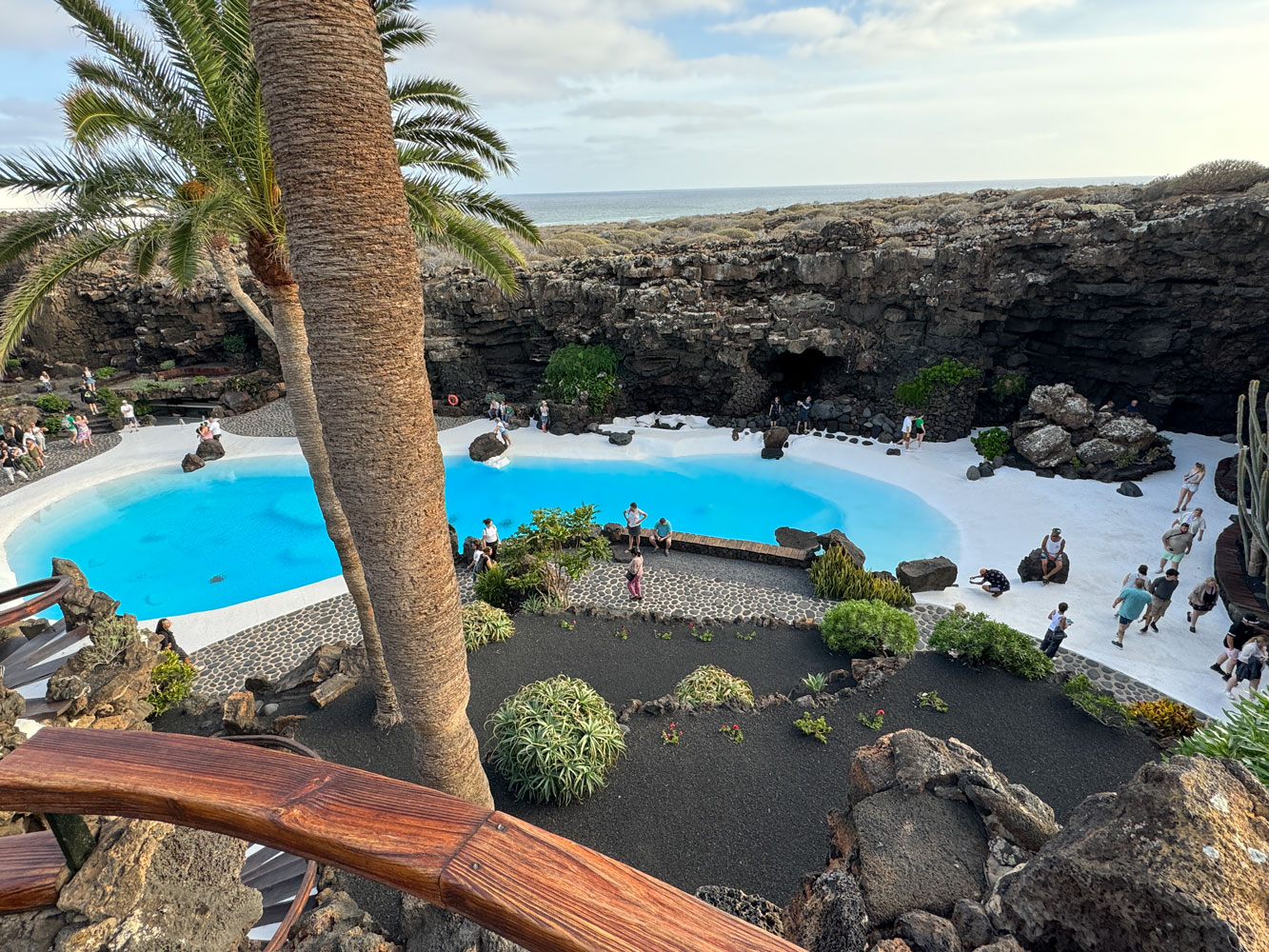
And at the end of the swimming pool (right side of the above picture) we found an entrance to a concert hall. It must be a fabulous experience to play a concert on that stage.
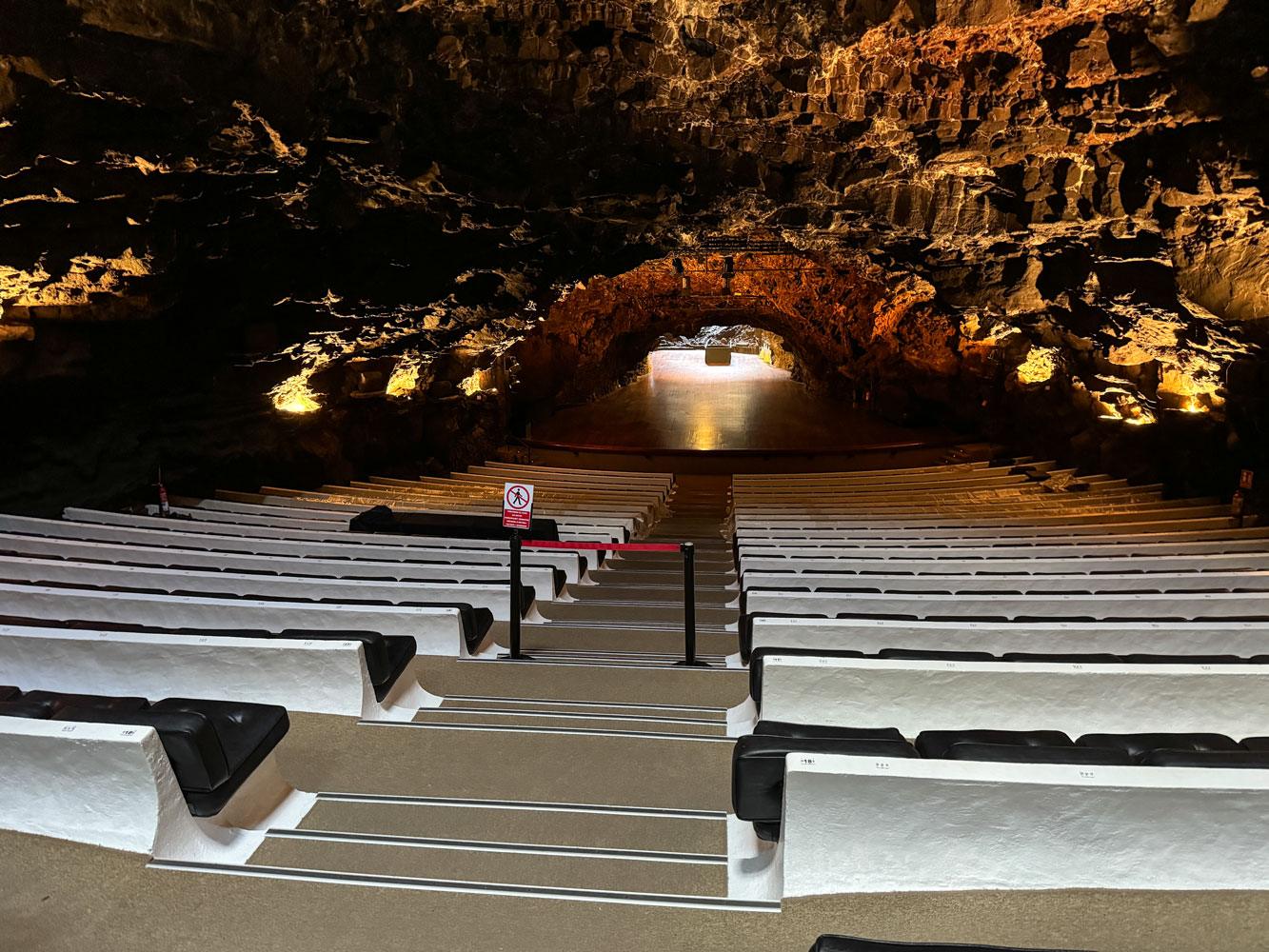
We then returned to the ship for dinner with Richard and Eva. Then it was to bed.
+++++++++++++++++++++++++++++++++++++++++
11/23/2023 (Thursday, Thanksgiving Day) We sailed to Tenerife (pronounced "ten a ree fay") during the night and were at Santa Cruz de Tenerife in the morning. People of a certain age will remember Tenerife for the disaster that occurred at the airport on March 27, 1977 when two 747 aircraft collided on the runway. It was the deadliest aircraft accident in history, with 583 fatalities.
Tenerife is larger than Lanzarote, about 785 square miles, a bit larger than Maui which is about 727 square miles.
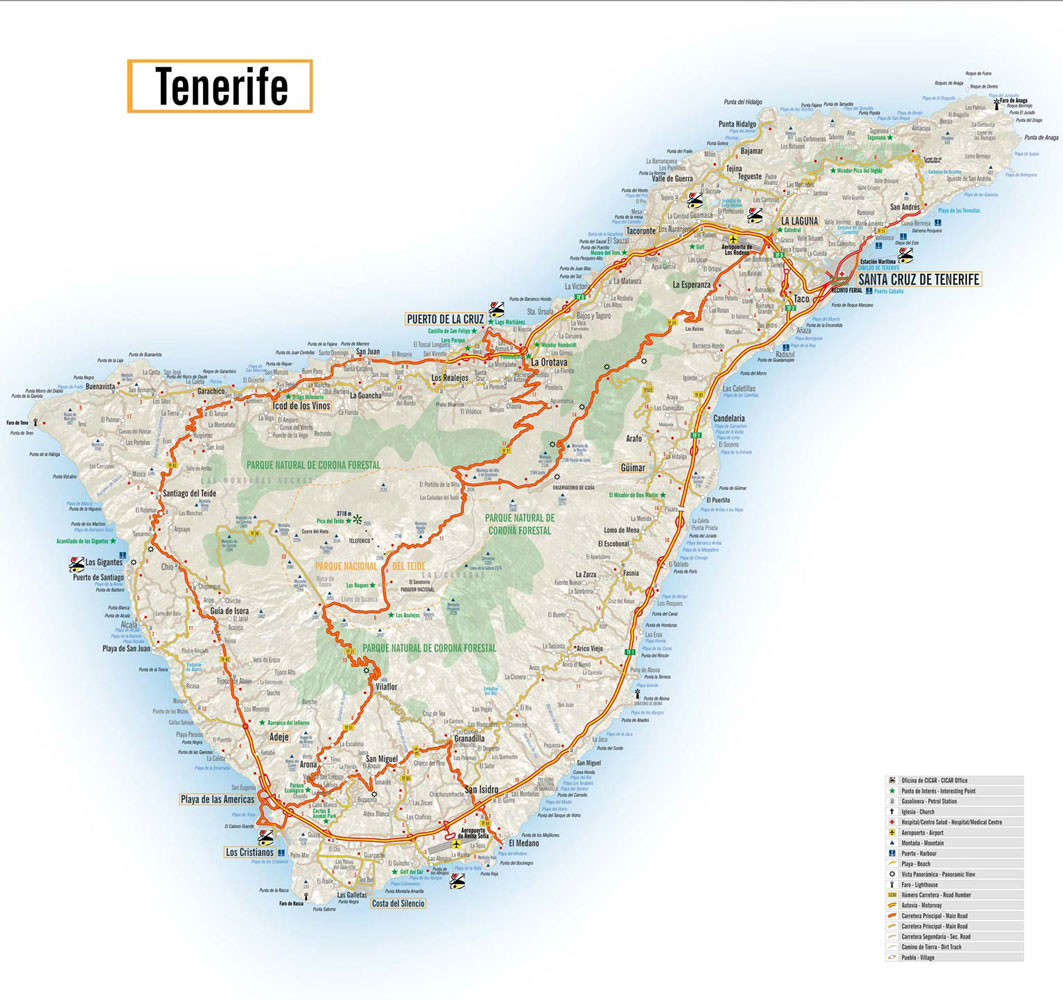
Our bus tour of Tenerife began with a walking tour of the old town of Santa Cruz. Our tour guide had a strong accent, making it difficult to understand much of what she said. We first went to the Mercado Municipal La Laguna in Santa Cruz.
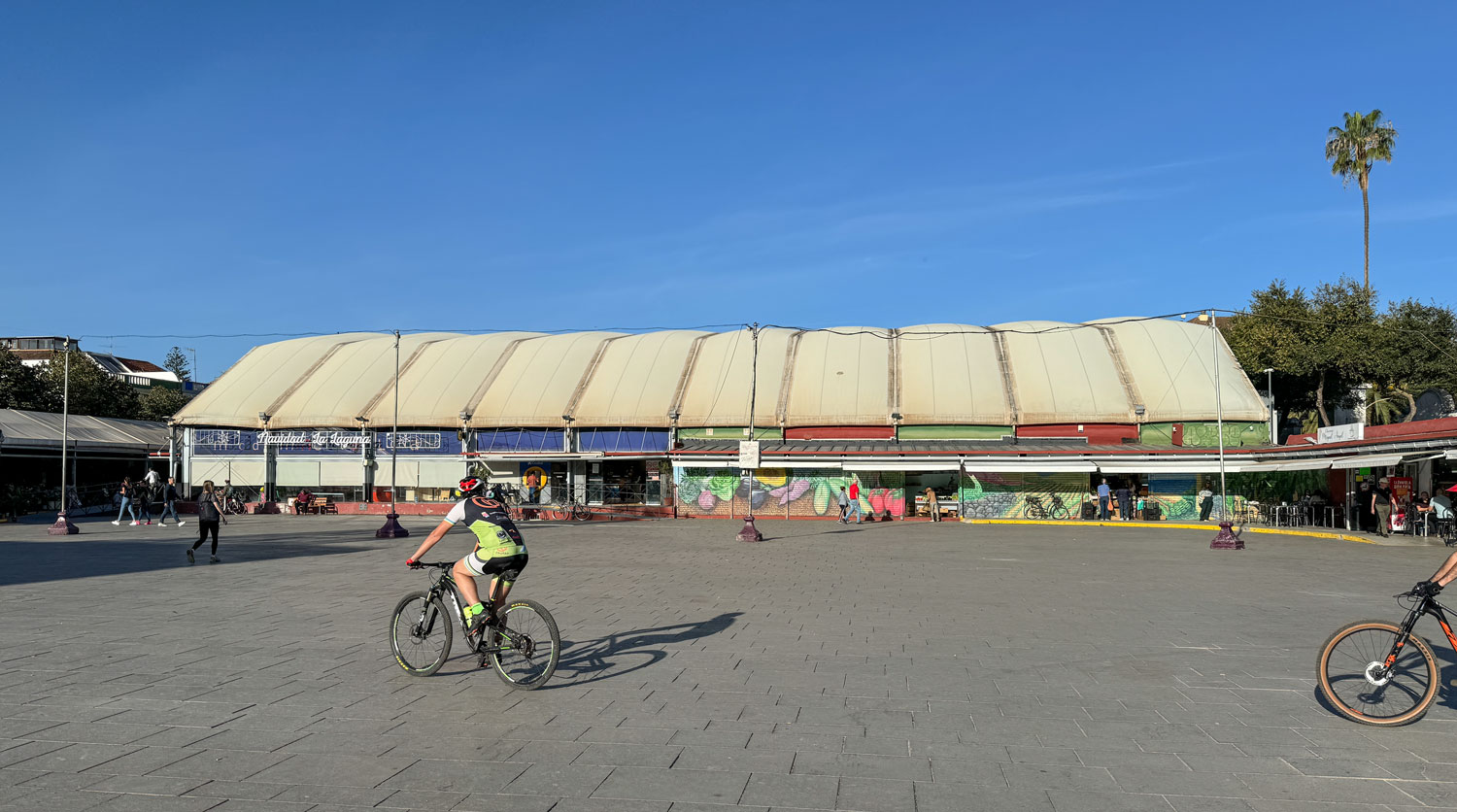
We walked along the streets of the Old Town. One interesting thing was that the streets were fairly wide. Many other Old Towns we've seen have very narrow streets.
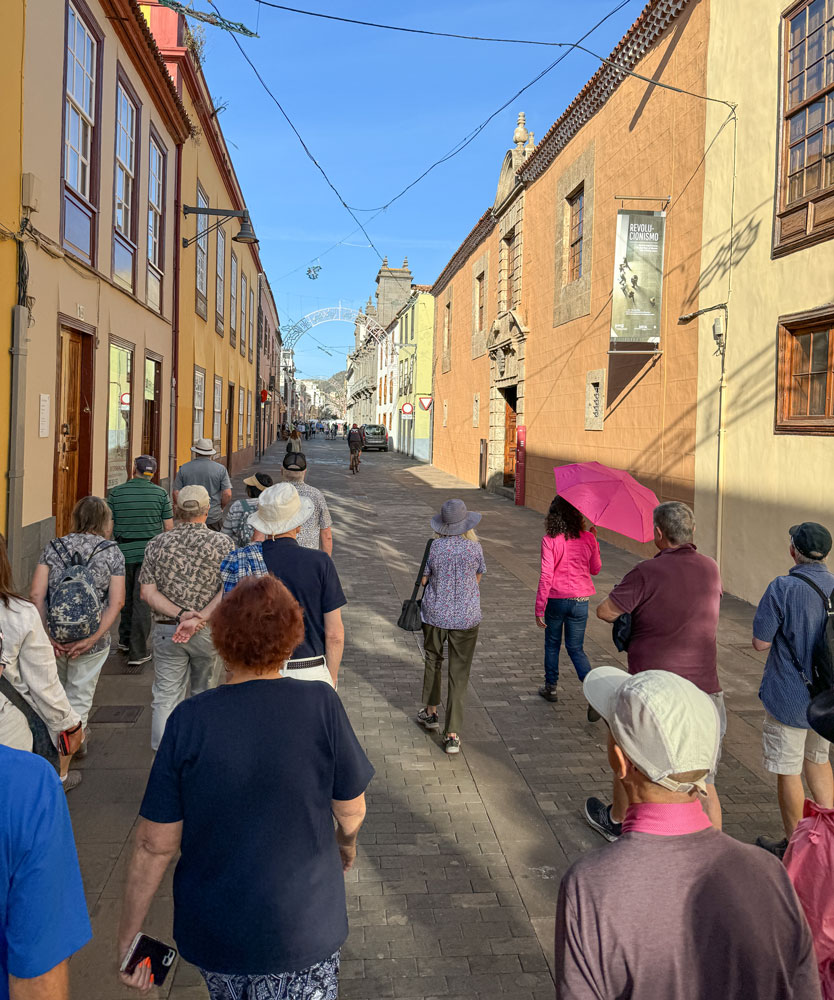
We went into several historic homes. They all had the same basic plan - they were built in a "U" shape with a central courtyard. That makes sense because the homes were built against each other and back-to-back, with no exterior windows. The courtyard gave them window, and perhaps balcony, access to the outside, and privacy.
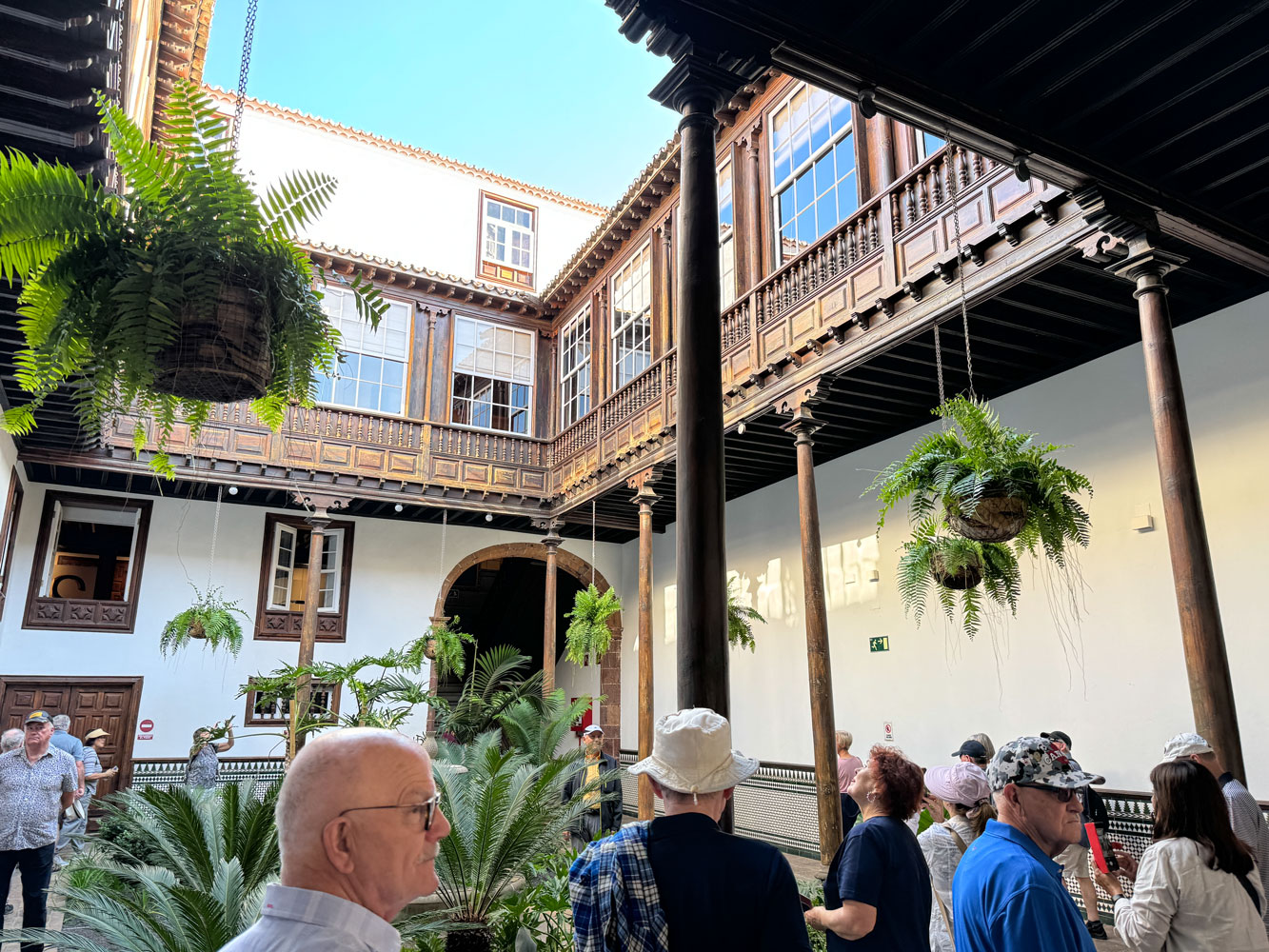
Here's another home with an even larger courtyard.
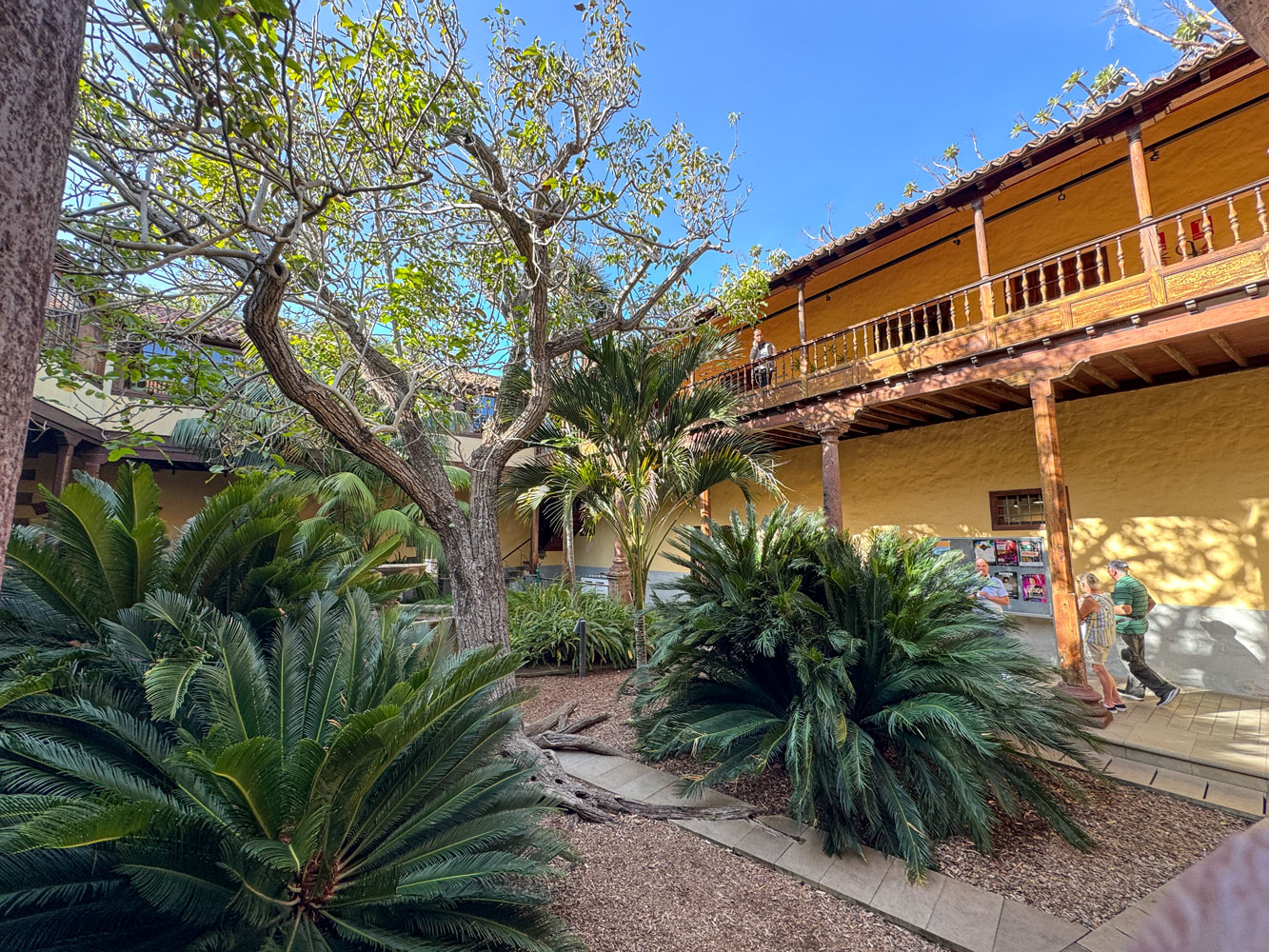
We walked by Iglesia y Exconvento de San Agustin, a church and former convent.
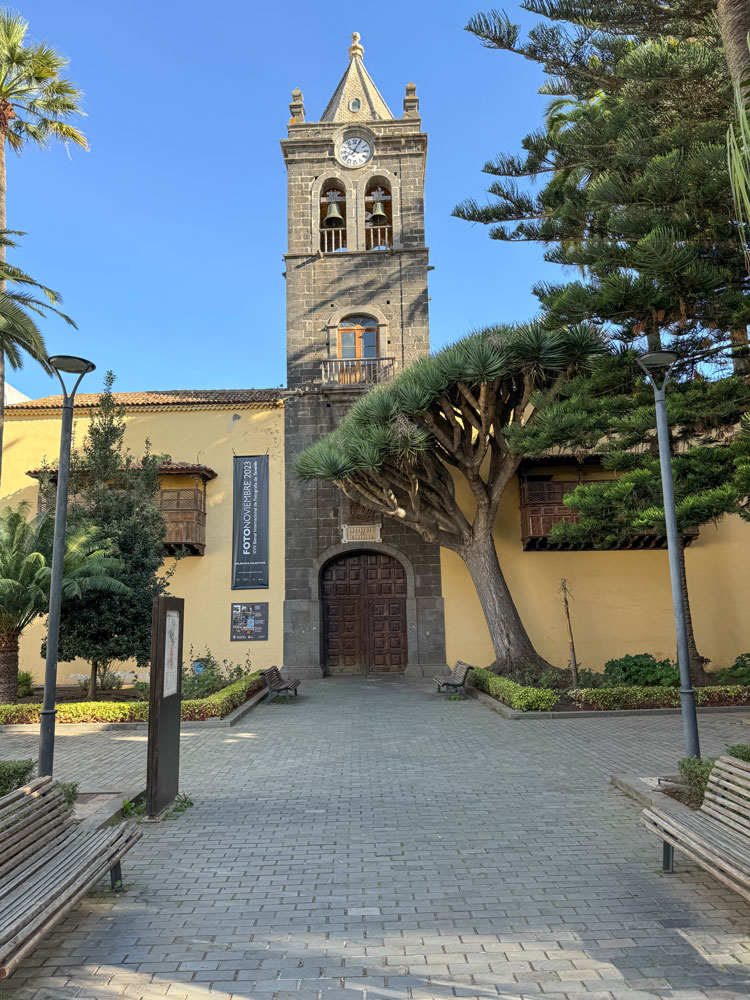
As we walked back to the bus, there was a demonstration by workers advocating for an increase in pay. The were organized but noisy.
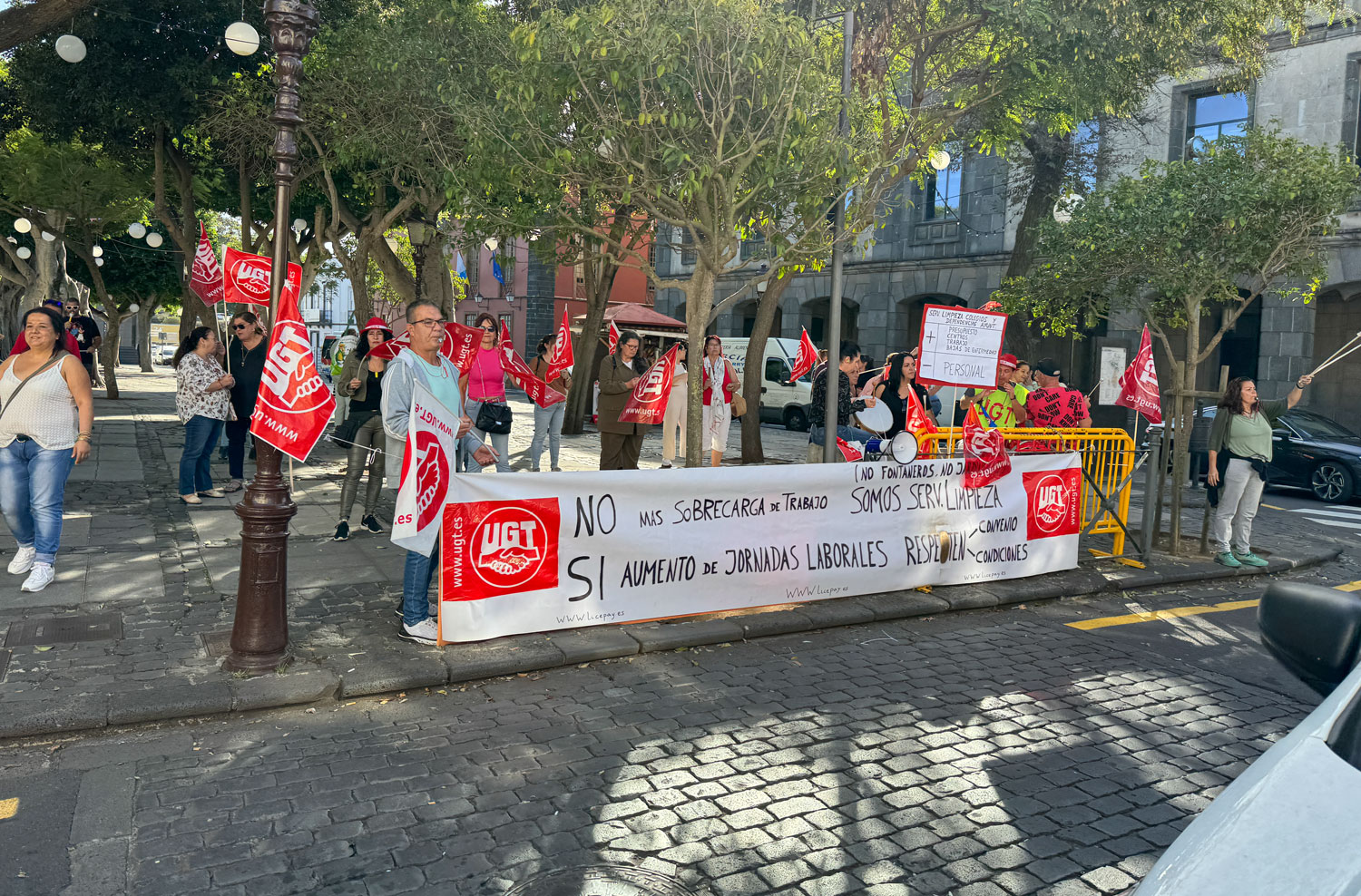
The bus took us to the town of San Pedro Daute, and the Plaza de la Libertad.
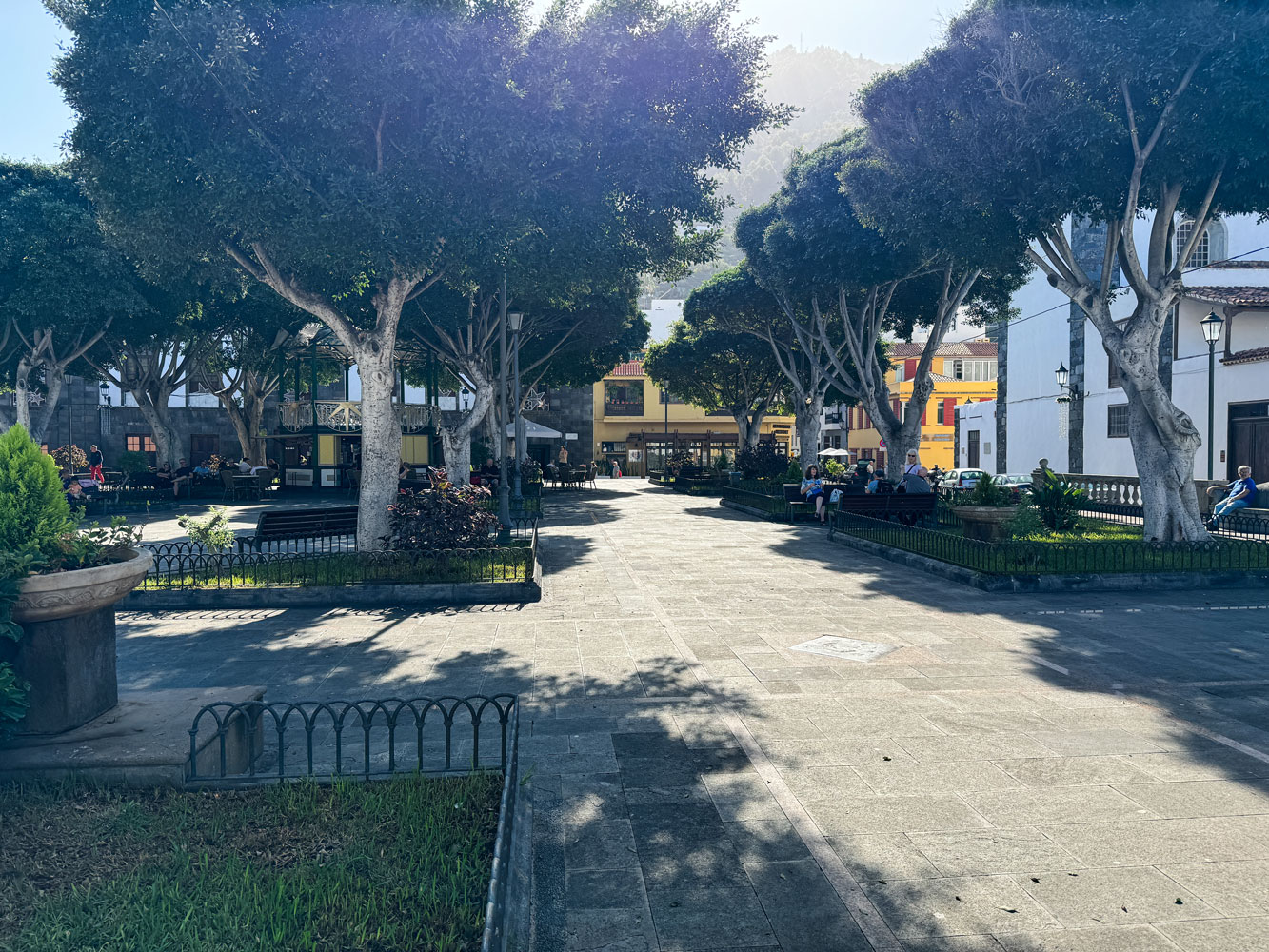
Near the plaza is the Convento de San Francisco. I didn't go in because they were charging €1 for entry.
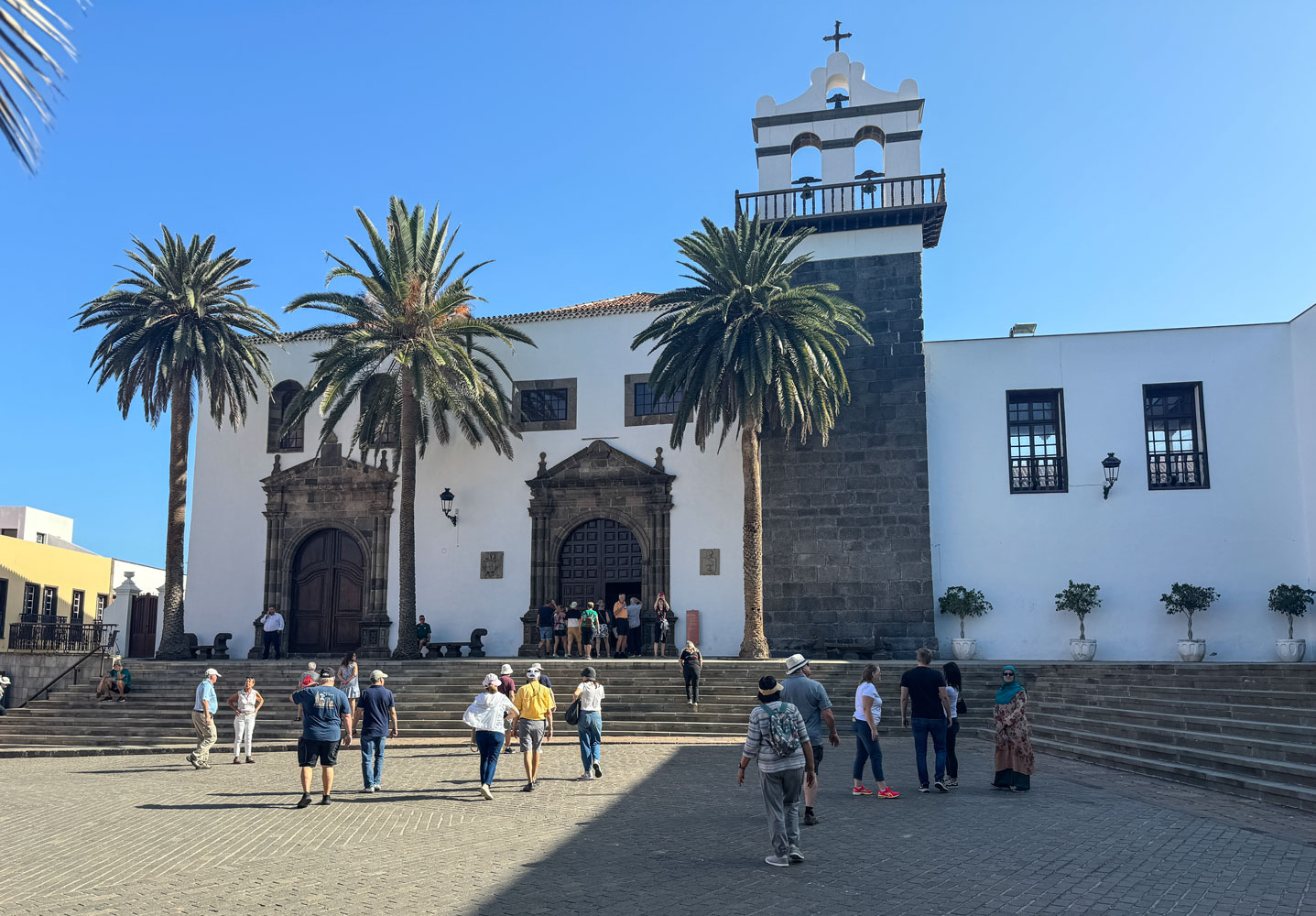
Judy and I walked around the town a bit, but there wasn't much that was interesting. We finally went back to the plaza and waited.
We went to Parque del Drago to see the El Drago Milenario. It is the oldest living specimen of a Dragon Tree.
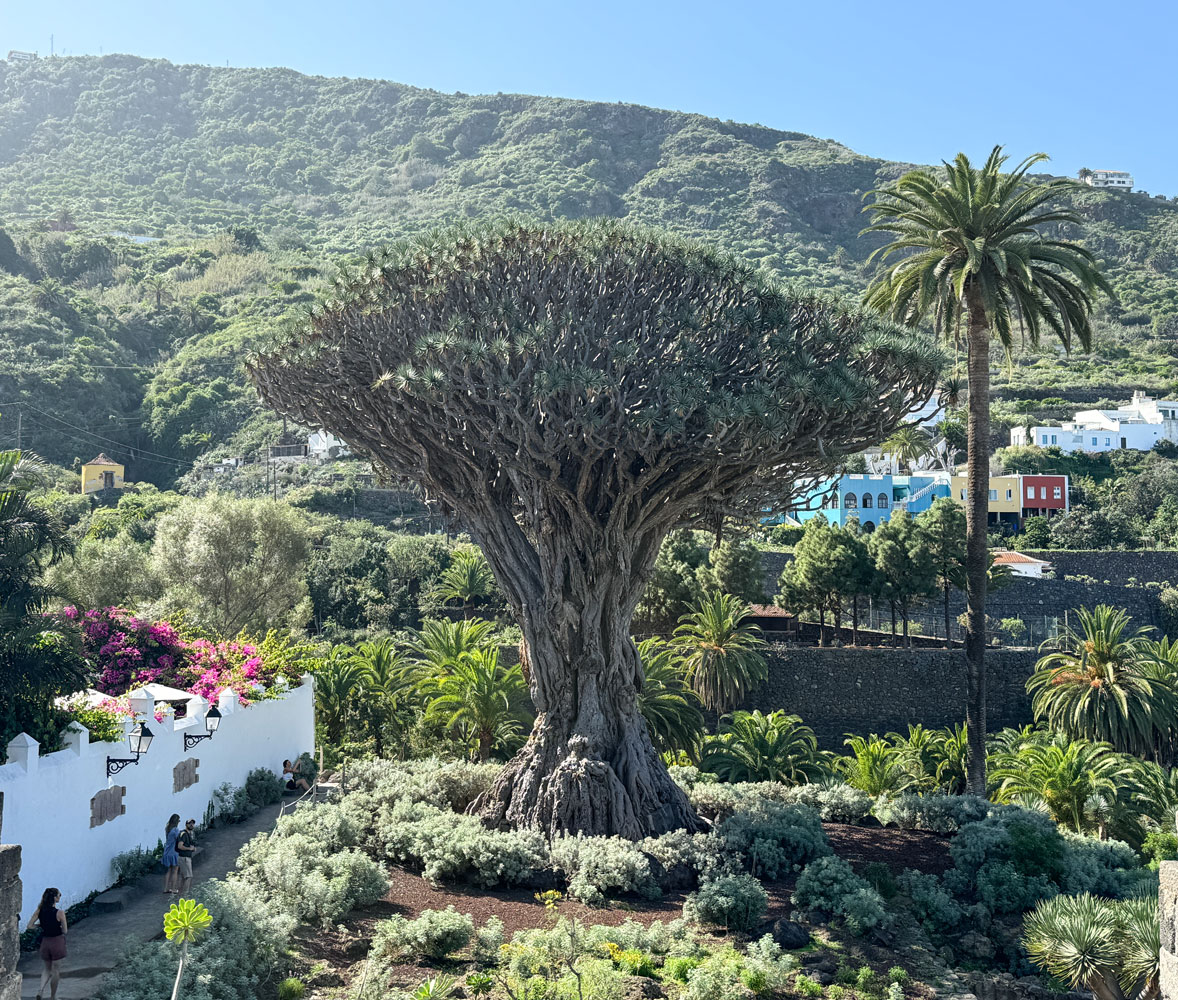
Then it was lunch time and we went to the restaurant.
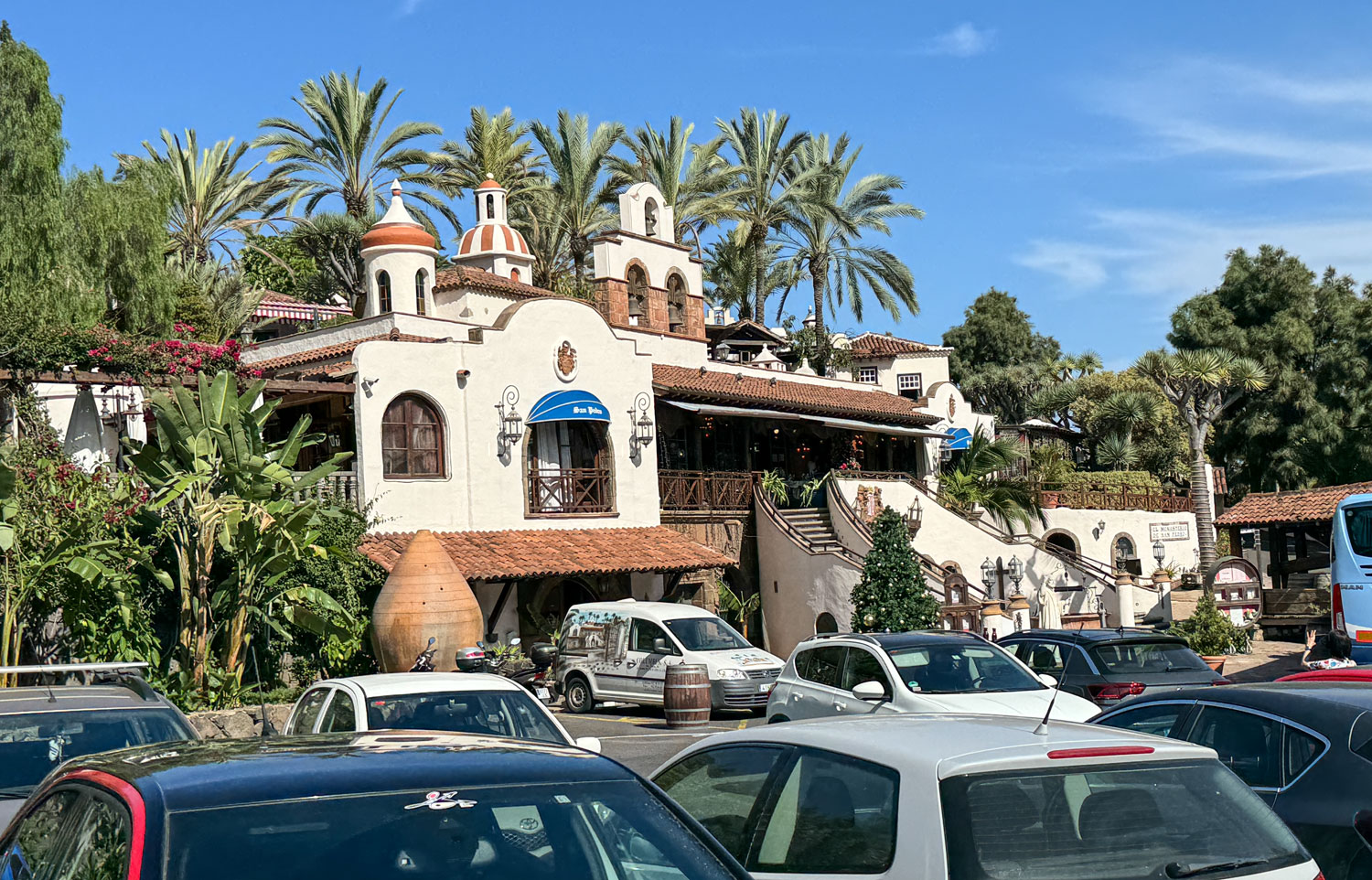
It was a real tourist restaurant, and packed, but the food was good.
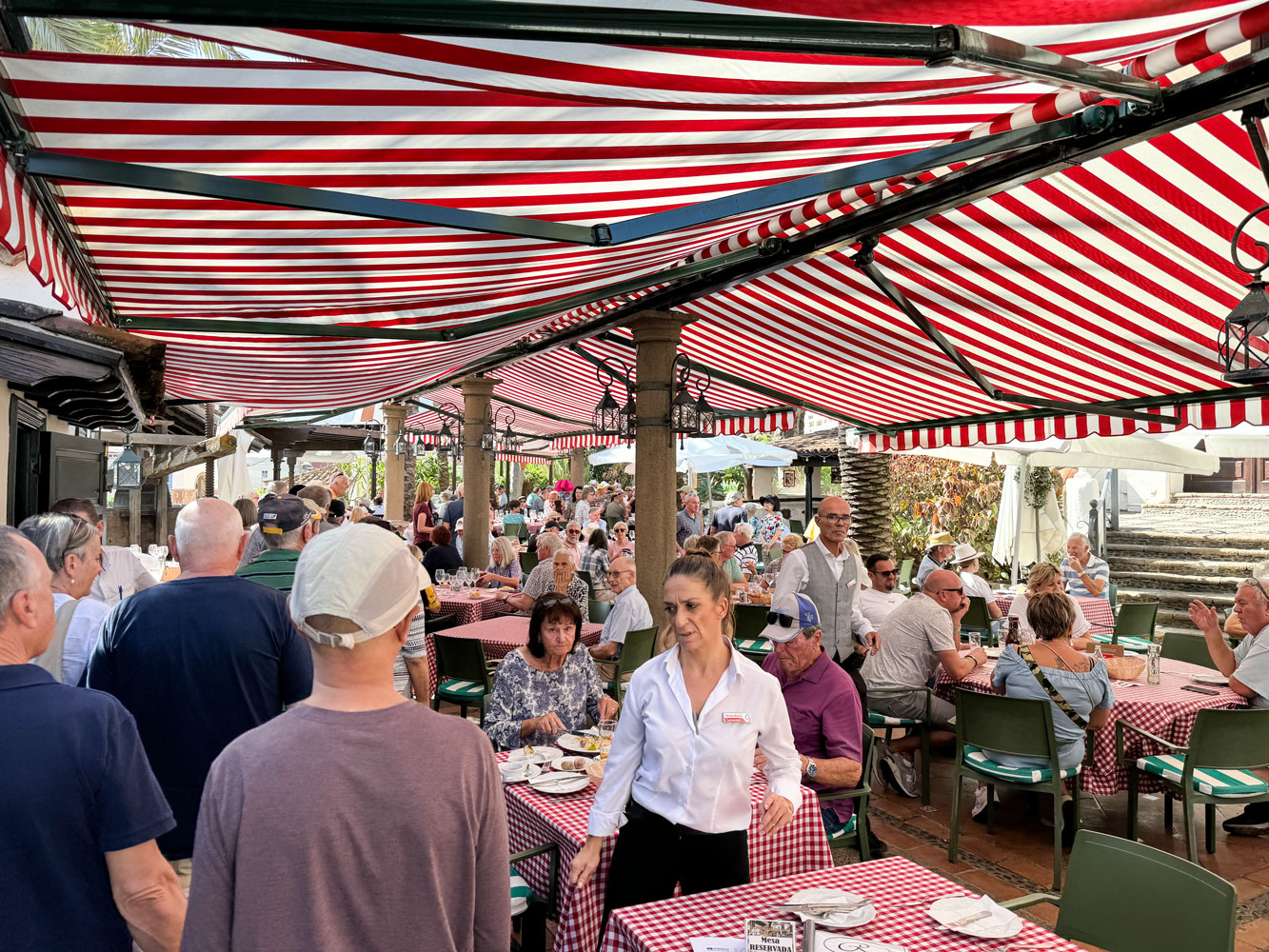
As we returned to the ship we passed the Auditorio de Tenerife. I was able to get a picture of it through the window of the bus, but this picture from Wikipedia is much better.
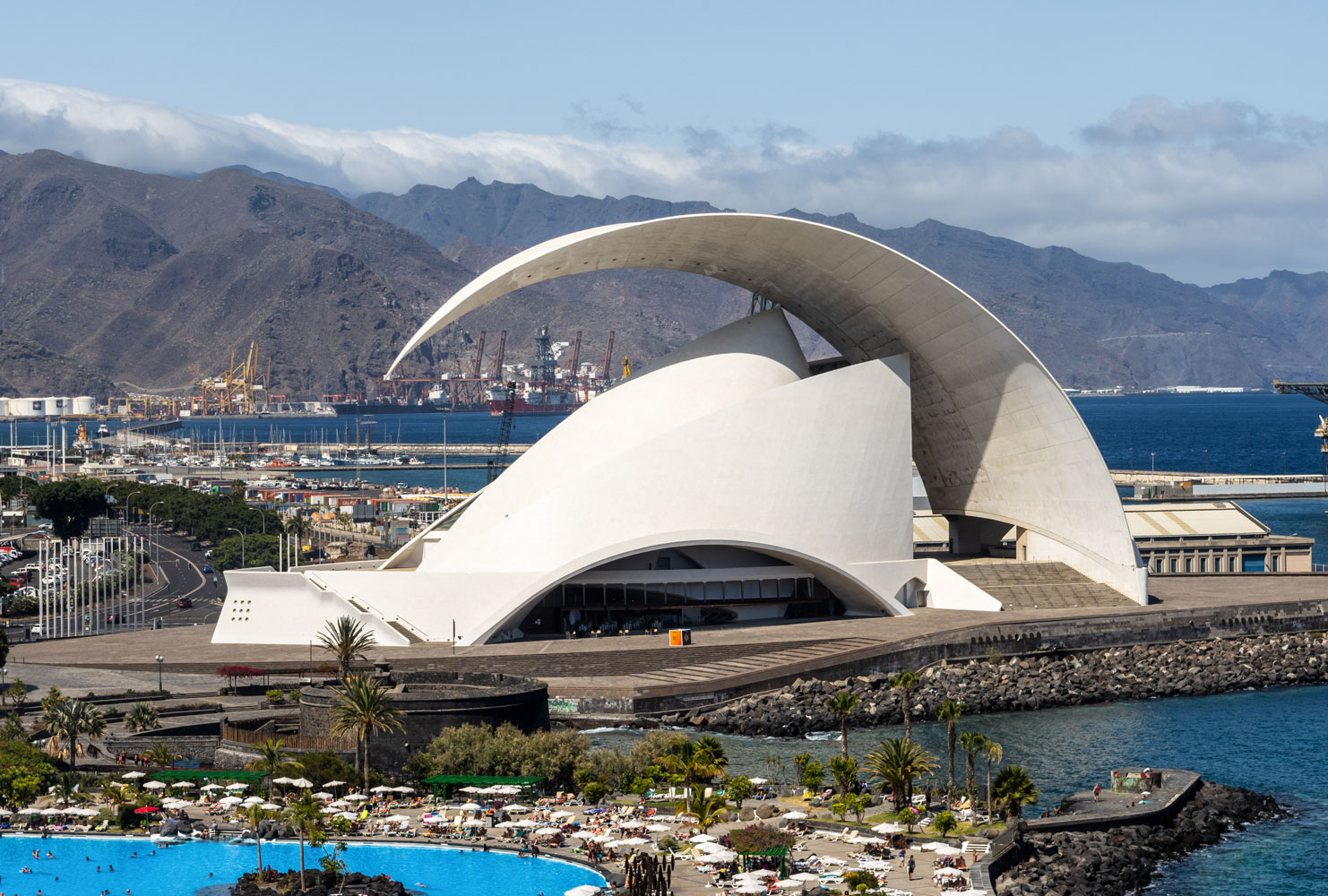
Here's a view of the interior. Pretty impressive.
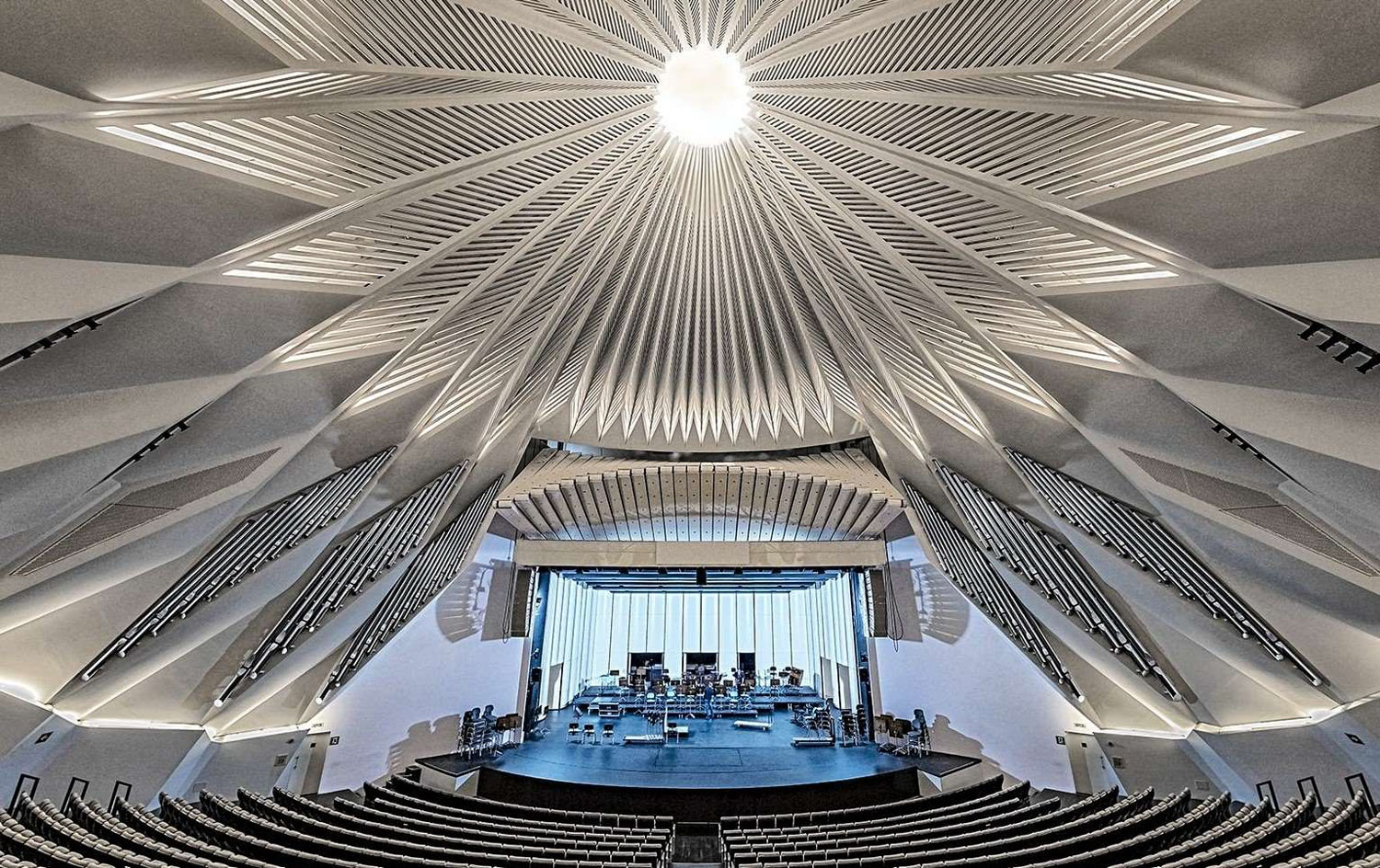
Overall, this tour was not that interesting.
That evening, Judy and I had dinner in the Compass Rose and were seated at a window. The fuel ship was next to the Voyager and we had a view of the refueling equipment for our dinner.
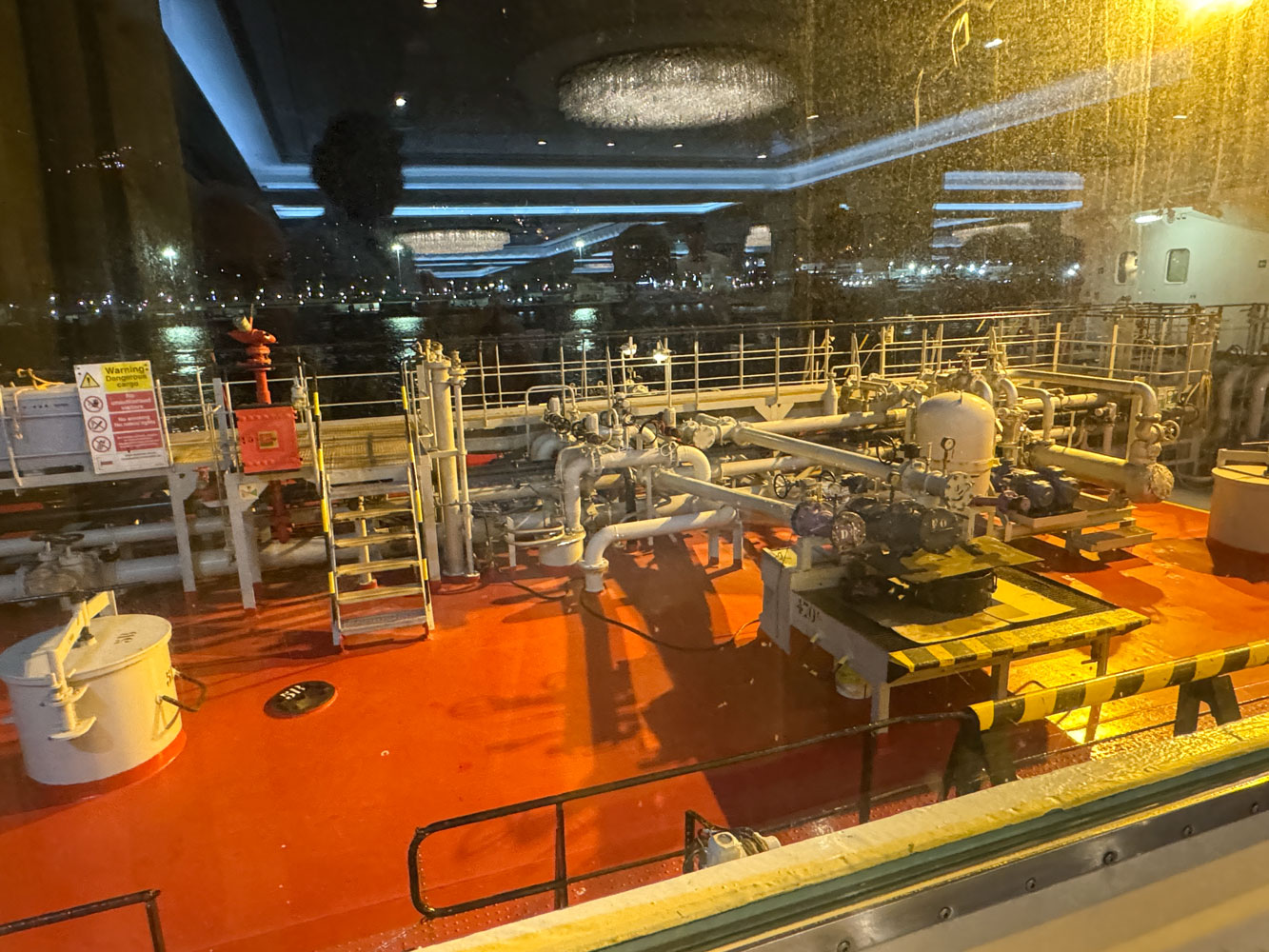
With that, I'll bring this segment of our trip to a close. We have two days "at sea" as we head to the Cape Verde islands.